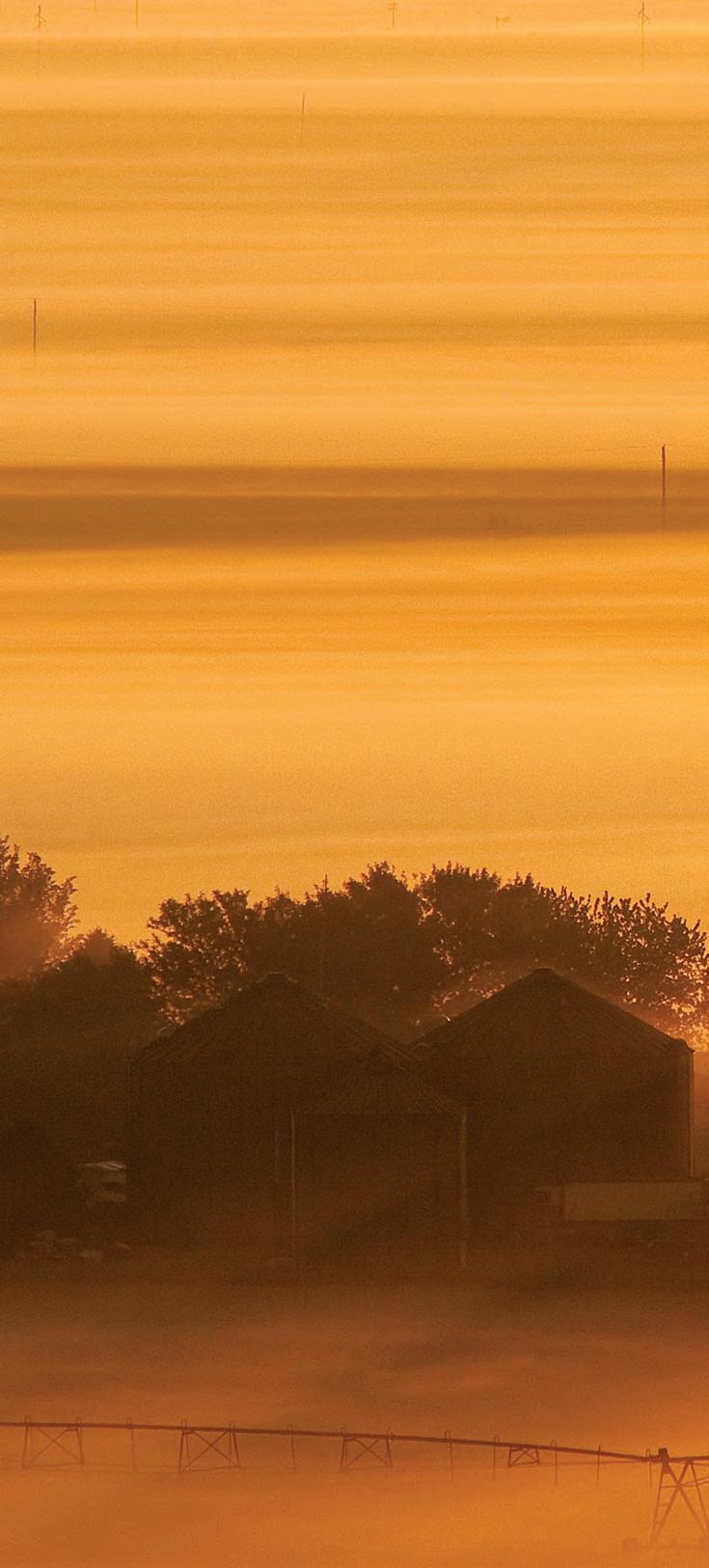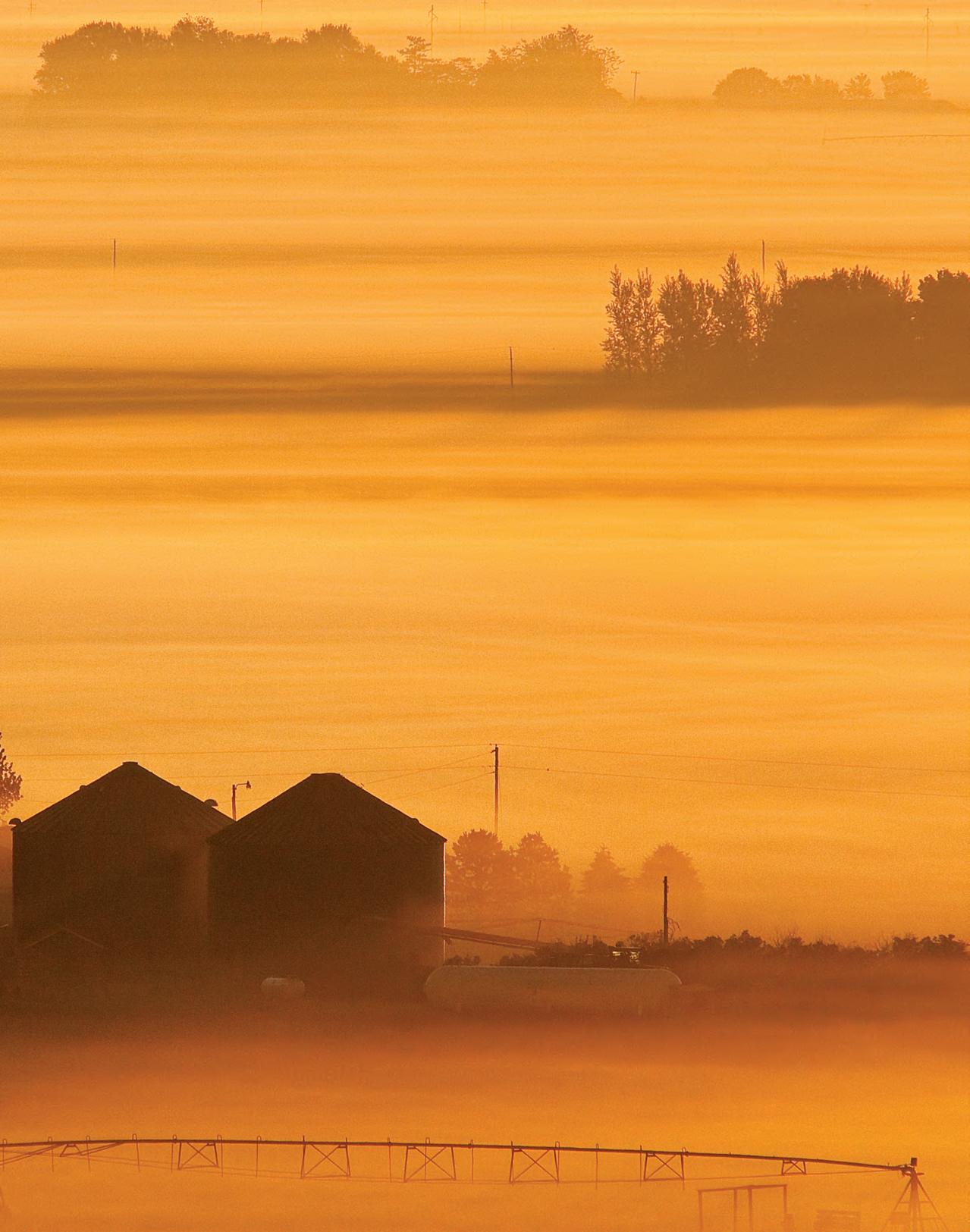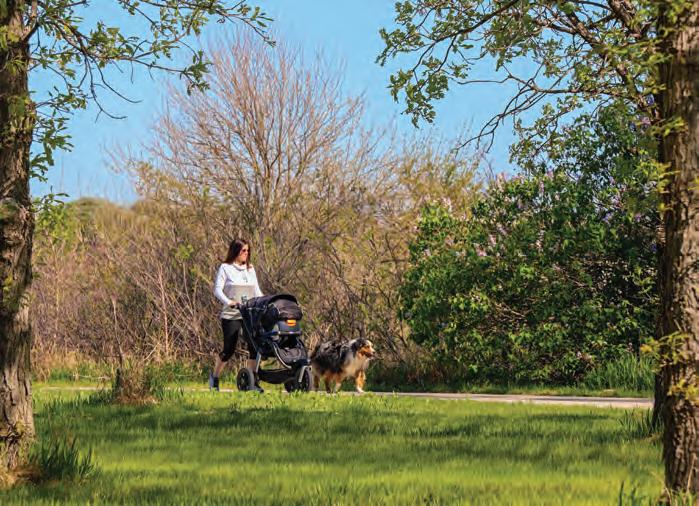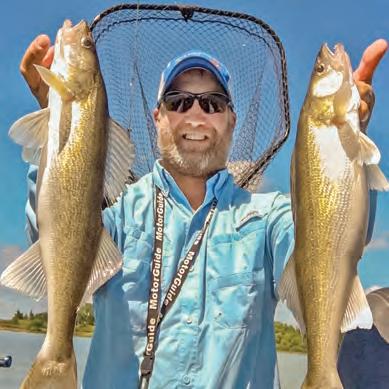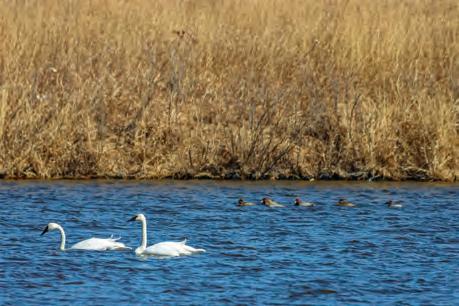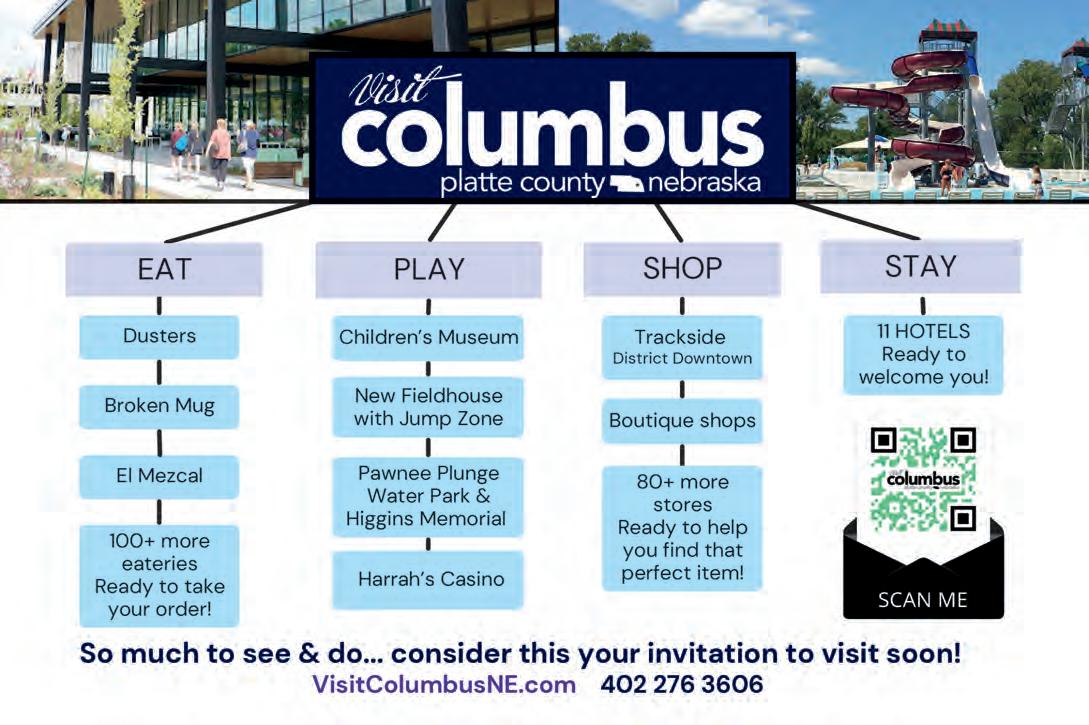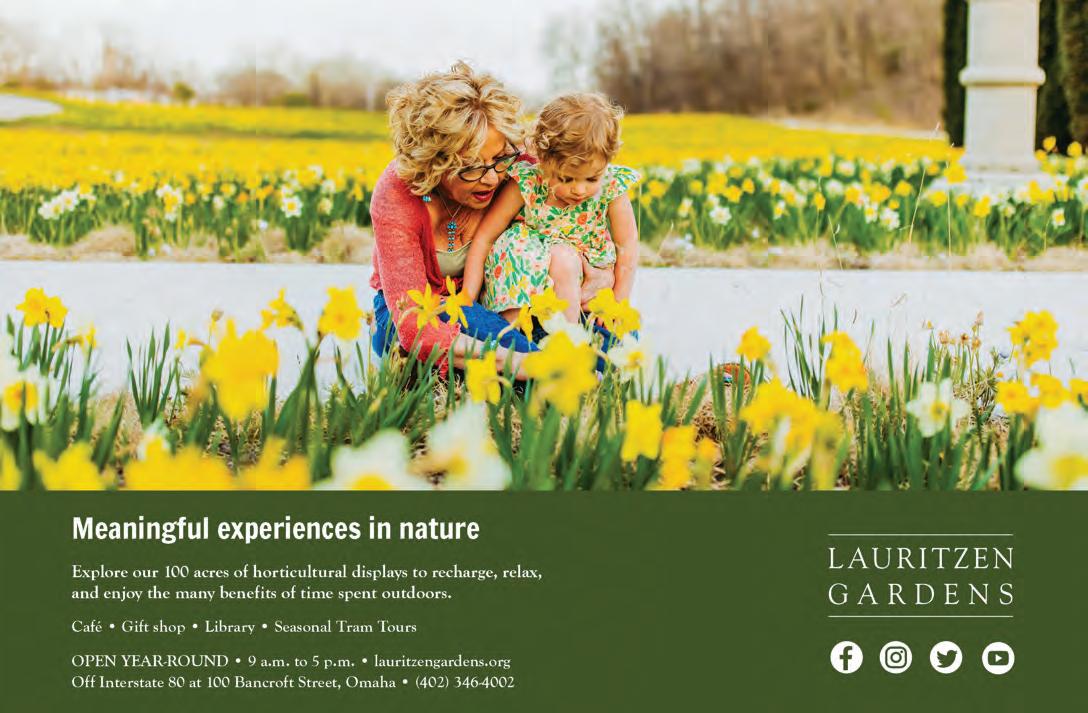
JULY/AUGUST 2024















JULY/AUGUST 2024













24 Sweet Prairie Hay
Twenty years of raking hay stirs up memories and traditions at an Ellsworth ranch. story and photographs by Nicole Louden
30 Here’s the Scoop
From classic flavors to new creations, these Nebraska ice cream shops serve up delicious frozen treats. by Alan J. Bartels
36 Dragstrip Diaries
Time slows down for 4-second runs as drivers line up to race at Kearney Raceway Park. by Cheyenne Rowe
54 Road Trip with Dennis
From Burwell to Crawford, a Nebraska road trip brings a friend home to his favorite hunting spot. by Janice Golka
68 Healing on Horseback
The horses at Heartland Equine Therapeutic Riding Academy in Gretna offer support, skills and training for participants with a range of abilities. by Tim Trudell
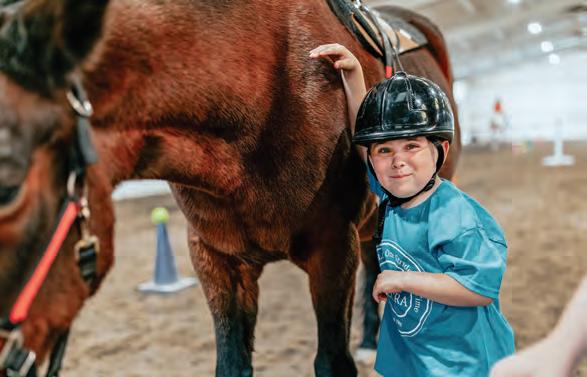
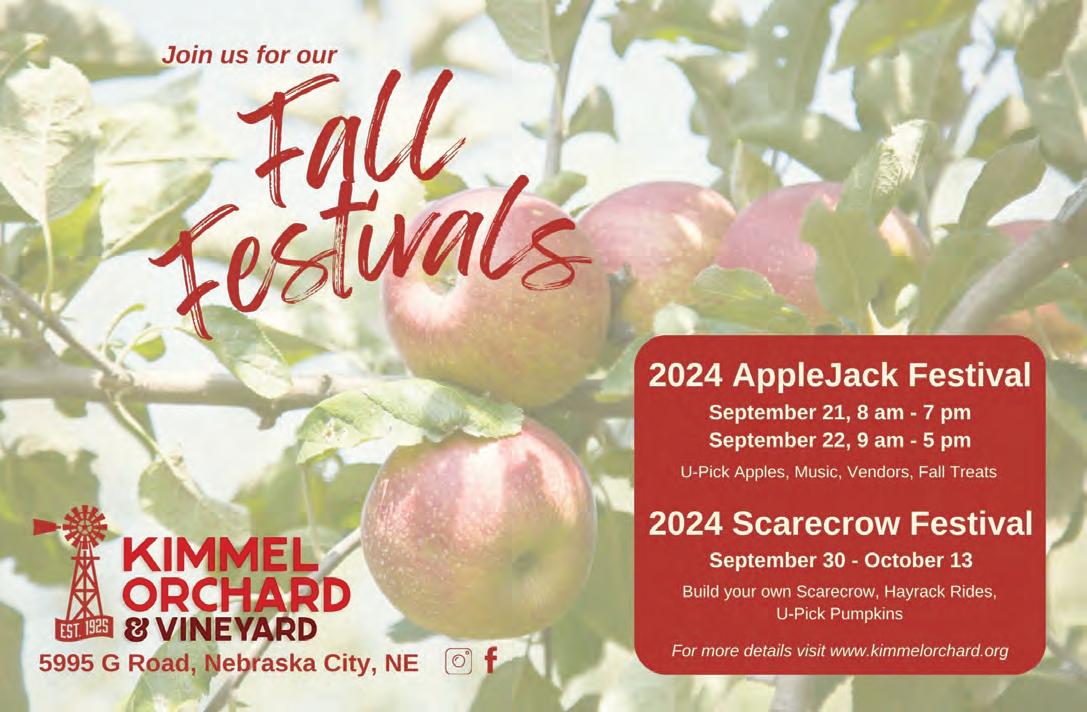
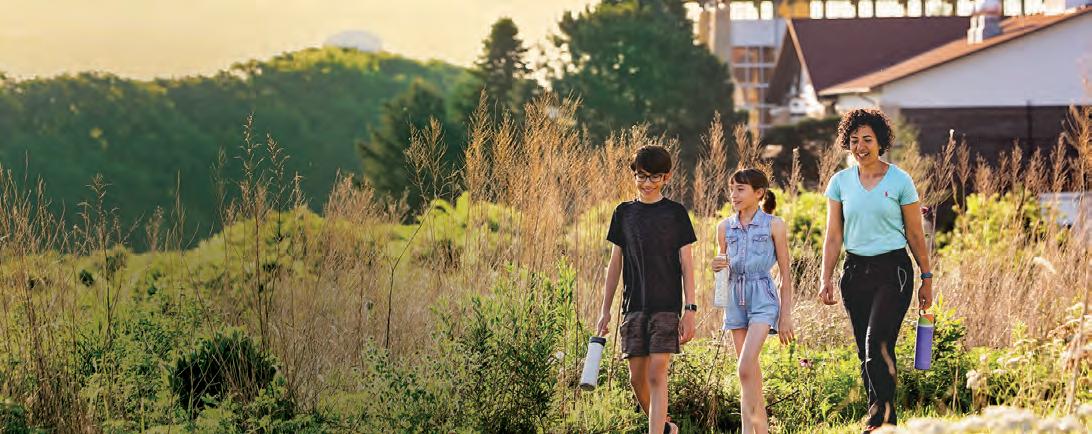
Discovery awaits at Arbor Day Farm. Whether feasting on local barbecue at Porter’s, exploring the one-of-a-kind Treetop Village®, or relaxing under the soaring timbers of Lied Lodge, there’s something for the entire family at Arbor Day Farm in Nebraska City.
Start planning your getaway at arbordayfarm.org.
Chadron pg. 14, 54
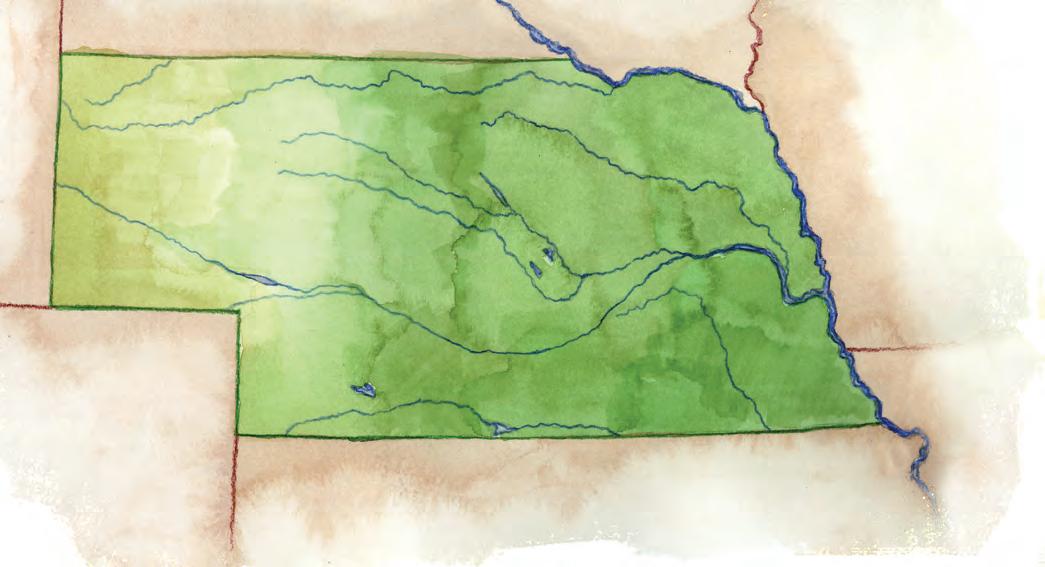
Valentine pg. 14, 54
Wood Lake pg. 30
Ellsworth pg. 24, 60
Ashby pg. 30
Potter pg. 30
Bassett pg. 54
Burwell pg. 30, 54
Ponca pg. 72
Ericson pg. 22
Scotia pg. 22
Dannebrog pg. 30
Kearney pg. 38
12 Mailbox Letters, emails, posts and notes from our readers.
14 Flat Water News
Chadron artist paints the town’s history; Roadside marker recalls World War II explosion; Valentine artist wins Nebraska Life award.
20 Trivia
Explore your knowledge of early Nebraska expeditions by Lewis and Clark. Answers on page 65.
22 Naturally Nebraska
Alan J. Bartels reflects on his many Nebraska firsts, including an unlikely run-in with poison ivy.
42 Museums
Big or small, these museums preserve Nebraska history and heritage for all to experience.
48 Kitchens
Fresh from the vine, liven up your summer meals and dinner parties with these cherry tomato recipes.
52 Poetry
Whether near or far, our poets reflect on what it means to call Nebraska home.
60 Traveler
Nebraska City celebrates all things apples; Durham Museum features a special exhibit on a television classic, Mutual of Omaha’s Wild Kingdom
72 Last Look
Photographer Derrald Farnsworth-Livingston captures morning fog and sunrays across the Missouri River valley.
Omaha pg. 14, 30, 60
Gretna pg. 70
Lincoln pg. 30
Nebraska City pg. 60
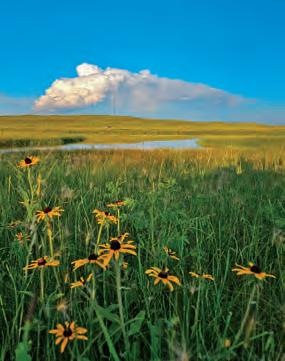
ON OUR COVER
Rolling clouds, expansive blue skies and black-eyed susans paint the sandhills of an Ellsworth ranch.
Story begins on page 24.
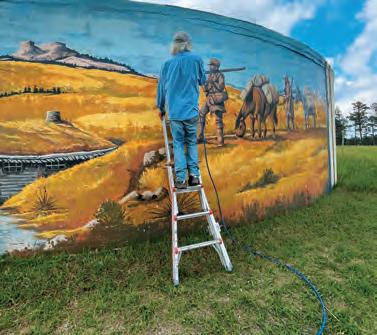

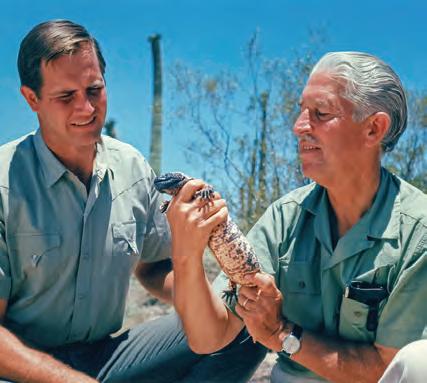
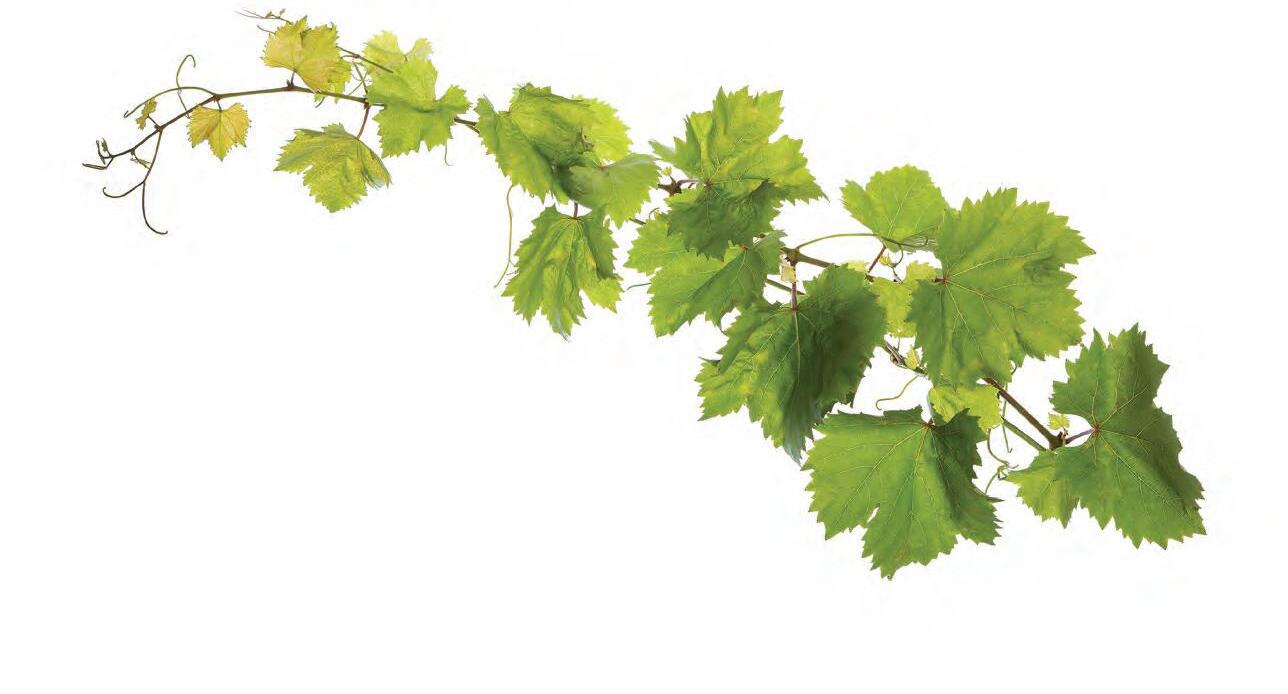
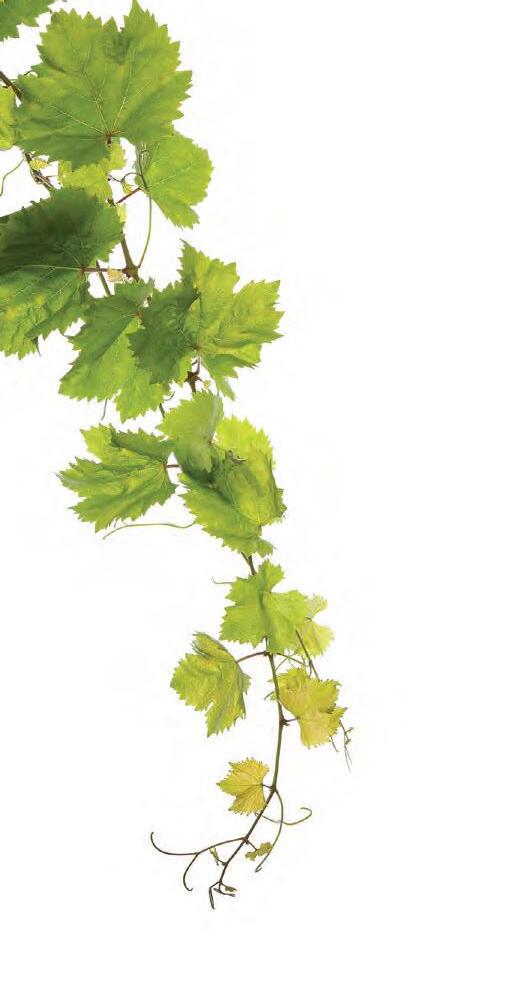
Labor Day weekend through end of October
Ready
Late September through end of October
the events section of our Facebook page for information on
2405 S Hwy 75 • Union, NE 68455 8 miles north of Nebraska City on Hwy 75

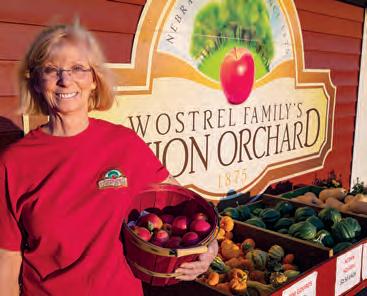
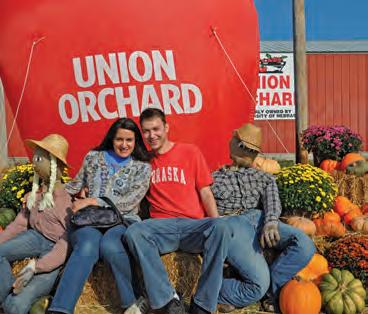
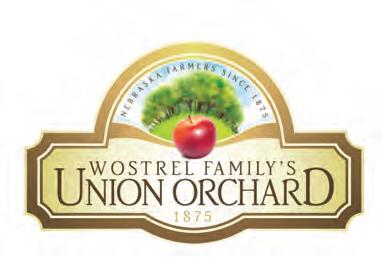

JULY/AUGUST 2024
Volume 28, Number 4
Publisher & Editor
Chris Amundson
Associate Publisher
Angela Amundson
Production Assistants
Victoria Finlayson
Lauren Warring
Design Jennifer Stevens
Mark Del Rosario
John Anton Sisbreño
Senior Editor
Tom Hess
Advertising Sales
Sarah Smith
Subscriptions
Carol Butler, Janice Sudbeck
Nebraska Life Magazine
c/o Subscriptions Dept. PO Box 270130 Fort Collins, CO 80527
1-800-777-6159 NebraskaLife.com
SUBSCRIBE
Subscriptions are 1-yr (6 issues) for $30 or 2-yrs (12 issues) for $52. Please call, visit NebraskaLife.com or return a subscription card from this issue. For fundraising and group subscription rates, call or email subscriptions@nebraskalife.com.
ADVERTISE
Advertising deadlines are three months prior to publication dates. For rates and position availability, please call or email advertising@nebraskalife.com.
CONTRIBUTE
Send us your letters, stories, photos and story tips by writing to us, emailing editor@nebraskalife.com, or visiting NebraskaLife.com/contribute.
COPYRIGHT
All text, photography and artwork are copyright 2024 by Flagship Publishing, Inc. For reprint permission, please call or email publisher@nebraskalife.com.



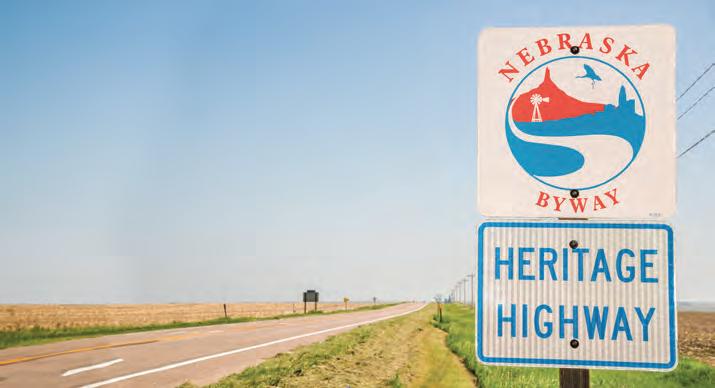




Traveling for living history
I worked at the Heritage Park on Saturday and a couple from Omaha stopped to have a tour. They shared that they had received their Nebraska Life (June 2024) on Thursday, read your “Living History” article and decided that the Henderson Mennonite Heritage Park would be their destination. They ended up spending 3 ½ hours at the park, while enjoying their storytelling tour with me as their guide. They had many questions and even offered some of their own personal stories of their ancestors.
Thank you so much for including us in your feature article. We have already felt its positive impact on our museum.
Suzanne Ratzlaff Henderson
An extra helping for Bruce
In answer to Bruce Felty’s request (Mailbox: “School lunch mystery”) in MarchMay 2024 issue, I make something that he might want to try. I do not have an “official recipe” for it.
I put a layer of sauerkraut/a layer of browned pork sausage, then top it with seasoned mashed potatoes. You can adjust the quantity to how much you want to make.
I use about 1/2 pound of sausage, 2 cups of sauerkraut and 2 helpings of mashed potatoes (I use mashed potato flakes prepared). Heat in oven until dish is heated through. This makes about a 9 x 9-inch pan; increase if you want to make more.
I put the sauerkraut on the bottom so the drippings from the sausage drip down onto the sauerkraut. My family loves this and I usually freeze one helping for my husband to eat later.
Marcia Keller Seward
Sunflowers through time
Nebraska Life has done it again by providing the stimulant for my memory. While perusing the June 2024 issue, there, on page 50, was a standout picture of a sunflower (“Good Life Poetry”). That did it!
Ninety years ago, my farm home was in Nebraska, sunflowers were considered a nuisance weed. They grew in the ditches

by the roads and in the building yards. We cut them with corn knives.
We first saw them grown commercially in South Dakota. One relative sold his crop to a company who packaged the snack food, sunflower seeds. There are other uses as well.
There is a flower garden on both sides of the chain link fence with our neighbors. Last year, he attached a 10-foot pole to the fence and planted a sunflower, and the blossom grew to the top.
This year, he has planted nine sunflower plants about one foot high. Three of them are growing by the pole. He is cleverly honoring my wife’s 90th birthday, one plant for each decade.
Lowell Broberg Puyallup, Washington
I have been subscribing to your magazine for many years now. The articles and the trivia are very interesting. I am the president of the Thayer County Historical Society, and also a son of Richard Reinke, founder of Reinke Mfg. Co.
In the January/February 2024 issue I

read the “Harvest of Ideas” article. It is not the first article to give Frank Zybach credit for inventing the pivot irrigation system, but I think more care should be taken before repeating information obtained from other articles.
There were at least five pivot irrigation patents issued prior to Zybach’s patent. They all describe moving a water pipe about a center point for irrigation. On March 23, 1914, James A. Norton, Odebolt, Iowa, applied for, and on Aug. 17, 1915, was granted patent #1150144 for an irrigation apparatus.
The patent drawings show multiple pairs of wheels supporting a pipe that is moved in a circle around a center pivot point. The description is “Watering arrangements making use of movable installations on wheels or the like movable around a pivot centre.”
Truly and honestly, it is James A. Norton of Odebolt, Iowa, who deserves the title “Inventor of Pivot Irrigation.” He had the idea 38 years earlier. The drawing on his patent is clearly a pivot irrigation system.
Bob Reinke Deshler
Send your letters and emails by Oct. 1, 2024, for possible publication in the next issue. One lucky winner selected at random will receive a free 1-year subscription renewal. This issue’s winner is Hank Schwartz of Falls City. Email editor@nebraskalife.com or write by mail to the address at the front of this magazine. Thanks for reading and subscribing!
Hatter over the moon
I love the “Cows” feature in the June 2024 issue (“When Cows in Hats”), and I have been overwhelmed by wonderful comments from subscribers and family/ friends alike! So, thank you to the Nebraska Life team (and Nicole Louden) for helping put together such a wonderful feature! It has been a great experience!
Audrey Powles Bingham
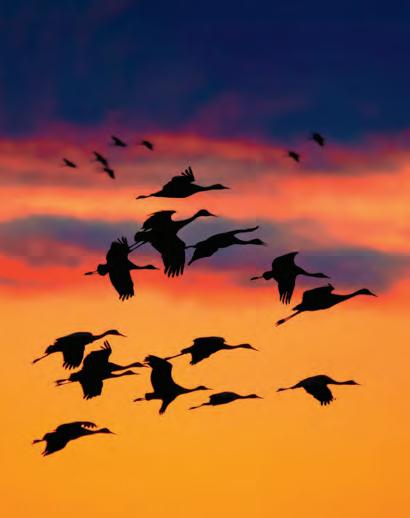
Salem speedsters
In the mid-1950s a clever man in California, Art Engels, attached a lawn-mower engine onto a low, light-weight frame, and the go-kart was born.
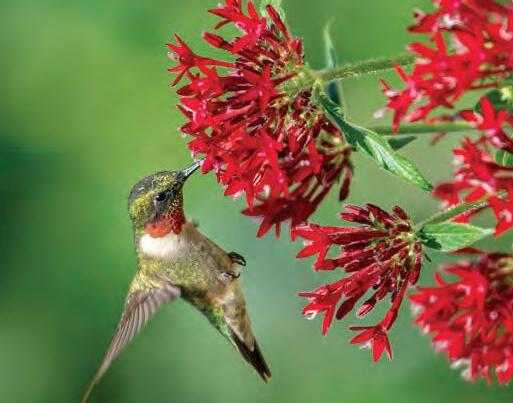
By the late ’50s and early ’60s, the racing craze of “go-karting” had spread to Nebraska. I was one of its early addicts, first welding the frame for myself, and eventually buying a commercial speedster. Our gear-head mentor of the community, Marion Boatman, had an oval dirt track bull-dozed into a parcel of farm ground just east of Salem, Nebraska.
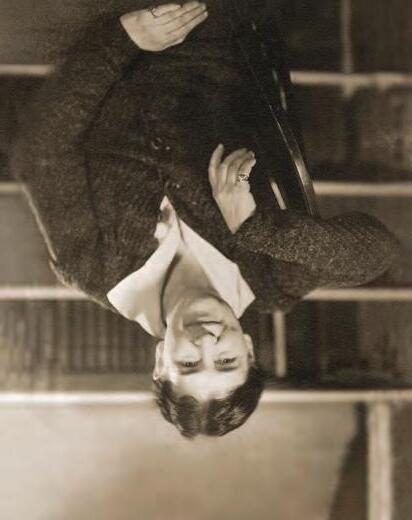
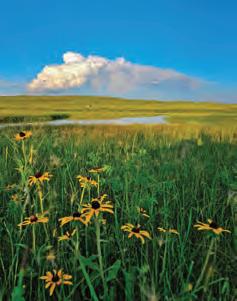
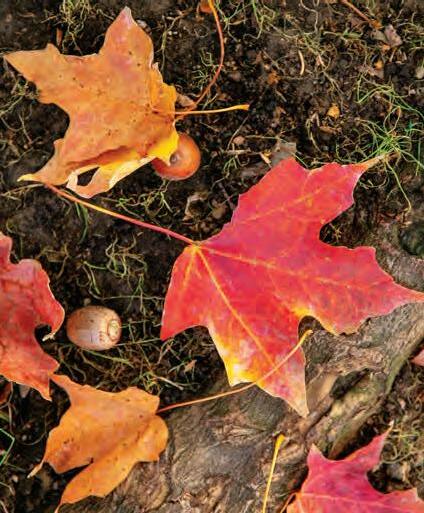
My premier kart was propelled by a McCullough 2-stroke engine. We ran without mufflers and were they ever loud, especially when about eight or 10 of them were buzzing around at the same time! We wore helmets and sturdy shoes to keep our feet firmly on the brake and the accelerator.
It was family fun with our wives and girlfriends competing in powder puff derbies. Even youth had their turns at the wheels, if their legs were long enough to reach the pedals. A concession stand catered to the karters, and a couple of yard lights lit up the scene below clouds of purple fumes. At the end of the fun-filled night, trophies were distributed (I still have five dilapidated ones after more than 60 years in my basement).
The sport didn’t last much beyond the ’60s in our area, and if you travel the highway east of Salem you won’t hear much now except the quiet rustling of corn stalks and the chirp of cicadas, but in the mists, I hear the wonderful memories of my go-karting years. (For the editor, sadly, I have no photos remaining of this special time of my life.)
Hank Schwartz Falls City
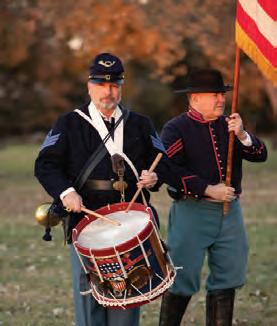
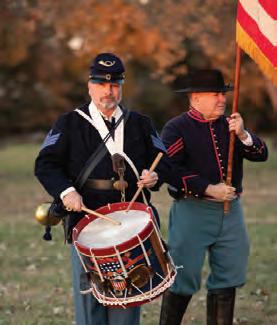
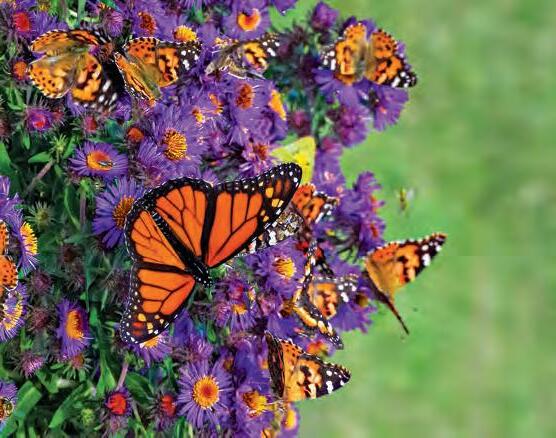

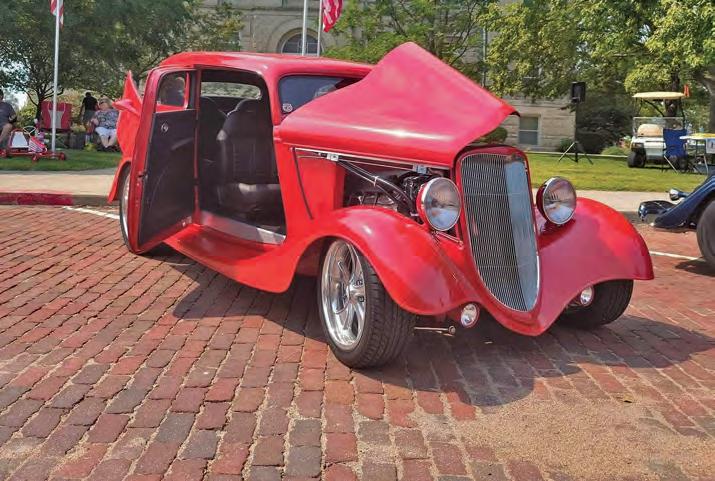

BY TOM HESS
Seventeen public murals in Chadron help highlight local and regional artists. The largest one tells the town’s origin story –the story of a fur trading outpost named for a French-Indian fur trader.
Chadron’s water tank depicts Native Americans and French traders approaching the James Bordeaux Trading Post es-
tablished in 1837 by the American Fur Co. The Museum of the Fur Trade stands on the original site on Highway 20. The fully reconstructed trading post is listed on the National Register of Historic Places.
It took Jerry “The Gov” Kathol three weeks painting the water tank – an unwieldly, 12-foot by 70-foot canvas. At age 70, he did have help with such a potentially perilous adventure.
Kathol’s friend Gabby Michna, director of the Chamber of Commerce, sat atop Kathol’s 2003 van, what she calls the “white egg,” projecting Kathol’s sketch onto the tank. The image guided his paint roller and brushes. To get the angles he wanted, Kathol drove the van through gullies and ditches – with Michna still on the roof.
Another Kathol mural, “Freedom of the
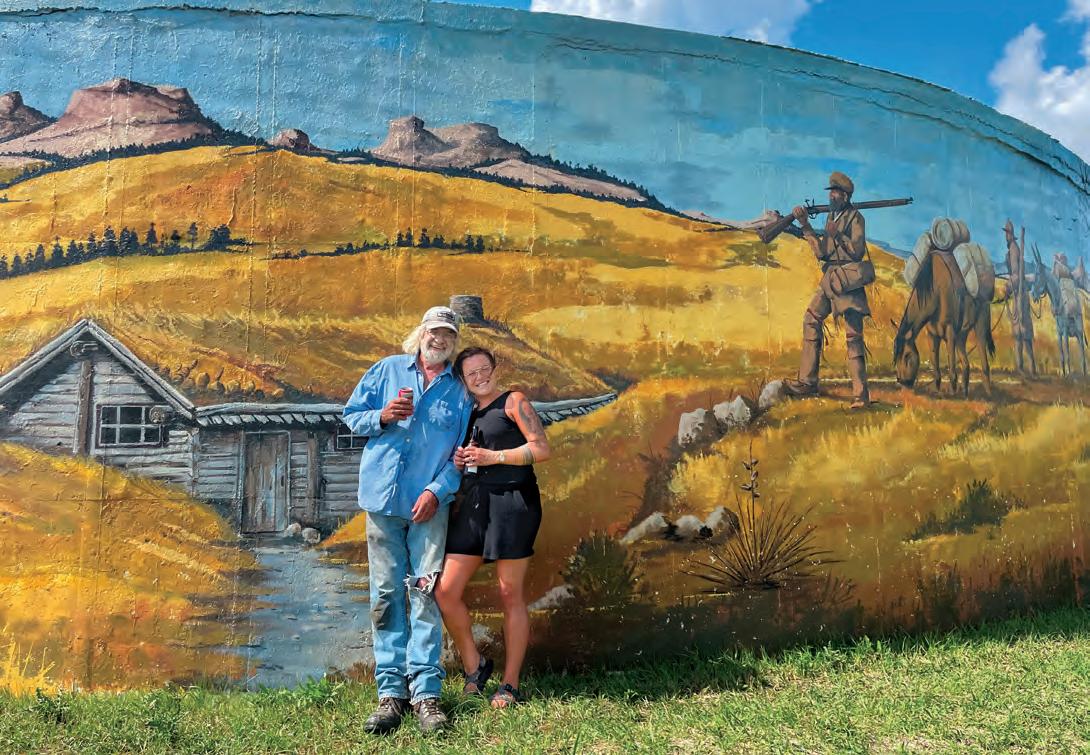
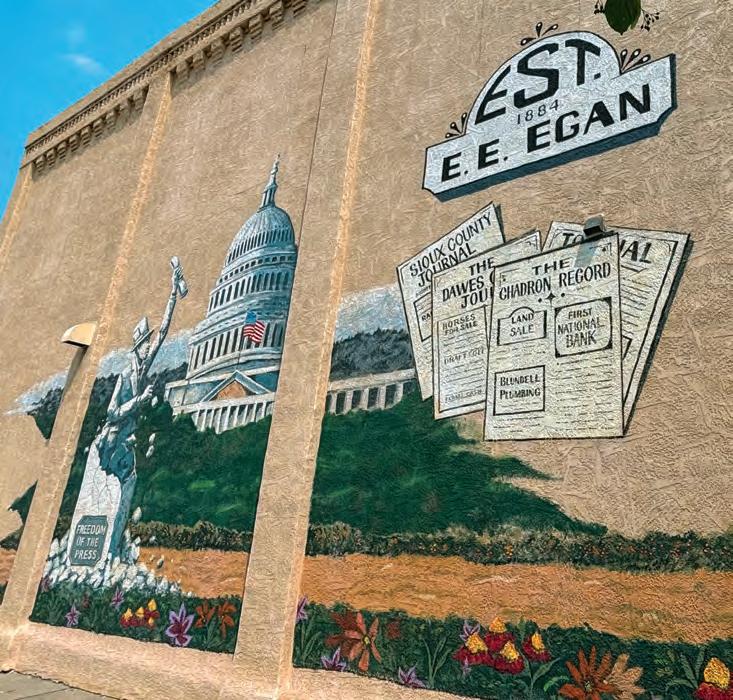
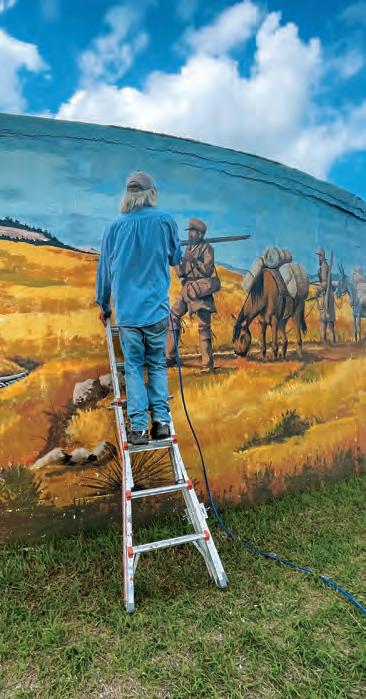
Press” is on the side of Chadron’s newspaper, The Record. The Record began in 1890, one of the state’s first. The mural portrays The Record’s predecessors, such as the Sioux County Journal, founded by an early settler, E. E. Egan, west of town in 1884. Egan wrote an account of the town and paper on the paper’s 25th anniversary in 1909. He wrote of contracting “Western fever” while migrating from Illinois.
Kathol’s murals flow from Chadron’s Art Alley project, which started west of Main Street between 2nd and 3rd streets. The project now includes 17 murals, and counting, as the community and local artists add new pieces to the town.
Kathol’s historical artwork appears inside businesses as well. His paintings hang alongside antelope trophies at the Bean Broker Coffee House and Pub. “Blackfoot Patrol” hangs at the 77 Longbranch Sa-
loon, a bar within Chadron’s historic Olde Main Street Inn. The scene depicts Blackfoot on horseback, riding through the Nebraska Panhandle. Jeanne Goetzinger, innkeeper and 30-year friend of Kathol, treasures his painting at the bar.
Kathol began his art career at a young age on a much smaller scale, in northeast Nebraska’s Bow Valley. His mother liked drawing with pencil, so his handyman dad, a blacksmith, created a white-slate table that she and the children could draw and write on, and wipe it clean for the next day. His dad later gave him a guitar; a brother took it to play in a band, but Kathol didn’t give up music. He became a fan of Midwest troubadours – Woody Guthrie of Oklahoma, Guthrie’s protégé Bob Dylan of Minnesota, inspired him.
Kathol sometimes joins a jam session at the saloon, playing three-cord country
songs using his guitar or harmonica. An Olde Main crowd favorite of Kathol’s is “Dear Abby,” by John Prine, favorite son of Illinois.
Dear Abby, dear Abby
My feet are too long
My hair’s falling out and my rights are all wrong
My friends they all tell me that I’ve no friends at all
Won’t you write me a letter, won’t you give me a call.
Like his audience, Kathol identifies with the narrator of Prine’s song. Kathol retired from Nebraska roadway work at age 61, having blown out both knees. He dedicated himself to his jam sessions, painting and a garden that deer, rabbits and ducks often invade.
His hair’s falling out, but he hasn’t given up music or painting.
BY TOM HESS
Along a remote portion of the Mari Sandoz Trail in Sheridan County, far from services like gas and food, is a historical marker recalling an explosive event: the detonation of a World War II Japanese bomb in Nebraska.
After the Doolittle Raid on Tokyo in April 1942, Japan began developing hydrogen-filled paper balloons equipped with four incendiary devices and an anti-personnel bomb meant to ignite forest fires and kill civilians. The first balloons launched on Nov. 3, 1944, reaching the California coastline in two days.
Japan launched about 9,000 balloons to travel over 5,000 miles across the Pacific Ocean to North America. There were nearly 300 reported incidents in the U.S. as balloons traveled across the continent as far east as Michigan. One balloon struck electric transmission lines, cutting power to the Manhattan Project’s Hanford plant in Washington State, which later produced the atomic bomb that the U.S. dropped on Nagasaki.
The balloon bomb that exploded above western Nebraska’s Mari Sandoz Sandhills Trail – about 15 miles north of Ellsworth on Nebraska State Highway 27 – caught the eye of a local witness on Feb. 22, 1945. State Historical Marker 505 tells of a rancher who saw “an orange ball with the sun shining on it ... As we were watching, it turned into a cloud of smoke and went to the ground.”
Another balloon reached eastern Nebraska in Omaha’s Dundee neighborhood. On April 18, 1945, a balloon exploded over the intersection of 50th and Underwood Avenue. A plaque between eCreamery and Dundee Bell marks the site of the blast.
So that Japan would be unable to gauge the effectiveness of its campaign, the U.S. government adopted a policy of silence in response to balloon sightings, and in April of 1945, reported incidents began to decline. On May 5, 1945, six Americans
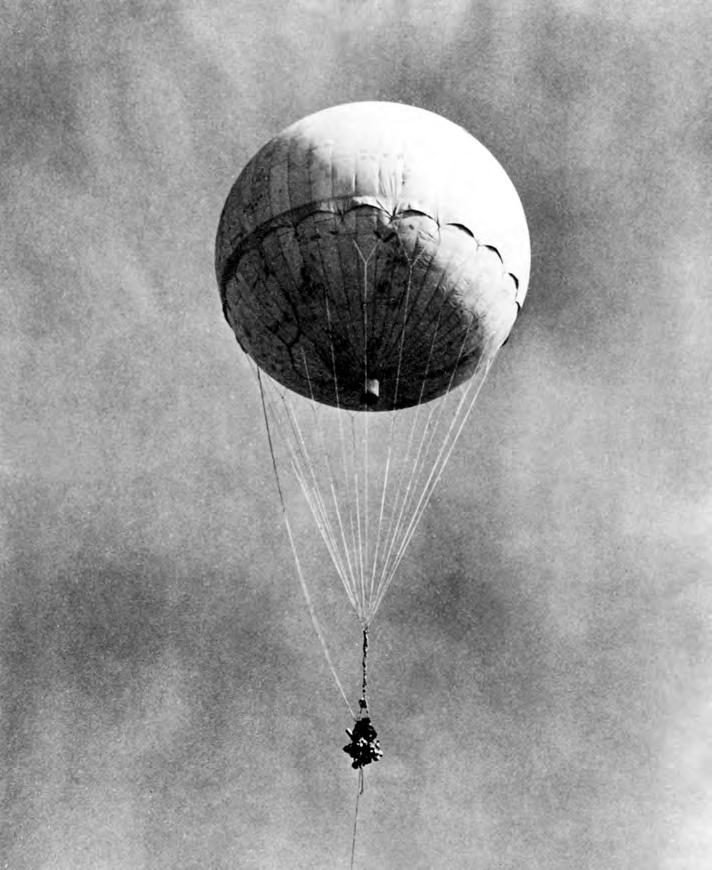
died from a balloon blast after finding an unexploded balloon in a forest near Bly, Oregon – the only U.S. casualties from the balloons. On Sept. 2, 1945, Japan surrendered, marking the end of World War II.
Though the blasts in Nebraska caused no damage or loss of life, they mark World War II’s far-reaching impact. Even in the heartland, the war’s influence extended beyond the battlefield, affecting communities across the continent.
In retaliation for an U.S. attack on Tokyo, Japan sent balloon bombs over America. One of them exploded over the Sandhills.
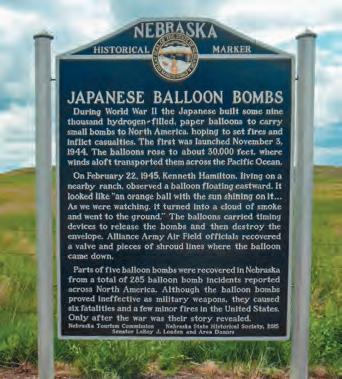
BY LISA TRUESDALE
Like any kid growing up on a ranch in rural Nebraska, David Dorsey has always loved exploring the outdoors. Finding empty bird nests was definitely a special treat.
When he found such a nest a few years ago, he was just as fascinated with it as he had been decades ago. So Dorsey, who left full-time ranching in Rock County 12 years ago and moved to Valentine to pursue a career as a professional artist, decided to incorporate the nest into a new painting.
“The Empty Nest,” a light-filled acrylic painting featuring his great-niece Jessa reverently cradling the nest in her hands, received the Nebraska Life Art Award at
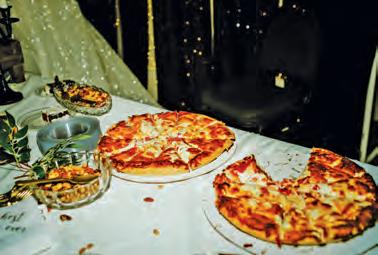

“I wanted to do a painting that was a little different, something out of my normal zone, based on the idea of an empty nest,” Dorsey said. “I think there are times when we all yearn to be outdoors and free but find ourselves confined and removed from nature.”
Dorsey said his love for the land and the people who farm and ranch in the state is influential in his work, whether he’s depicting a contemporary scene or a classic representation of the Old West. “I love to capture the faces and daily lives of these hard-working individuals who call the plains region home,” said Dorsey, whose family settled in Nebraska before it was even a state. “Each face has a story to tell, and it’s a challenge and a pleasure for me to tell those stories through my art.”
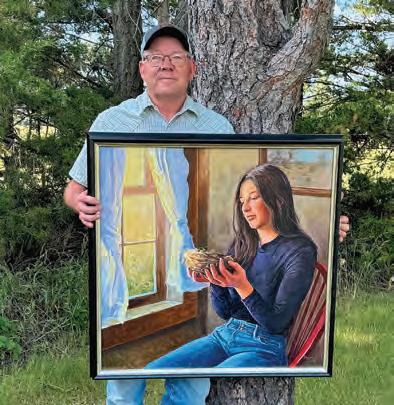
Dorsey’s works are on display at Humdinger Boots and Janine’s Flower Exchange in Valentine. They can also be viewed on his website (daviddorseyart.weebly.com) and his Facebook page (David Dorsey).

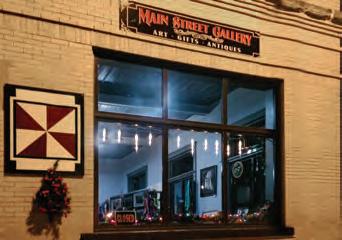

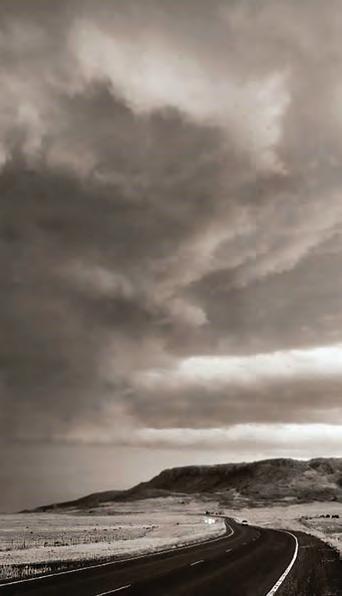


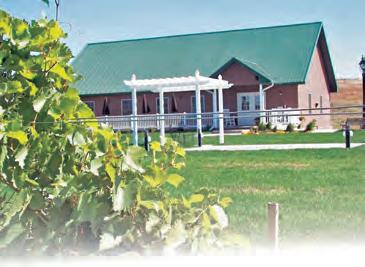
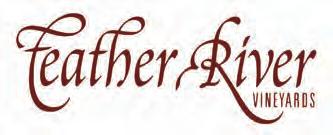
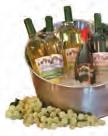

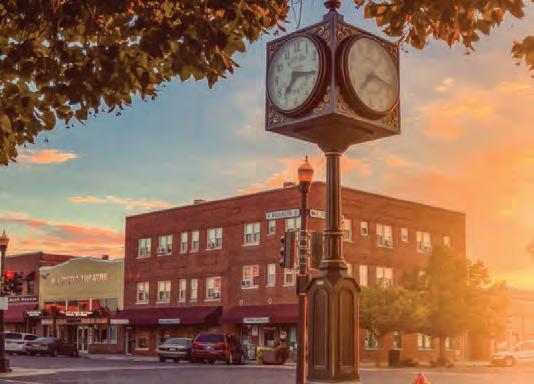




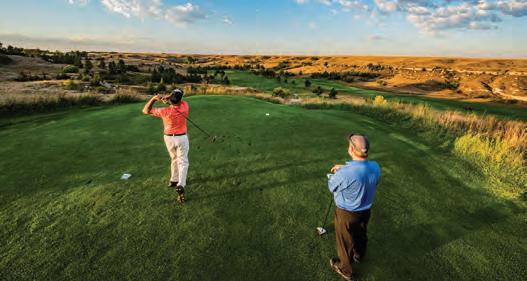
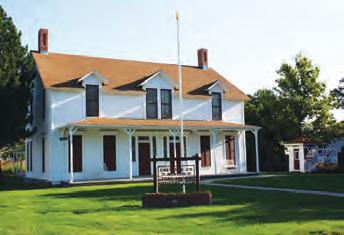

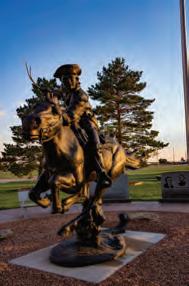
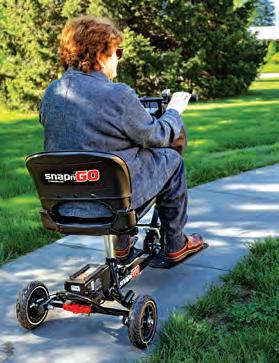

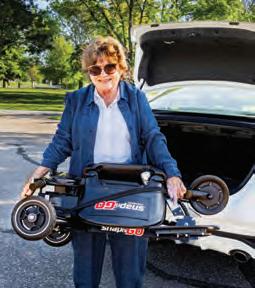



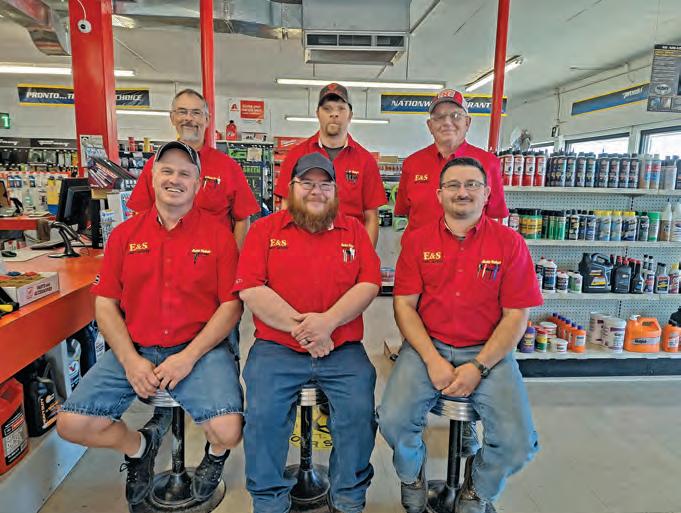

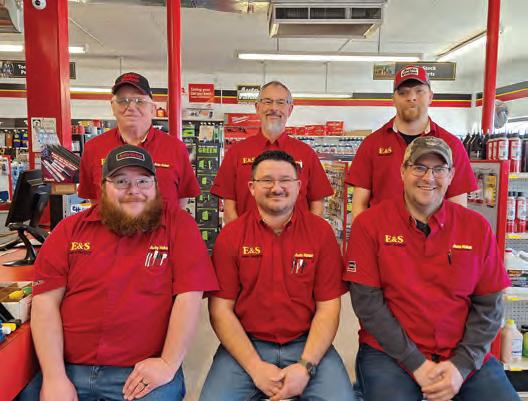
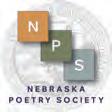

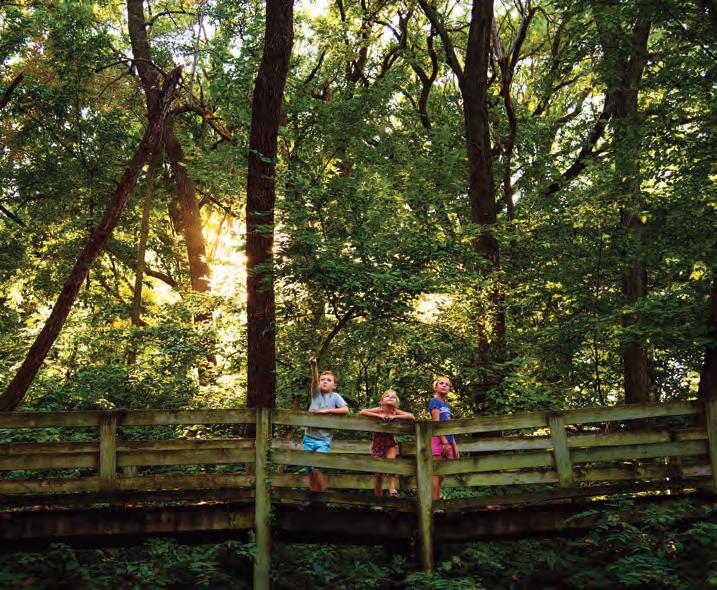
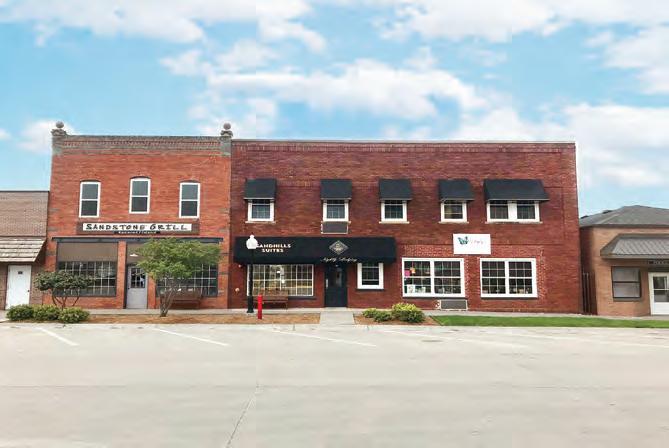
The Lewis and Clark Scenic Byway runs from Omaha to what city in northeastern Nebraska? The city is named for its location relative to a city in Iowa, close to where Nebraska, South Dakota and Iowa meet.
What village features the Captain Meriwether Lewis, a historic dredge turned home of the Museum of Missouri River History? A marker in the village indicates that the expedition camped nearby in July of 1804, and its name is like a city in Texas.
An exhibit at Nebraska City’s Missouri River Basin Lewis & Clark Visitor Center discusses Lewis’s dog, Seaman, who was what breed? Like a Labrador, the name of this breed can be found in the name of a Canadian province.
4
Shortly before following the Missouri River into South Dakota, the expedition stopped by Old Baldy, a hill where they encountered what type of animal? They sent a living specimen to President Thomas Jefferson, and Lewis referred to them as “barking squirrels.”
5
Wausa is one of several municipalities featuring a wooden sculpture of what member of the expedition? He got separated from the pack for 16 days somewhere around modern-day Ponca State Park.
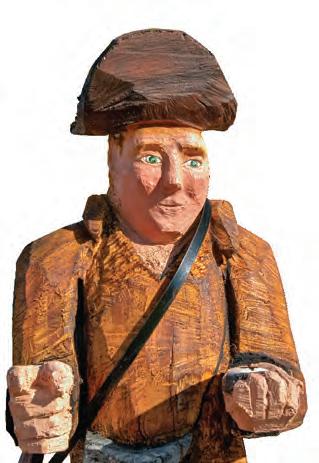

6 Fort Calhoun is home to the Fort Atkinson State Historical Park, which served as the location of the first-ever formal meeting between a western indigenous tribe and representatives of the U.S. government.
7 Bow Creek carries great significance for the expedition, albeit in a bad way: It’s where Lewis got shot. Evidence seems to indicate that Private Pierre Cruzatte did it, though this has never been proved definitively.
8 Lewis and Clark passed through Fontenelle Forest in Nebraska. They named the forest because the ground there was softer than in the surrounding area, reminiscent of a fontanelle – a soft spot on a baby’s head.
9 Mulberry Bend is an interesting part of the Missouri River that Lewis and Clark didn’t examine. Per the National Park Service, Mulberry Bend came into existence due to flooding in the late 1800s, though the expedition did inspect the land pre-bend.
10
While the word is indigenous in origin, the name “Nebraska” is credited to William Clark.
11
Now found on the reservation of the Iowa Tribe of Kansas and Nebraska, what southwestern locale did Clark hypothesize was a burial ground? Later archaeological research has indicated that Clark was correct –the site was used by the Oneota.
a. Hopper Site
b. Leary Site
c. Miller Site
12
What abandoned town lends its name to a “volcano” Lewis and Clark allegedly encountered on their journey? Although it is listed as a High Potential Historic Site along the Lewis & Clark Trail, a 2011 article suggests they visited a different spot closer to Maskell.
a. Corinthia
b. Doria
c. Ionia
13
Finished in 1957 and sitting on the Missouri River, the Gavins Point Dam holds back Lewis and Clark Lake. The lake lies on Nebraska’s border with what state?
a. Iowa
b. Missouri
c. South Dakota
14
Located northwest of Decatur, Lewis and Clark visited a landmark now known as Blackbird Hill. Why is it called Blackbird Hill?
a. An Omaha leader known as Blackbird is buried there
b. Blackbirds regularly nest on the hill
c. Clark wanted to call it “Blackberry Hill” and Lewis misheard him
15
Two towers rising 210 feet above the Missouri River support the Bob Kerrey Pedestrian Bridge, which connects Iowa to Lewis & Clark Landing in Nebraska. How deep are the tower piles below the river?
a. 25 feet
b. 80 feet

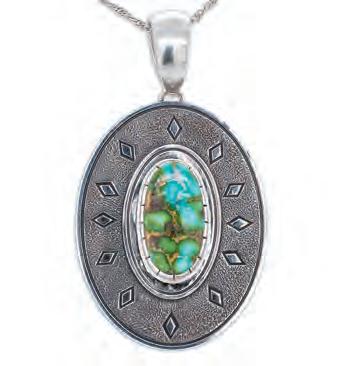

No peeking, answers on page 65.
c. 210 feet
by ALAN J. BARTELS
LAST YEAR I WROTE in this column about how I’d drawn a Nebraska cow elk tag. Getting that permit was a surprise since I had never even applied for an elk tag before. Ultimately, last November, I harvested my first ever elk. When I think back on that landmark experience, I begin remembering other important firsts that I have experienced outdoors in Nebraska.
I was fishing a small farm pond near Scotia when I landed my first-ever largemouth bass while using a lure. The late Dick Ackman of Greeley had loaned me an antique crankbait that day, and I am thankful that I didn’t snag it on a log somewhere in the murky depths. Dick gifted that lure to me, and I cherish it today. He passed away earlier this year.
I can tell you when and where I caught my first northern pike and where and how I harvested my first mallard duck. The flavor from the first time I ate morel mushrooms sticks in my memory, and I still remember when my family and my daughter’s friends found a half a grocery sack full near Elba (that mushroom spot hasn’t been that good since).
Teaching myself to deer hunt in my late 20s came with some stress. I felt a lot of pressure to feed my young family both through my job and my time outdoors. In my mind, the cost of the hunting licenses, habitat stamps, equipment, fuel and other necessities should have been offset by me bringing home a large-bodied deer for the freezer. I hunted four deer seasons before bagging my first one. It isn’t only that first deer harvest that sticks with me.
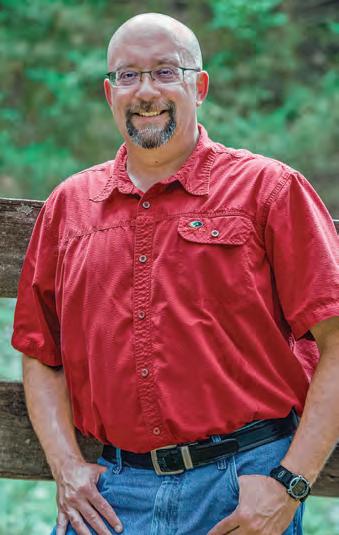
I was hunting with good friends on my first visit to the Nebraska National Forest near Halsey, and we’d rented the Willow cabin at the Nebraska State 4-H Camp. Times change, and friendships can, too. I haven’t hunted with Craig and Art in many years. And the 4-H camp and the cabins were destroyed by a wildfire in 2022. None of that diminishes my memories of those important firsts.
Some firsts aren’t as cherished. One winter day I noticed a rash on my forearms that itched so bad that I went to see our
family physician in St. Paul, Dr. Matthews.
I challenged Doc when he told me I had poison ivy, reminded him that it was winter. With a knowing smile on his face, Doc asked if I’d been outdoors lately. Yes, I’d been fishing at Lake Ericson a week earlier after being coaxed outside by a very mild January day. He told me that brushing against dried up poison ivy plants can produce the same results as haphazardly traipsing through the woods in spring, summer or fall. I’d never been bothered by that plant before. But since that first uncomfortable experience, I don’t even have to touch the plant now to come home with a few itchy bumps.
I believe that most firsts – the good, non-itchy ones anyway – come more often as the result of dedication, discipline and hard work. This applies to all aspects of life.
My successful elk hunt was over the first morning of the three days I had planned to hunt. That left my best friend and me two and half days for a bunch of firsts.
He’d never seen Scotts Bluff National Monument – check. Chimney Rock –check. Fort Robinson State Park, yep, his first time there, too. And he caught his first trout, (thanks to my expert advice, of course) in the Nebraska National Forest pond at Halsey.
Those firsts almost never happened for him, for us. Cancer almost took my friend, Shane, but he’s now been free of the disease for more than three years.
So, when it comes to our firsts in the outdoors, these won’t be our last. Not even close.
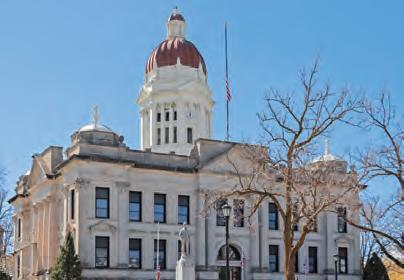



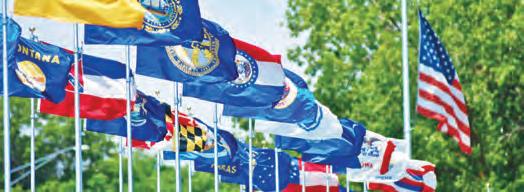


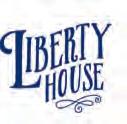
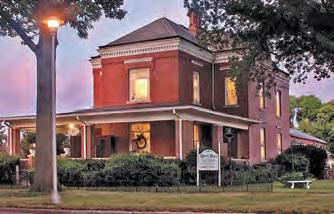
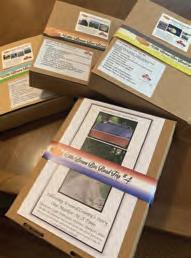
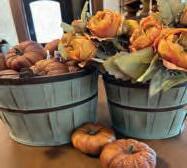
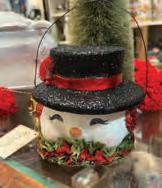
Located East of Seward on Hwy 34
• Display features 50 states flags, five military branches, and POW
• Donated pathway by Don and Barb Suhr connects to the nearby trail with five territory flags.
• Flags lit at night for spectacular viewing opportunity
• Entire display is handicap-accessible and open year round
• Additional donations to assist with maintenance would be greatly appreciated
Made possible by the Seward County Visitor Bureau
For more information or to donate contact: Seward Kiwanis Foundation • Attn: Marv Taylor c/o Parade of Flags PO Box 245 Seward, NE 68434



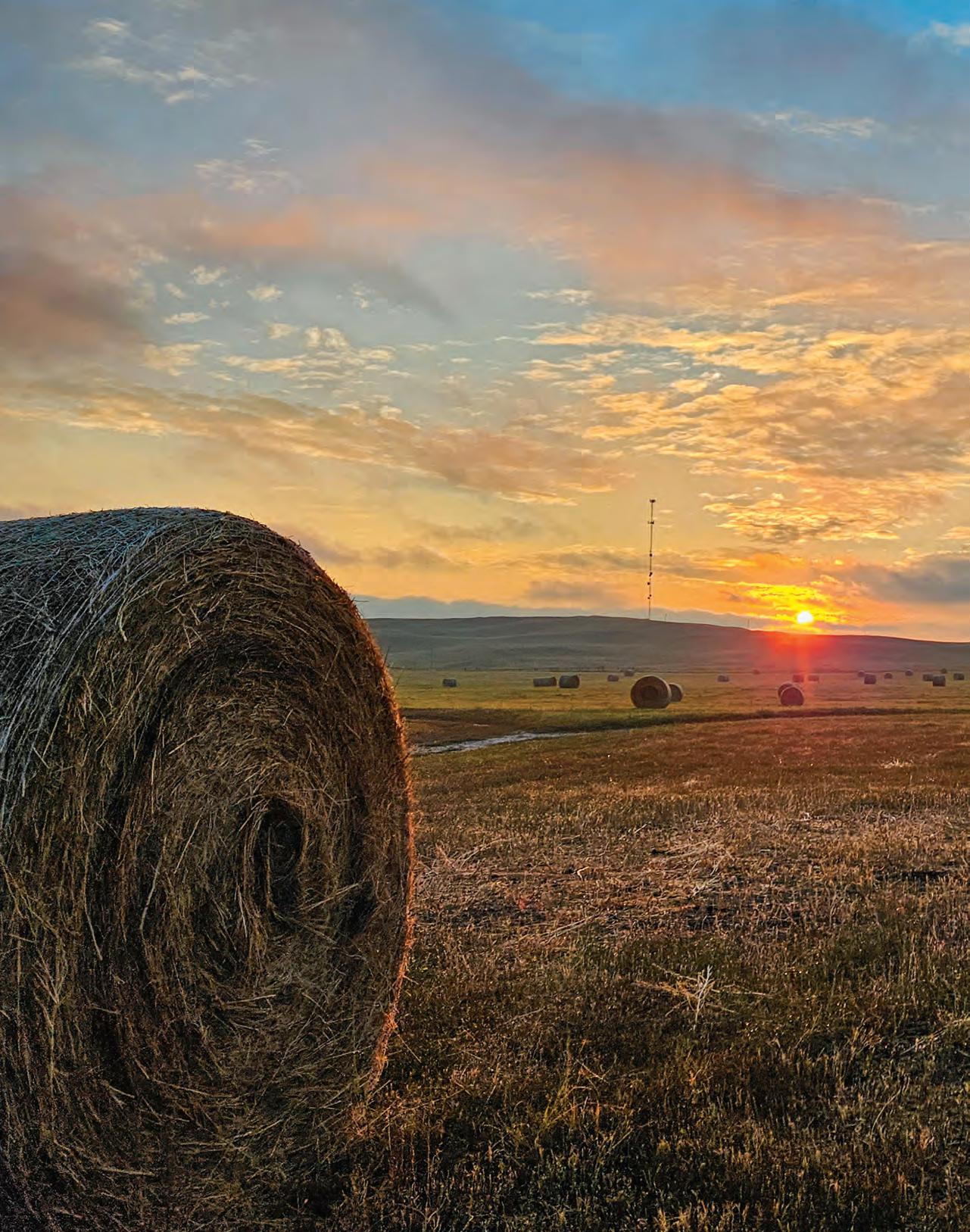
story
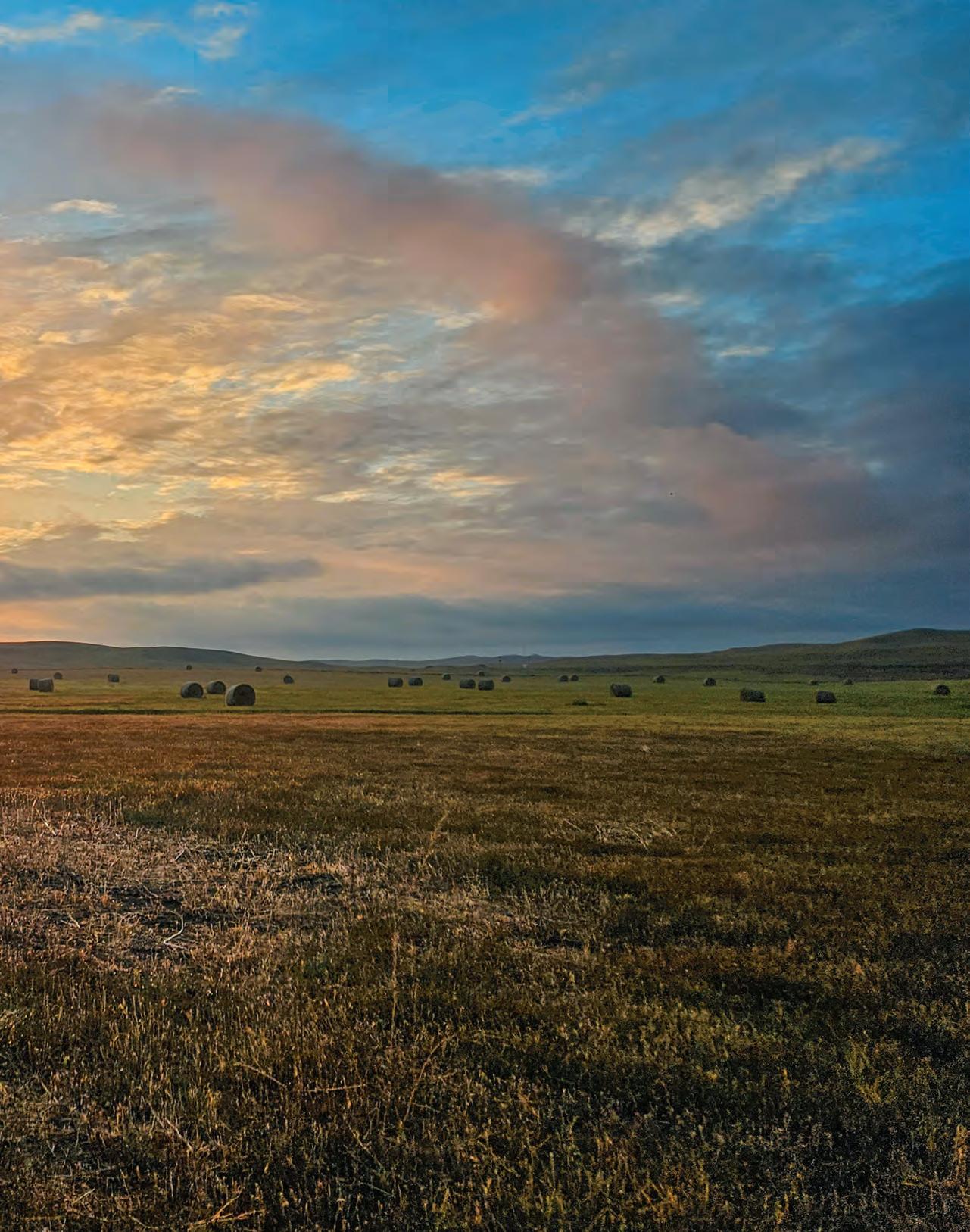
by NICOLE LOUDEN
THE SUN INHALES and exhales, trailing heated breath down the wide valleys of Nebraska Sandhills. I shade my eyes, waiting in the blistering sun for the tractors to make the turn around the meadow and slow to where I’m stopped.
I pull the thermoses from the pickup, setting them on the back end of the flatbed. A plains lubber “homesteader” grasshopper half hops and stumbles its grotesquely enormous body across the cut grass, while an avocet wades slowly in a waterhole near the edge of the meadow.
I’m moving slow as well; the thick heat gels the July afternoon. The hay crew arrives and topples sweaty from the tractors, happy to see the thermoses of ice-cold water, tea and lemonade I’ve brought for their break.
When I first moved to the ranch over 20 years ago, there was a large hay crew in the summer. My husband and his two brothers worked in the hayfield, along with seasonal help, usually high school kids. His sister and dad often helped. With that many people, they were able to split up into a mowing crew and a stacking crew.
The mowing crew used sickle-bar mowers to lay down nine-foot swaths on the single bar and 18-foot swaths on the double. The stacking crew consisted of one or two straight rakes, a scatter rake, a sweep and a stacking tractor. The stacks were built freehand, without a slide or cage.
My job in those early years of marriage was to keep the crew fed. Sweaty and tired, the group of men and kids would come to the house for lunch, ravenous and thirsty from the hayfield, and pile potatoes and meat on their plates and guzzle iced tea and water. In the late afternoons, I would take them thermoses of lemonade, water and Kool-Aid, along with cookies or bars. In fields of sweet prairie grass and buttery sunshine, we would find a patch of shade next to a tractor or haystack while the crew took a break.
Over the years, family members moved off the ranch and it became more challeng ing to get help for the summer hay crew. We were forced to upgrade equipment that could handle putting up similar – if not more – amounts of hay with fewer people. Reluctantly, we switched over to baling.
As our equipment updated and changed, and our crews shrunk, I moved from the kitchen to the hayfield. I learned how to drive a tractor and run a rake – something I had never done before.
At first it was scary, driving this hulking machine around the meadow, trying to watch where I was going in front of me and what I was raking behind. I was terrified of running into the fence, power poles, water
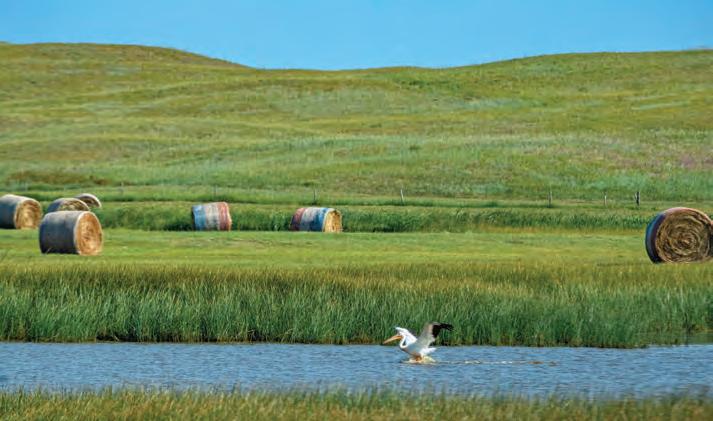
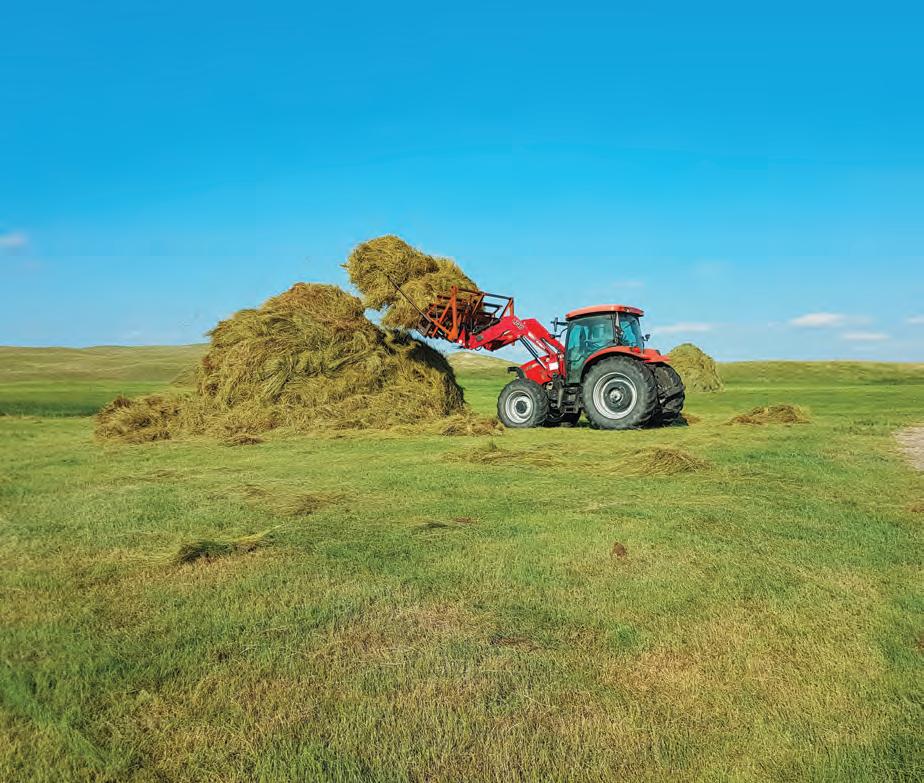
Author Nicole Louden reflects on more than 20 years of raking hay, stirring up wildlife like pelicans, and keeping her family and haying crew well-fed and hydrated.
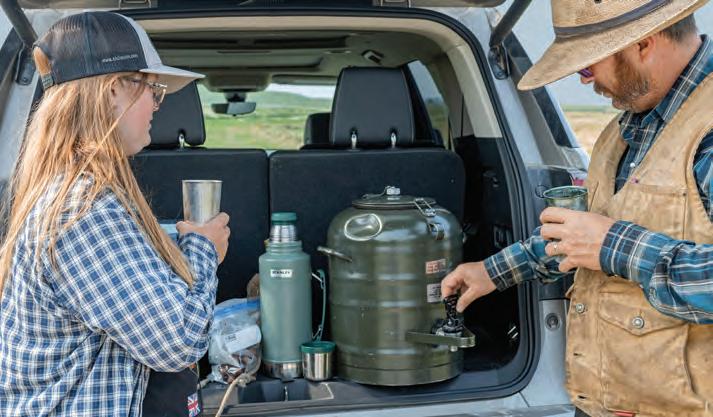
holes and marshes. Turning corners was especially unnerving; I geared down and lumbered along, lifting the rake so it didn’t drag and tried not to jack-knife the tractor and rake.
As I became accustomed to raking, I discovered I enjoyed it. For one thing, birds and animals did not seem to mind my machine circling around in the meadow and would let me get quite close. From the cab I saw ground squirrels and vultures, deer and pronghorns, hawks and geese, and ducks and grouse. A pair of cattle egrets chased me around the meadow, gorging on crickets and bugs in the overturned hay. A robber fly caught a grasshopper and feasted on it
while sitting on my tractor cab window. I watched, both horrified and fascinated as one bug sucked the life from the other.
From the tractor cab, I watched and appreciated the wide Nebraska sky. I admired a pristine blue sky stretched endlessly in a great circle overhead. I observed lazy cotton clouds drift slowly and sleepy in the afternoon heat. I warily watched thick, tall clouds gathering gray and dark with threats of lightning, hail, or worse, chasing us out of the hayfield as they loomed closer and closer.
Beyond all the wildlife and weather wonders, I took pride and satisfaction in raking. I enjoyed churning the flat, shimmering
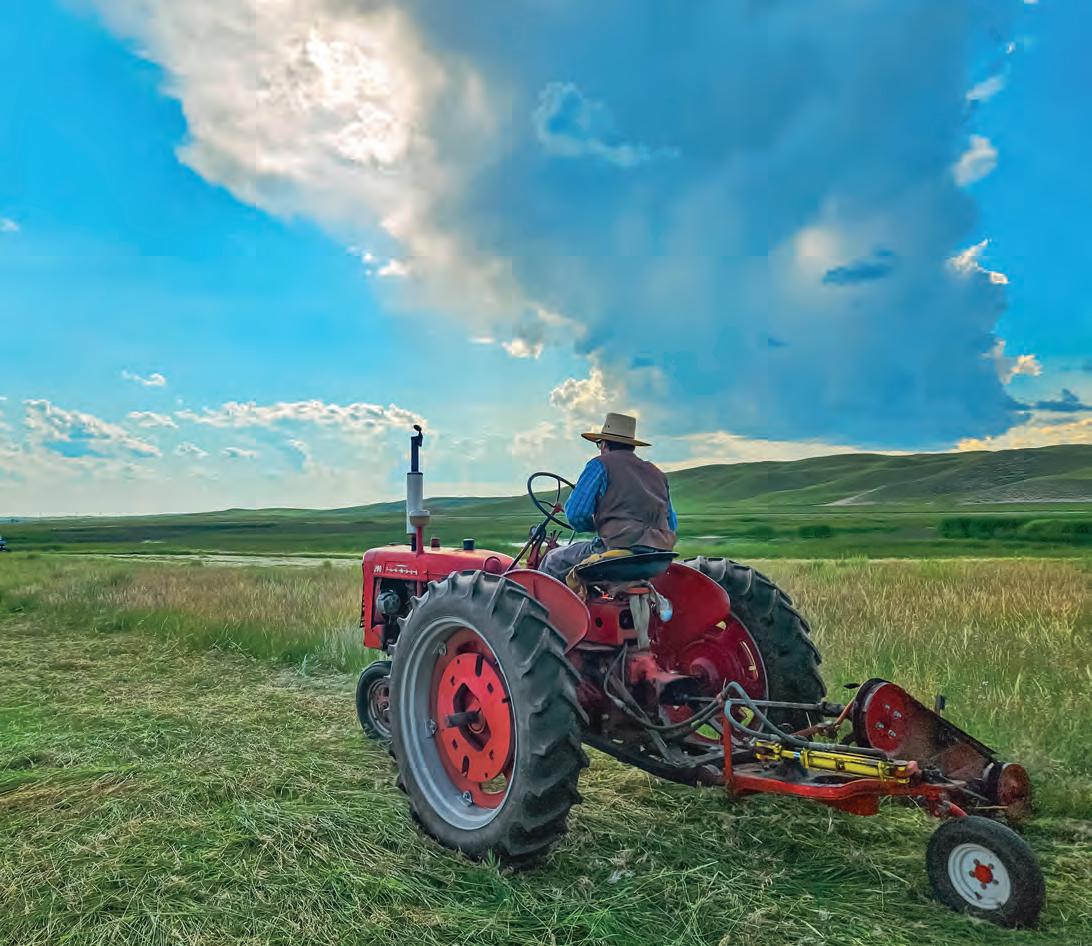
swaths of grass into neat windrows, sweeping the teeth of the rake over the mess of mowing to reveal a crisp, clean meadow underneath. I took more notice of the types of grasses and plants I raked – wheatgrass and brome and sandreed, three-cornered rushes and snake grass. Fuzzy foxtails, wiry clover and piles of tumbleweeds clogged my rake when thick. And oh, the glorious smell of all that prairie hay curing in the sun – the sweetest, most wonderful smell I’ve ever experienced.
This year, we are fortunate to have a sizable summer crew again, and I’ve returned to feeding a team of young men and women each
day. Once more, I’m serving up piles of mashed potatoes and roast beef, steaming rolls and golden creamed corn. Cobblers, cakes and pies are often made for dessert, all washed down by icy glasses of water and tea.
And while I find satisfaction in this as well – and know my efforts are appreciated – I doubt they will keep me in the kitchen the entire summer.
One of these warm days, I’ll hang up my apron, grab my ball cap and gloves, head out to the hayfield, and rake sweet prairie sunshine into rows upon rows of hay.
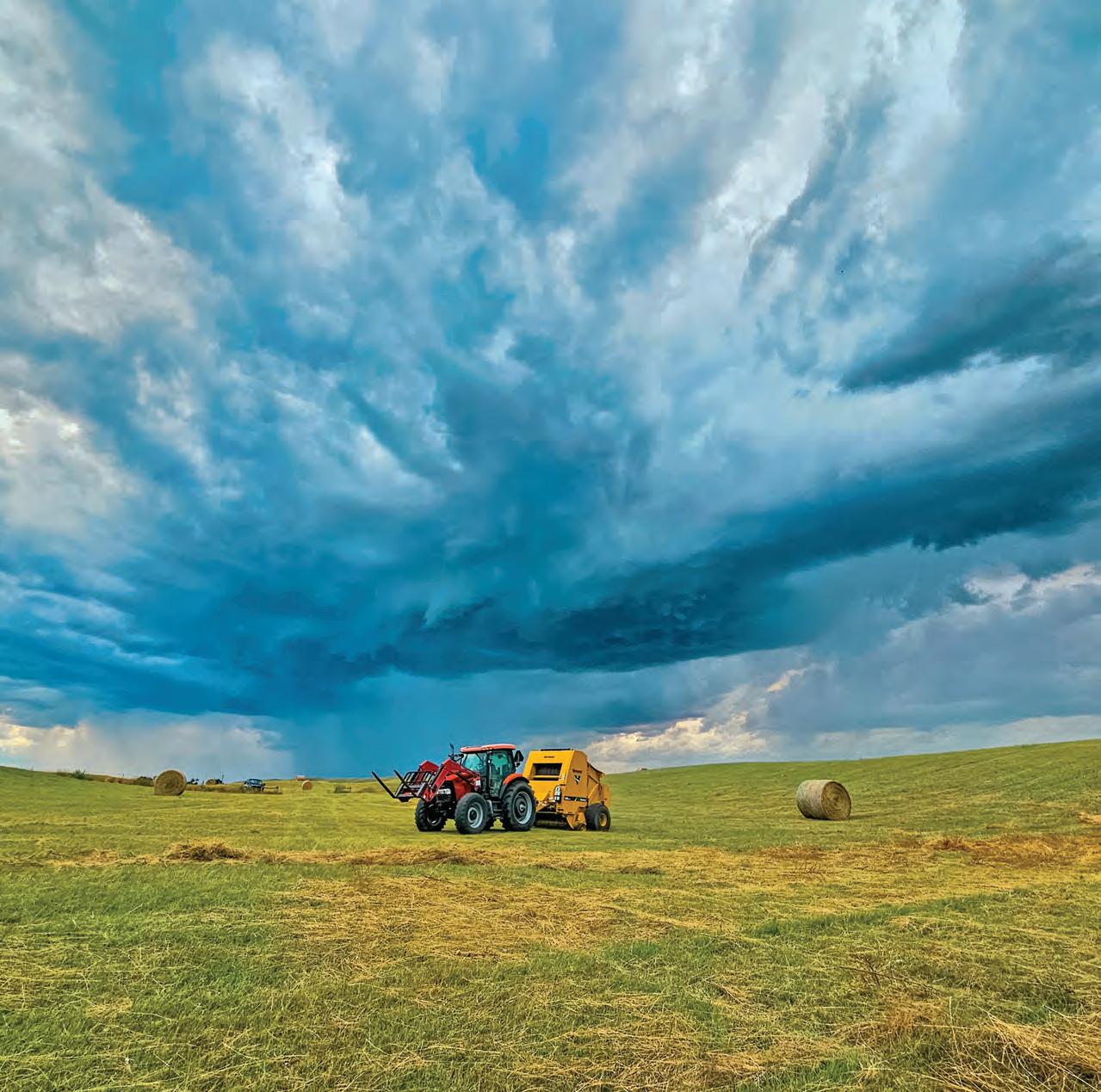
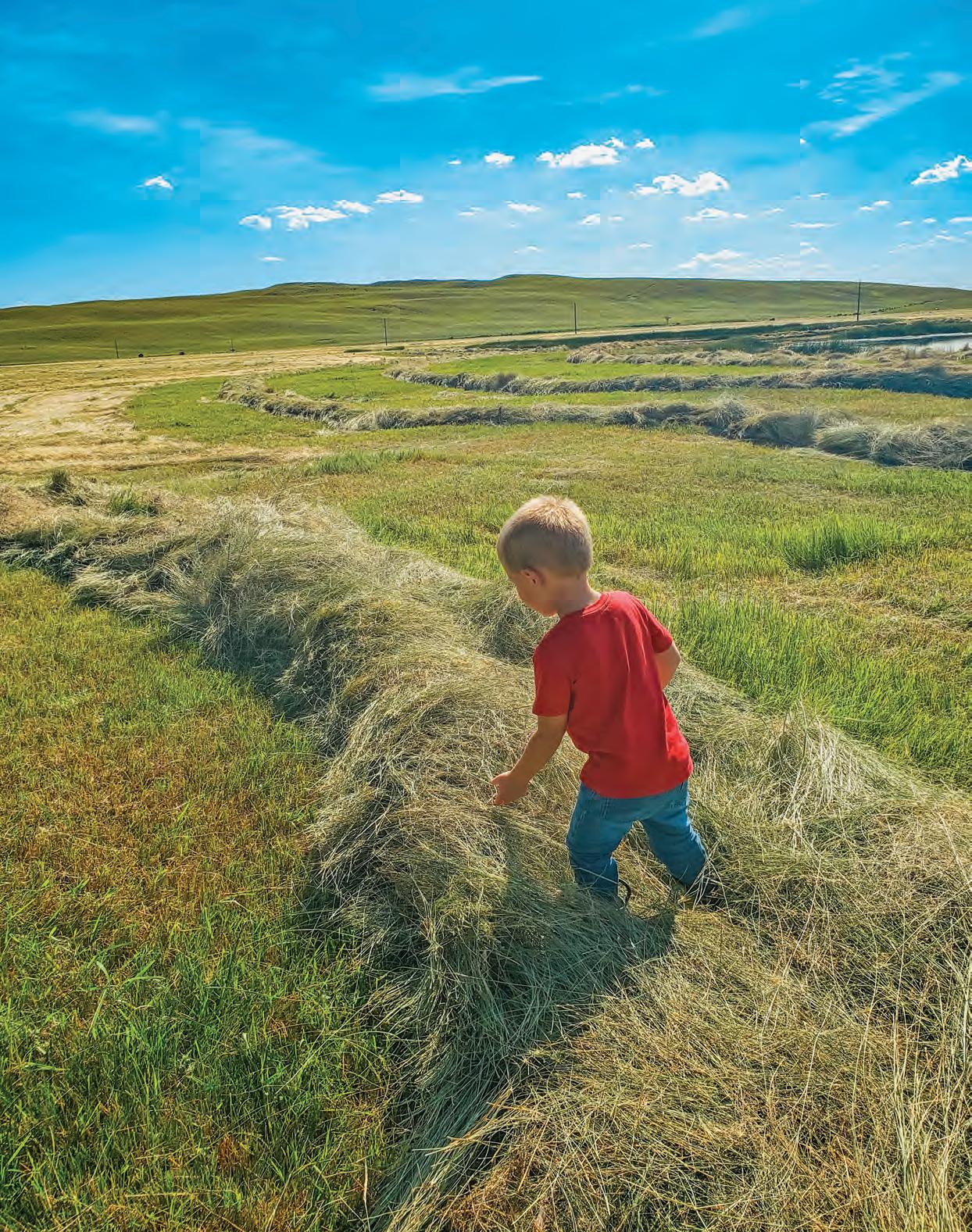
With a storm approaching, it’s time to head home for supper. The ranchers’ son, Samuel, plays in windrows of hay. Once dry, the crew will bale the hay to feed the Louden family’s cattle herd through the winter.
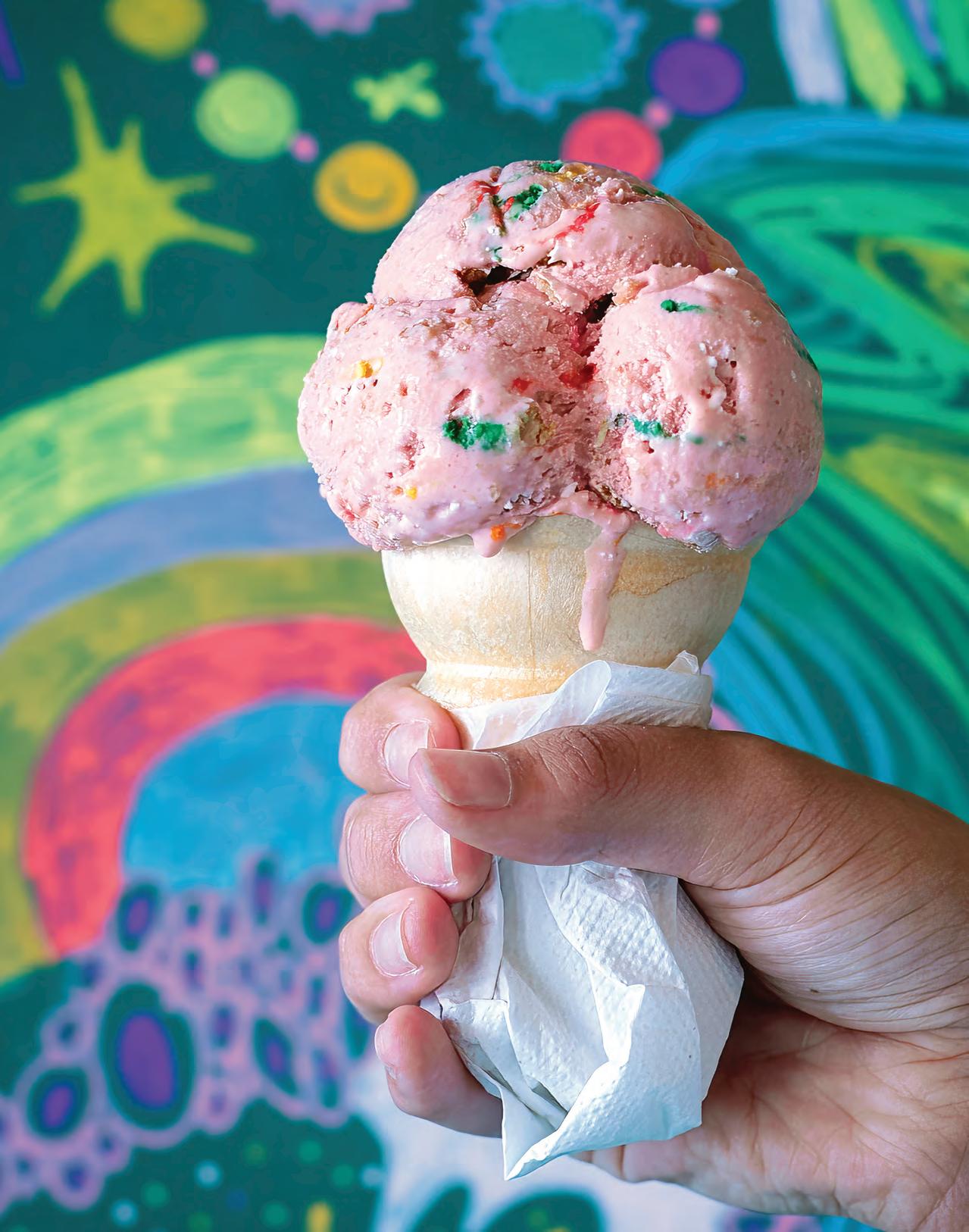

by ALAN J. BARTELS
CORNHUSKER STATE RESIDENTS know a thing or two about keeping cool. Lemonade, iced tea or a tall glass of cold water are staples, but nothing snaps a Nebraska heat wave like ice cream. With community-minded ice cream proprietors setting up shop from one end of the state to the other, Nebraskans have it made in the shade when stricken with a chronic ice cream craving.
Omaha
The City of Omaha’s Public Works Department employees work up a sweat removing snow from more than 4,500 miles of streets during winter. Come summer, that pavement really holds the heat in. When the sun sinks and the heat dissipates, residents venture outside to cool off.
A line forms out the front door of Coneflower Creamery on sultry summer nights in Omaha’s artsy NoDo (North Downtown) district. Founder Brian Langbehn knows sweet. His culinary climb began at the Chicago dessert nightclub, Sugar, where he learned to make ice cream. He later spent a summer cooking on Italy’s Amalfi Coast, treating himself to gelato daily. While working as executive chef at 801 Chophouse in Omaha’s Old Market,
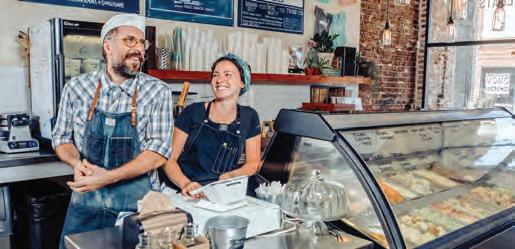
Langbehn shared with an employee his dream of opening an ice cream shop that used fresh, local ingredients.
Years later, that employee, Katie Arant Chapman, was cooking in California’s Napa Valley when she received a voicemail from Langbehn. He was finally ready to dip into the ice cream business, so she moved back to Nebraska to co-found Coneflower Creamery (that’s a double dip!)
Coneflower Creamery’s “farm-to-cone” philosophy means sourcing in-season fruit and other fresh ingredients from Nebraska farms – milk from a Hartington dairy, root beer from an Omaha brewery, aronia berries from an Omaha farm – and produce from family farms across the Mighty Mo in Iowa. This freshness is critical to producing ice cream much more flavorful than mass produced cold concoctions.
Coneflower Creamery’s other location is in Omaha’s Blackstone District, home of the historic Blackstone Hotel where the Reuben sandwich was invented. Another luscious legend credits the same hotel as the birthplace of Butter Brickle ice cream.
Collectively, according to Langbehn, Coneflower Creamery’s Blackstone Butter Brickle – a delectable distraction including chocolate covered house-made toffee – is Omaha’s favorite ice cream flavor. Milk it, Omaha. Milk it.
Lincoln
Seems appropriate that Lincoln’s iconic Creamery Building is home to a worldclass ice cream shop.
When we wrote about this ice cream landmark in 2008, this delicious destination in Lincoln’s Historic Haymarket had just celebrated a decadent decade in business.
Quality ice cream and community-mindedness has helped the business thrive now for more than a quarter of a century. But the crew here – they call themselves “Coneheads” – are not set in their ways.
Every batch begins with their 14% butterfat sweet cream vanilla base. From there, 17 varieties fill the menu most days. Much like a craft brewery, each batch is unique. Of the hundreds of varieties that
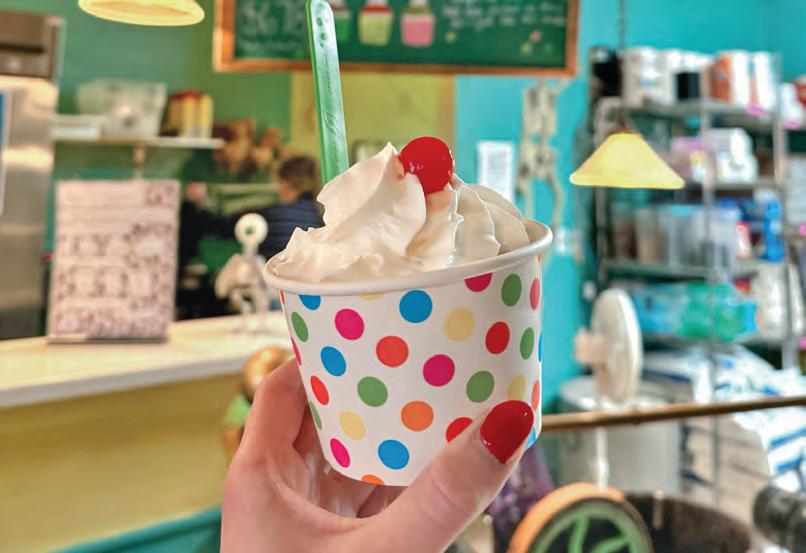
Each
Ivanna Cone has produced, they say that only about 30 recipes are written down. Even those can vary depending on the mood of the Conehead-in-Chief.
The ice creams, ice milks, sherbets and dairy-free sorbets made at Ivanna Cone are produced in a pair of ice cream freezers just inside the front door. They aren’t ancient, but the salt used to make the ice cream has given the freezers an antique-like patina.
As if additional reasons are needed for getting ice cream, Ivanna Cone creates promotions to benefit breast cancer and ALS research, and partners with Make-AWish Nebraska, Give to Lincoln Day and other causes, and gives away tons of free tickets to Lincoln’s co-ed No Coast Roller Derby league matches.
A popular Ivanna Cone collaboration with Haymarket restaurant, Leadbelly, is an ice cream sandwich featuring a chocolate chip, candied bacon cookie with peanut butter, raspberry and jalapeño ice cream in the center.
Ivanna Cone’s walk-up window in the alley has a special menu including Spu-
moni Ice Cream Sandwich, the Spicy Mango Lassi Popsicle and Ice Cream Bon Bons. Ivanna Cone’s Ice Cream Flights feature six mini scoops served in what looks like a small egg carton – but for ice cream. Utterly yummy. Oh, and new for 2024 – Dorthy Lynch carrot cake ice cream. Classically Nebraska. Yes, please!
When H.J. “Pard” Coffin opened his three-story general store in Burwell in 1906, he wanted it to be the hub of commerce for a 60-mile radius. There were dentist and doctors’ offices, Burwell’s first library and first telephone company, an Odd Fellows Hall, and the place even offered its own brand of shoes. Coffin’s great-grandson, John Schere, told us, “It was the Walmart of its day.”
After growing up in Burwell, leaving, and living elsewhere for decades, Schere moved home in 2006 and bought his great-grandfather’s building. After undertaking repairs and renovations, Schere and
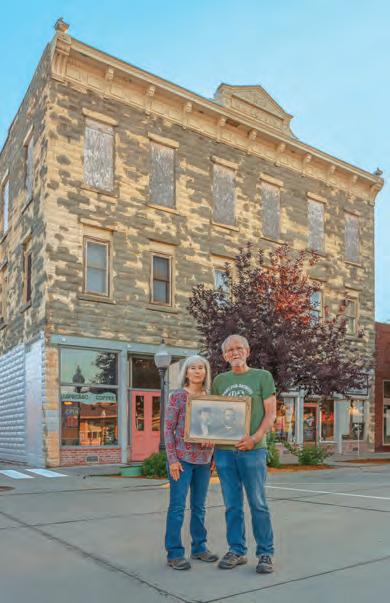
his wife, Melissa, opened The Hub. Shakes and other ice cream treats flow from the 1953 Bastian Blessing Co. soda fountain. The Scheres also whip up baked goods, smoothies, teas and coffee drinks, and Polish dogs, hot dogs and other lunchtime goodies. Local products fill shelves. The Burwell Tribune newspaper office is upstairs, and the Holy Heifer & Co. boutique fills the adjoining storefront.
On a recent Saturday morning at The Hub, visitors were perusing the Scheres’ antiques, residents were sipping morning coffee and girls from the Burwell Longhorns high school volleyball team were having a Bible study – complete with smoothies, coffee and ice cream. Truly the tasty hub of the community.
Wood Lake
Passing by on U.S. Highway 20 at 65 mph, motorists could blink and miss Wood Lake. Fifty-one residents live in the Cherry County village. Ten times that number called Wood Lake home a century ago, but Wood Lake residents still enjoy the good life one refreshingly cold spoonful at a time.
Resident Norma Cozad amped up the flavor of Wood Lake by opening Grandma’s
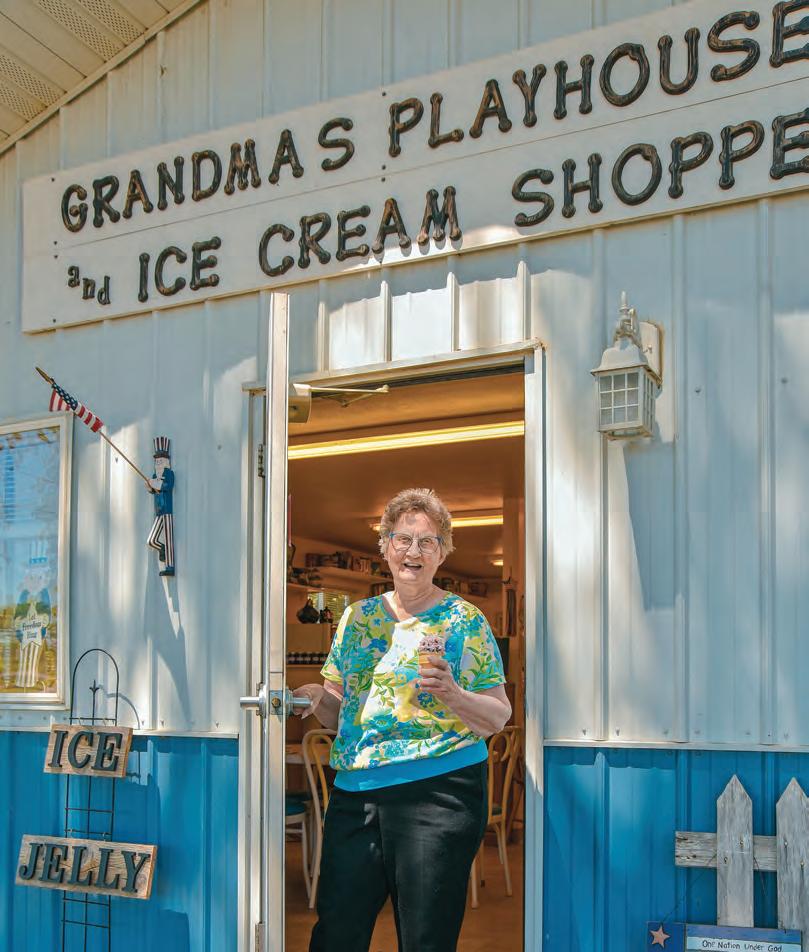
The Hub began as a downtown Burwell general store in 1906. John Schere, the great-grandson of the store’s founder, and his wife Melissa, whip up soda fountain treats. Retired Wood Lake postal worker Norma Cozad opened her ice cream shop in 2005.
Playhouse and Ice Cream Shoppe in 2005, the fruition of a lifelong dream of owning a store from which to sell her handicrafts.
Cozad, a retired postal worker, sells ice cream, cold drinks and her homemade baked goods. She jars her own sweet pickled relish and heats things up with her cranberry jalapeño and other jellies. She opens early for morning coffee daily except Sunday.
This ice cream hobbyhorse is no cash cow – Cozad is all about contributing to her community. Cozad’s dedication to Wood Lake means more than crafting and scooping. She also serves Wood Lake
American Legion Auxiliary Unit 202 – as the membership chairperson, the secretary, treasurer and the president! On top of that, like the cherry punctuating one of her specialty ice cream sundaes, Cozad is secretary of the Wood Lake Union Church.
Nebraskans statewide can bring home a taste of Grandma’s Playhouse and Ice Cream Shoppe by stopping by Cozad’s booth at local craft fairs and festivals. Homemade jellies, jams, relish and, of course, ice cream toppings anxiously await a loving home with a freezer full of ice cream.
Ashby
The distance between communities is substantial along portions of Nebraska Highway 2. If you’re driving west, or east, on a hot summer day with heat waves shimmering from the asphalt and your throat parched, you might start hankering for some cold ice cream at, oh, about Ashby.
Travelers capture the Sandhills in photos. Artist Linda Lacy portrays the region on canvas and in clay. She displays her creativity in downtown Ashby, an unincorporated community in Grant County that Lacy said has about 40 residents, “if you count cats and dogs.”
Visitors view her work at the former cafe known now as CaLinda’s Pot Shop & Art Gallery – the moniker a combination of the artist’s first name and that of her BNSF Railway retiree husband, Cal.
The vintage wooden booths serve as display space for Lacy’s art, so customers sit at tables, at the counter or on the Party Porch as coal trains roar by. Being a good Sandhills neighbor, Lacy makes drink deliveries to Hyannis, nine miles to the east, most Wednesdays.
Lacy’s award-winning works of art reveal ranch scenes, windmills and Sandhills flora and fauna. The clay wine coozies that she throws on a potter’s wheel in the back of
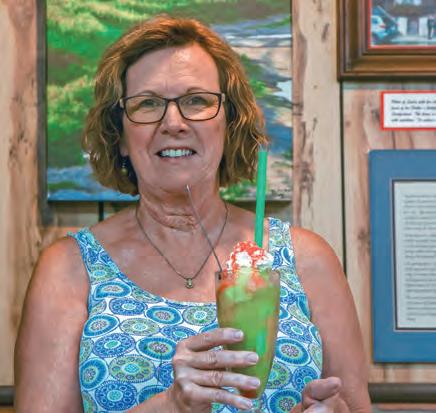
her shop are one of her most popular items. Though no medicinal herbs are available at the curiously named shop (it’s not that far west), in addition to paintings, pottery, coffee, smoothies and ice cream, Lacy hosts kid’s birthday parties, Fun in the Mud pottery workshops and Sip and Stroke painting events where patrons bring their beverages of choice and learn to paint.
The Soapweed Squeeze, named for the yucca plants found in the Sandhills surrounding Ashby, is a colorful ice cream treat and culinary work of art served in an antique soda fountain glass. Lacy said that each one includes a burst of flavor and a “prickly Sandhills surprise.”
Dannebrog
The Danish Capital of Nebraska has been a culinary destination for decades due to the Danish Bakery’s famous pizzas every Thursday night. But the community in Howard County is also known for dessert thanks to an ice cream proprietor intent on giving back to his adopted hometown one community-minded scoopful at a time.
The Danes aren’t necessarily known for their ice cream. Abelskiver, yes, ice cream, no. Danish pancakes aside, ice cream cafe owner Tim Hannibal is a proud Dane. Hoping to instill community pride in area youth,
Hannibal used social media to issue a challenge: pick up discarded aluminum cans from along rural roadsides and receive a free scoop of ice cream – 10 cans minimum.
The parade of kids carrying bags of dented, dirty and dingy cans up the front steps of his shop brings a smile to Hannibal’s face and has made roadside litter rare near Dannebrog to the point where the children are now scavenging litter from lakes, rivers and recreation areas. The idea was inspired by a visit Hannibal made to Dannebrog while living and working in California before moving here in 2016.
“I could not believe the amount of litter in the ditches,” said Hannibal, the sixth-generation great-great-great grandson of Lars Hannibal, who founded Dannebrog in 1871. “Now, when the kids come in for their free scoop, I see it in their smiling faces that they are proud of themselves.”
Scooping ice cream smiles is gratifying for the former heavy civil construction management engineer who built bridges, dams, railroads and other transportation infrastructure across California while living in the hectic Interstate 15 corridor between Los Angeles and San Diego. Board games, other games and art supplies – some provided by Hannibal, others donated by area residents – occupy families eating their desserts or waiting for orders. The activity room is wallpapered a rumored 17 layers
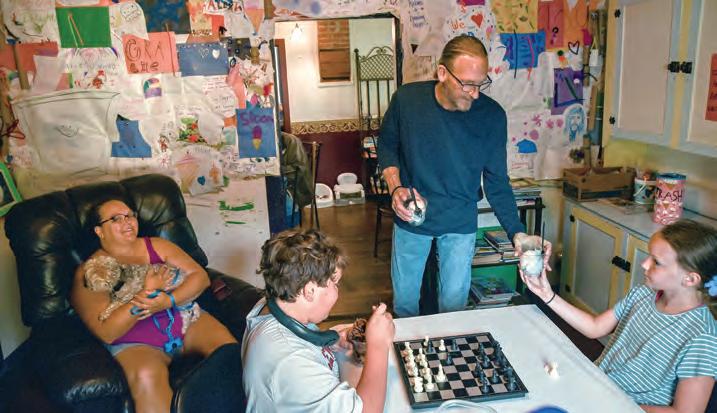
deep with handmade art. Hannibal scans the room and smiles. Stress, if there could possibly be any, melts away while wielding a cold ice cream scoop and dishing out joy to children and ice cream lovers of all ages.
Hannibal’s adopted hometown loves him back. While helping a neighbor paint, Hannibal fell from a roof and broke an arm, a leg, and lost vision in his left eye. After medical treatment which included being flown to Omaha and being hospitalized for weeks, Hannibal returned home to find that a ramp had been built so he could get his wheelchair in and out of his house. Locals put on a fundraiser to help pay for medical bills.
“I was in that wheelchair for three weeks and didn’t have to cook once,” Hannibal said. “The people here brought me food every day. That was so awesome.”
Dannebrog is in good hands, ice cream and aluminum cans alike.
Having ice cream close at hand must be mandatory in a community that claims, “It’s Hotter in Potter.” But the Cheyenne County community’s most flavorful claim to fame is served in a tall, glass dish.
The Potter Sundry building is owned by the Potter Historical Foundation. Established as the Potter Drug Co. in 1914, confectionery history was made here in the 1930s. While working for his pharmacist father, young soda jerk Harold Thayer –better known as “Pinky” due to his bright red hair and bubbly attitude – was known for creating crazy sundaes at will.
There was the short-lived Blitzer, and the all-but-forgotten Zombie. But Pinky whipped up a cool mixture that became a national flavor sensation and stuck like a scoop of vanilla to a thick, cold spoon – the Tin Roof Sundae.
“The Tin Roof Sundae is what we are known for, and it still attracts tourists from all over the country to Potter yet today,” said Missy Marsh, who owns the restaurant and ice cream shop in the Potter Sundry building. “Lots of companies make and sell Tin Roof flavored ice cream, but we are the proud original.”
Marsh hears from lots of visitors who
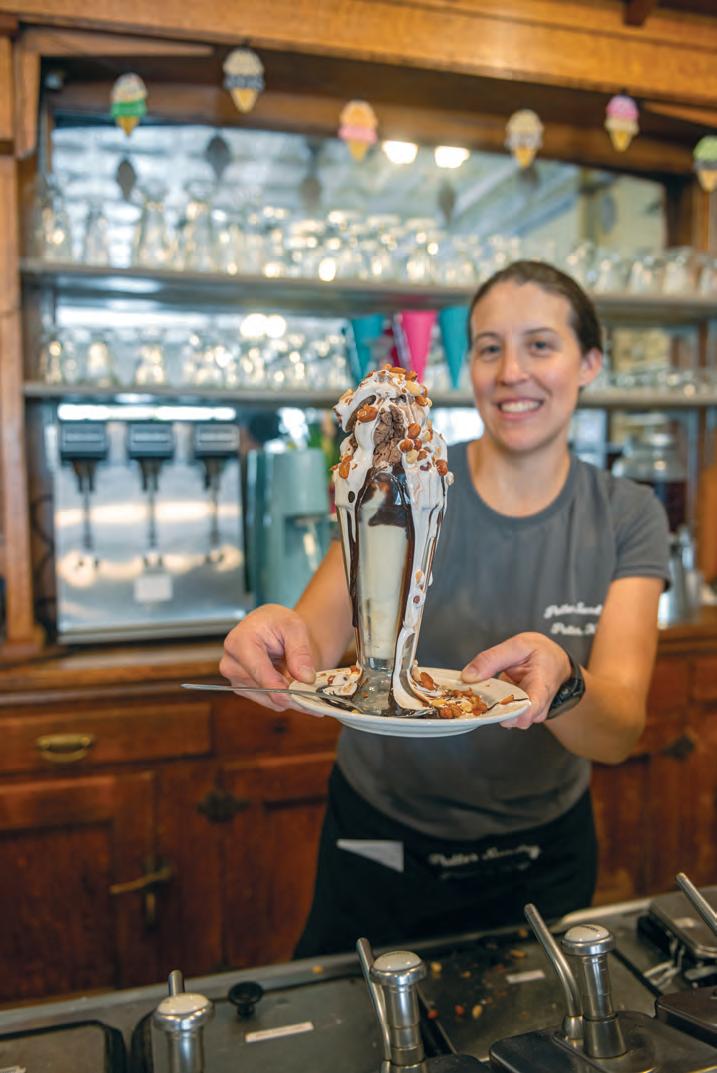
remember the old days when Potter’s Tin Roof Sundae was 25 cents. Today, the mini will set ice cream fans back $5.50, the Classic is $7.50, and foodies with bulging appetites will fork, er, spoon over $9.50 for the Large.
This sundae is a beautiful thing to behold with scoops of vanilla and chocolate ice cream in the glass, a generous sprinkling of Spanish peanuts, and a pleasantly profuse topping of chocolate syrup and marshmallow syrup – some of which is bound to run down the side and hit the soda fountain counter if not caught by
a spoon or excited tongue. Don’t worry; more chocolate syrup awaits between its vanilla and chocolate scoops. Competing legends claim that Pinky named the sundae after the Sundry’s tin roof or its now covered tin ceiling, or even the roof of a nearby livery stable.
Nebraska State Senator Steve Erdman, who represents District 47, which includes Potter, has nominated the Tin Roof Sundae as Nebraska’s Official State Sundae. The resolution never advanced out of committee. Potter’s (and Nebraska’s) famous Tin Roof Sundae has our vote.
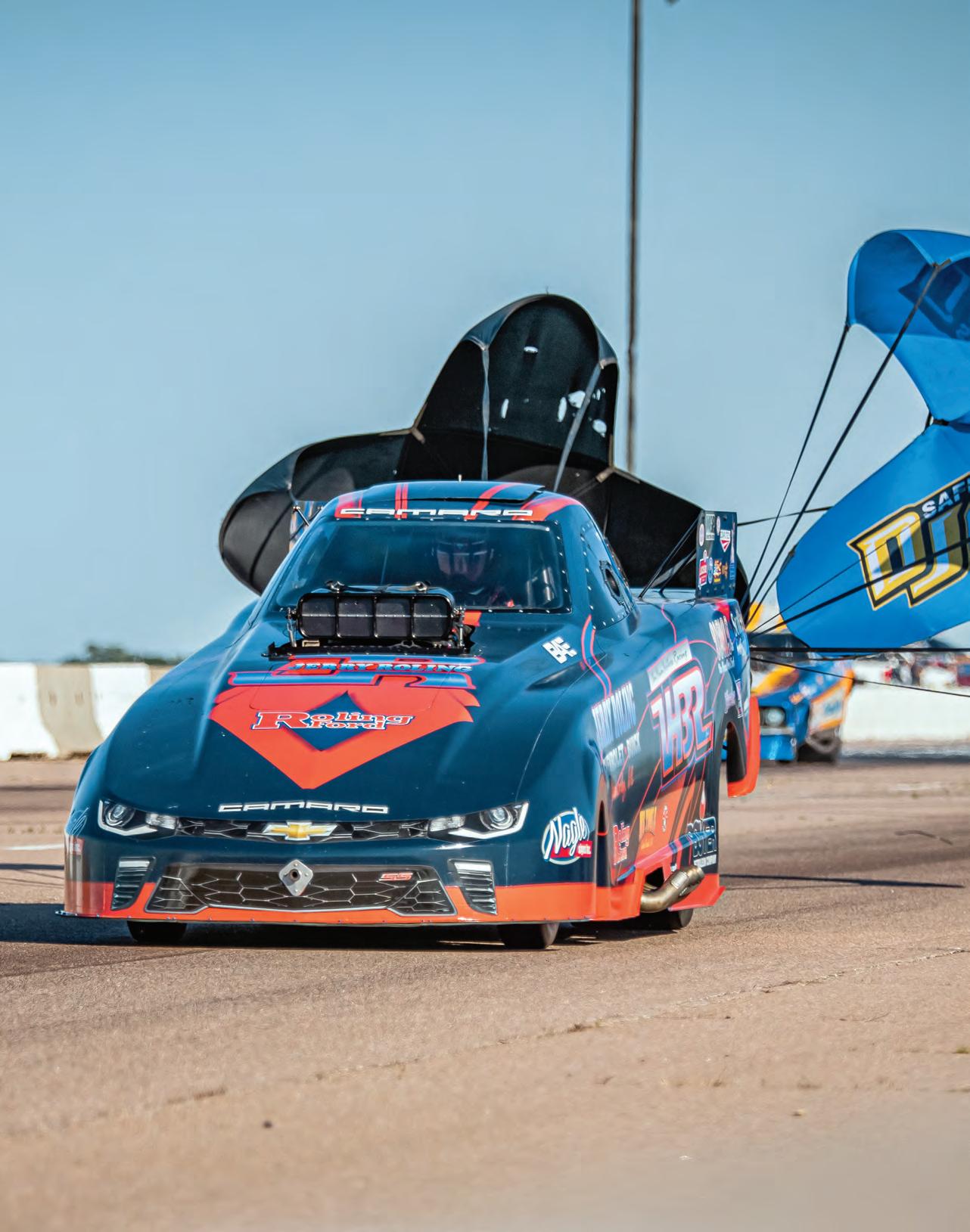

by CHEYENNE ROWE
FUNNY CARS FILE into Kearney Raceway Park as pale dirt swirls up through the air and into small tornadoes with grit finding its way to the teeth of spectators. The orange sun is sinking over a horizon of corn fields. It’s hot. It’s humid. But no one seems to mind.
Kearney Raceway Park is home to people as eclectic as the cars. They are different ages, different skill levels with different budgets for engines and racing slicks, but at heart they are all the same.
Because of the park, because of the drag strip, racers have a safe place to break speed barriers. Street cars, and those with 10,000-horsepower engines shaped like space-age ships, gather to entertain the community of fans who have gathered. They are here for speed. They are here for each other.
Funny car chaos occupies summer weekends at the Kearney dragstrip. Hundreds of earmuff-clad fans fill the risers and line themselves along the chain link fence that separates the track from the public. The smell of hot metal, exhaust and burnt rubber churns through the air, feeding the excitement of evening races.
In the pits – a large concrete lot behind the track – a rainbowed assortment of drag cars await to tantalize the eyes.
Funny cars earned their moniker in the 1960s, when a spectator took one look at the altered wheelbase of the race cars and said, “That looks funny.” Newer cars in this class are commonly characterized by their tilt-up fiberglass bodies and custom chassis.
Alma resident Matt Nissen is one of the many familiar faces at the Saturday night race. He’s a bit bigger than the average funny car driver at a towering 6 feet 2 inches, but that doesn’t stop the speed addict from adding 4.20-second runs to his catalog of accomplishments. Nissen noted these lightning-fast runs take a toll on the car.
“Those cars are so volatile; they are constantly tearing themselves apart,” he said.
Weeks of preparation go into tightening nuts and bolts, making sure chassis aren’t cracked and that the trailers, water tanks, food and his team are ready to go. When it’s time to race, his team buckles Nissen inside the vehicle. With the shell
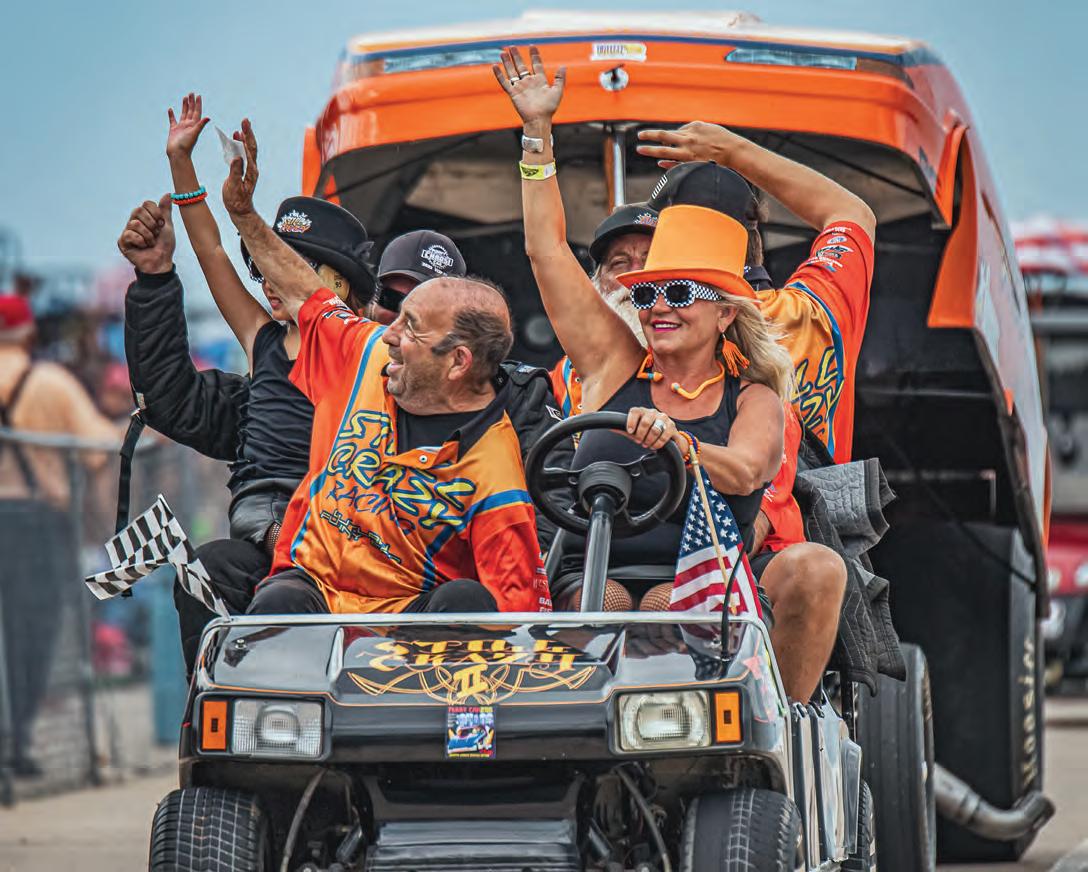
down around him, he is in his own world.
Drivers like Nissen then have little choice but to enter a state of Zen. They scan their instruments, prepare for launch and wait as the tower of lights (affectionately dubbed the “Christmas tree”) counts to green.
“Time slows down,” Nissen said, and then the 4-second storm begins. Nissen and other funny car drivers typically run an eighth of a mile in 3 to 5 seconds at 180 miles an hour. And then, as part of his routine, he deploys the parachute from the back of the car to create drag until the car slows enough to come to a stop. His pit crews end the run by towing the car and driver back to the pits.
Drag racing accelerated its way into Nebraska culture in the early 1950s. Much like its purpose throughout the
rest of the country, Nebraska’s raceways kept the young and old off streets and back roads and gave them a place to speed safely. Kearney Raceway Park started hosting races at the U.S. Army Airfield in 1964 and continues as Nebraska’s only drag racing track.
Despite the sweltering heat, the energy from the fans, racers and pit crews fills the air. For the Nebraskans who find themselves leaning over the chain-link fence to get closer to the eardrum-rattling action, they are right at home.
Tonight’s contest is a bracket racing battle: a side-by-side timed acceleration contest by cars with different performance levels.
In one lane, a blue Chevy Monza, driven by Tim Reeve, is poised and ready for takeoff. In the other lane is Thad Harms in a deep burgundy Dodge Polara 500.
Despite looking right at home behind the driver’s seat, the car doesn’t belong to Harms. Its owner, Tracy Rhodus, is new to owning the car, too. He didn’t build it, or even change it before he brought it to the track.
Harms got to this moment in time through a bit of serendipity that started with a tragedy.
In late October 2022, Rhodus’ best friend, Terry Campbell, was driving from Chapman to Grand Island when he was killed in an accident. Authorities determined the other vehicle was speeding 93 miles an hour in a 45 mile-an-hour zone when it smashed into Campbell’s vehicle.
Later, Campbell’s family made the difficult decision to sell his beloved Polara racer at an estate sale, and Rhodus was there to bid on it.





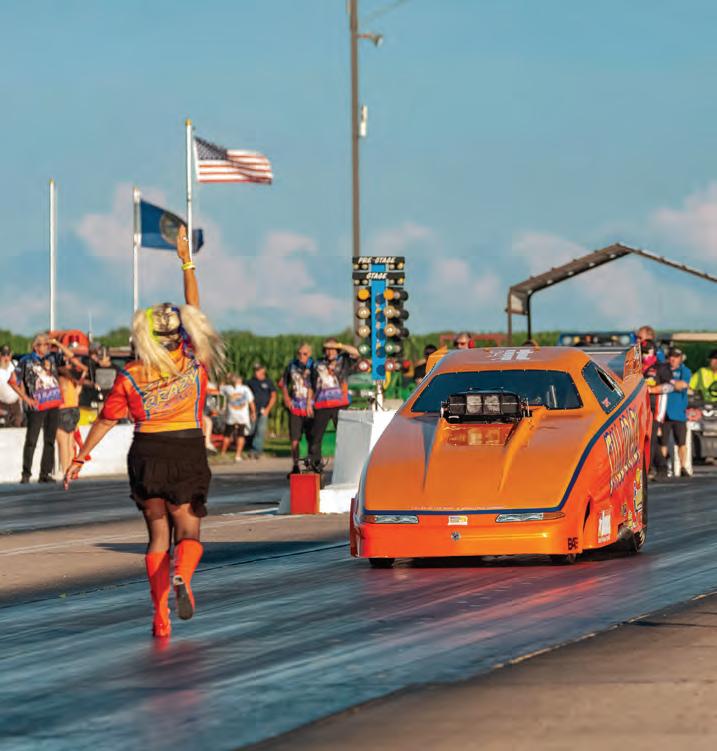
But the car did not sell easily: Rhodus battled through 45 minutes of intense back-and-forth bidding.
“It’s like he was testing me, to see if I really wanted it,” Rhodus said.
Rhodus called up Harms on the day of the race and asked if he wanted to give the Polara a go on the track. The timing felt right, and Harms agreed. Rhodus included a photo of Campbell in the passenger’s seat to make the moment more special.
The Christmas tree lights start ticking down.
Both engines roared to life – one built over generations; one bought in memory of a friend.
Despite ear plugs, the man-made thunder pushed deep into the bones of spec-
tators. Front tires lifted off the track with the force of the detonating gasoline under the hoods.
The roar of the Polara’s 440 cubic-inch V8 engine rumbled down the track as the gaze of the spectators followed him to the end. Harms propelled across the finish line 13.98 seconds after starting the race – in first place.
Rhodus accomplished what he set out to do.
Asked what Campbell would have said to his friend after his prized hot rod came in first?
“I told you so,” Rhodus said with a laugh. Such is life in legal street drag racing. The story will play out again next weekend, maybe with a different ending.
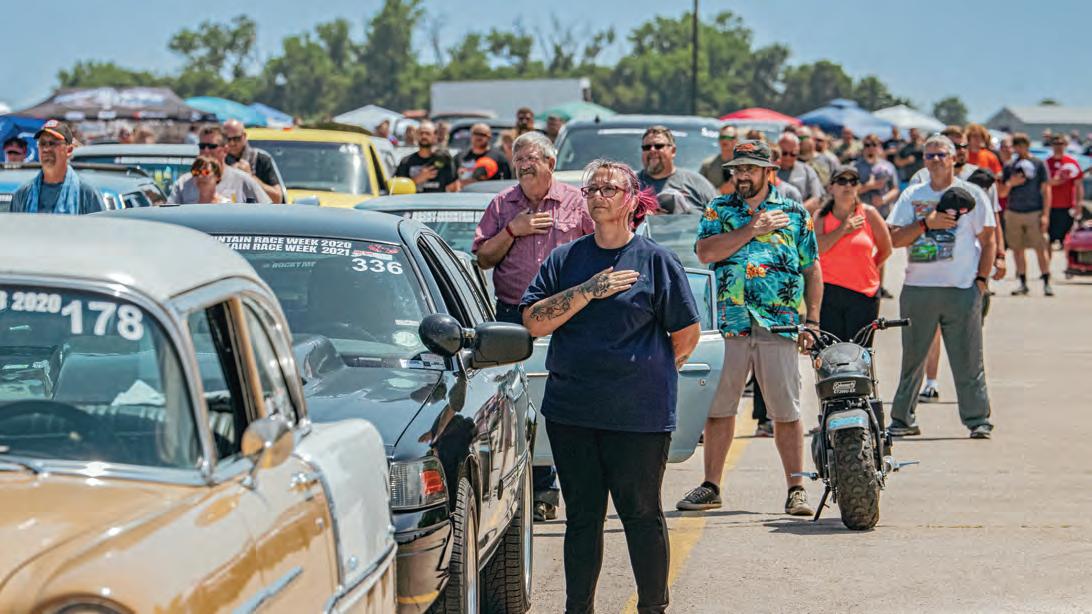
In the Rocky Mountain Race Week, up to 250 racers compete in Kearney and on tracks in neighboring states. Gasser Prospector is typical of a type of hot rod in the 1950s and into the 1970s, and still makes the rounds.
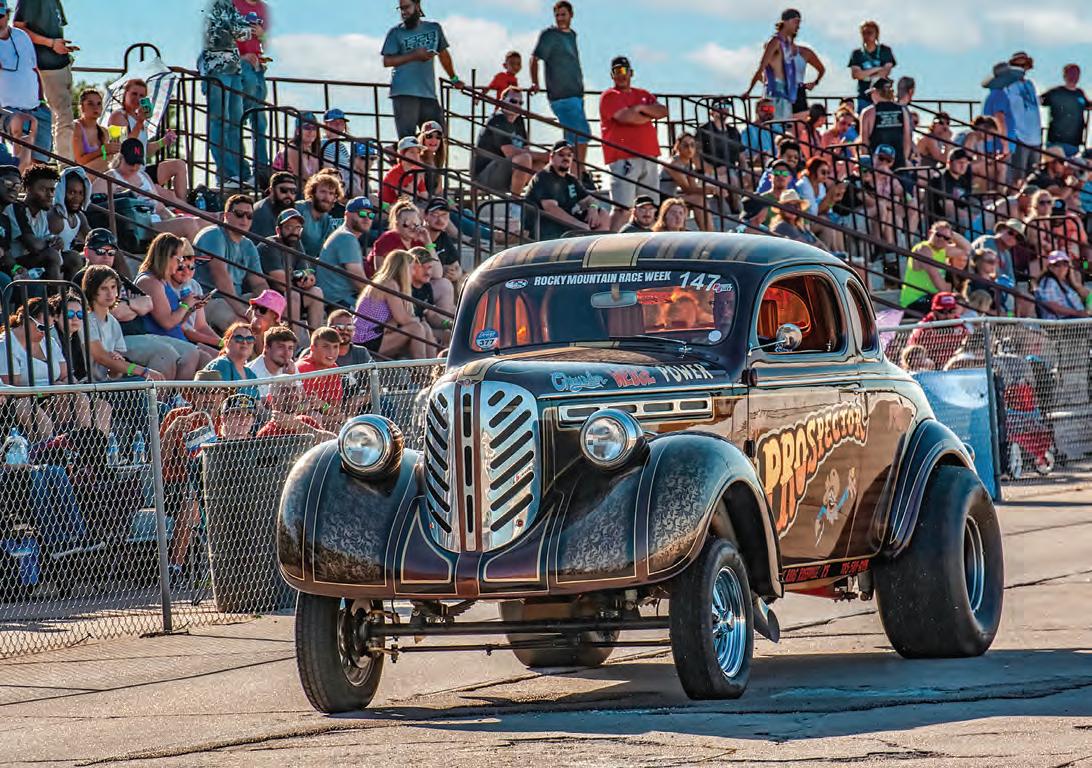
BANCROFT
John G. Neihardt
State Historic Site p 44
BAYARD
Chimney Rock Museum p 43
CHADRON Museum of the Fur Trade p 46
COLUMBUS
Columbus Area Children’s Museum p 74
FORT CALHOUN
Washington County Museum p 44
FREMONT
Dodge County Historical Society Museum/Louis E. May Museum p 46
GOTHENBURG
Gothenburg Pony Express Station p 67
GRAND ISLAND
Stuhr Museum of the Prairie Pioneer p 43
HASTINGS
Hastings Museum of Natural and Cultural History p 42
HENDERSON
Henderson
Mennonite Heritage Park p 45
KEARNEY Museum of Nebraska Art p 44
LA VISTA Czech and Slovak Educational Center and Cultural Museum p 46
MADISON Madison County Museum p 44
NEBRASKA CITY
Wildwood Historic Center & Period House p 45
NELIGH Pierson Wildlife Museum & Learning Center p 46
OMAHA Durham Museum p 43
SEWARD
Nebraska National Guard Museum p 23
SIDNEY Fort Sidney Museum p 19
WEEPING WATER
Weeping Water Valley Historical Society/ Heritage House Museum Complex p 45
YORK
Clayton Museum of Ancient History at York University p 45
Wessels Living History Farm p 47


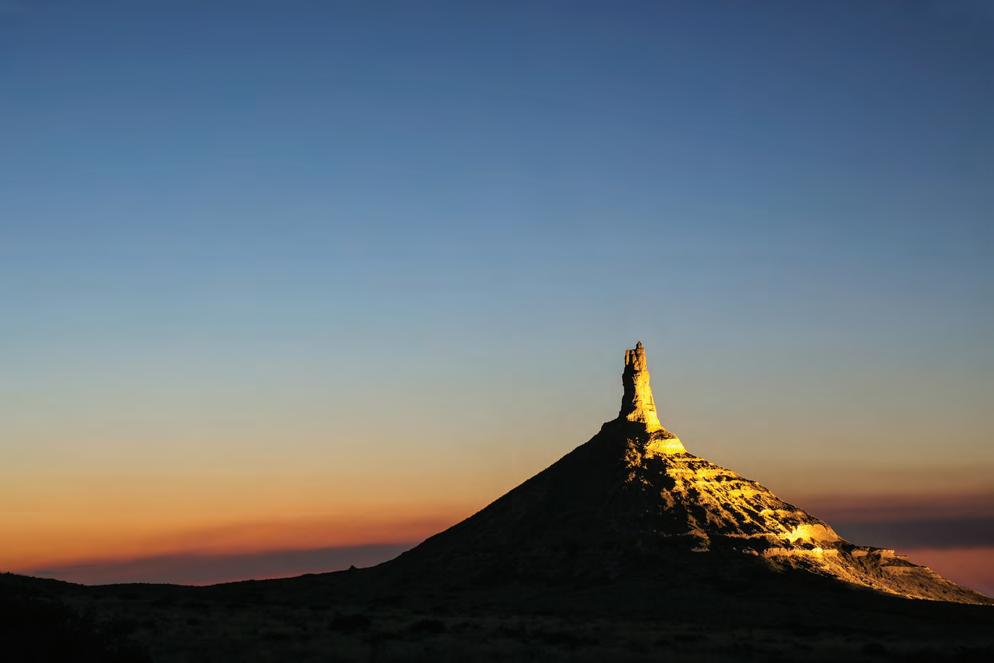
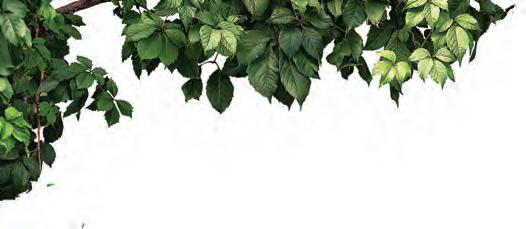


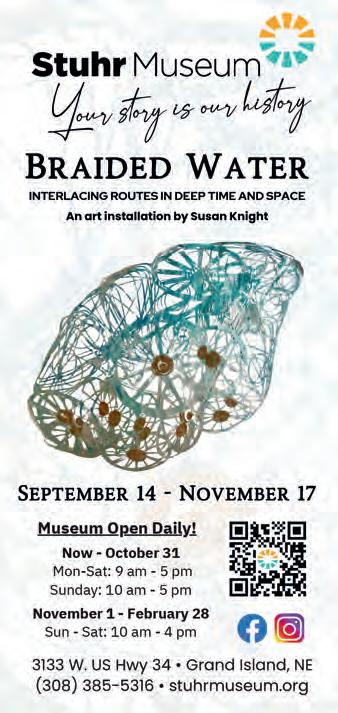
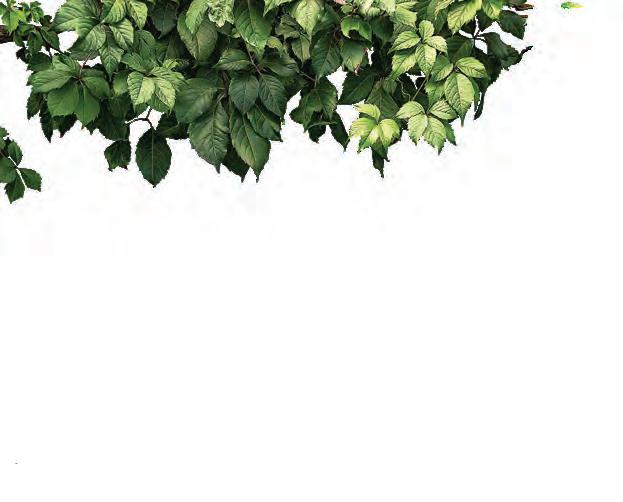
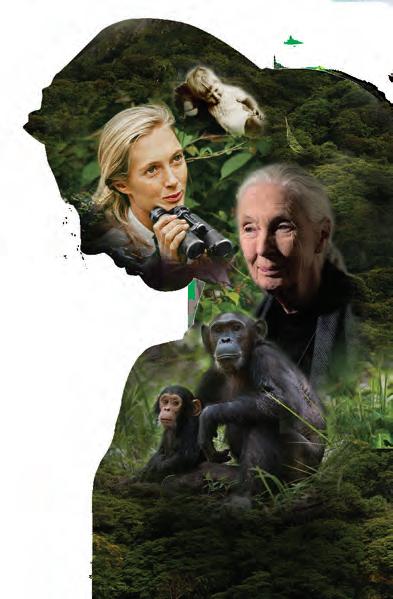

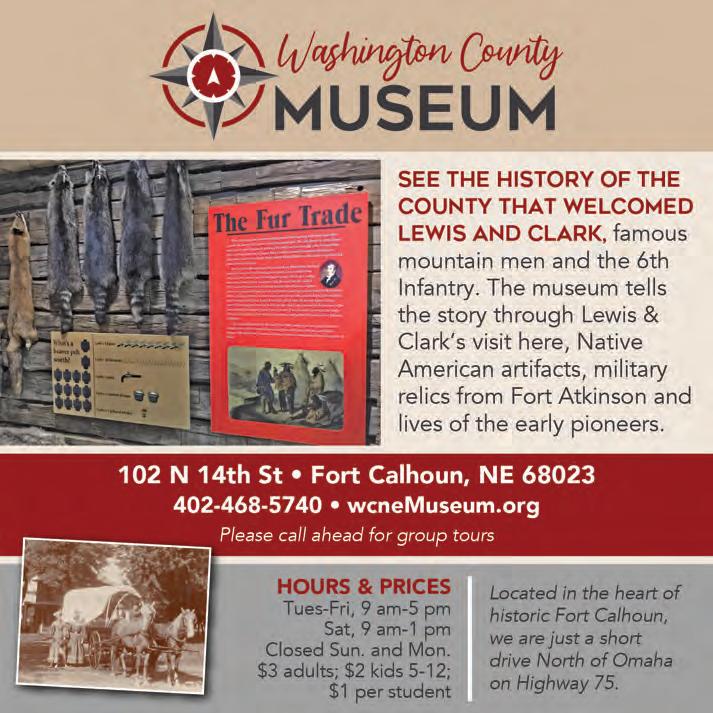
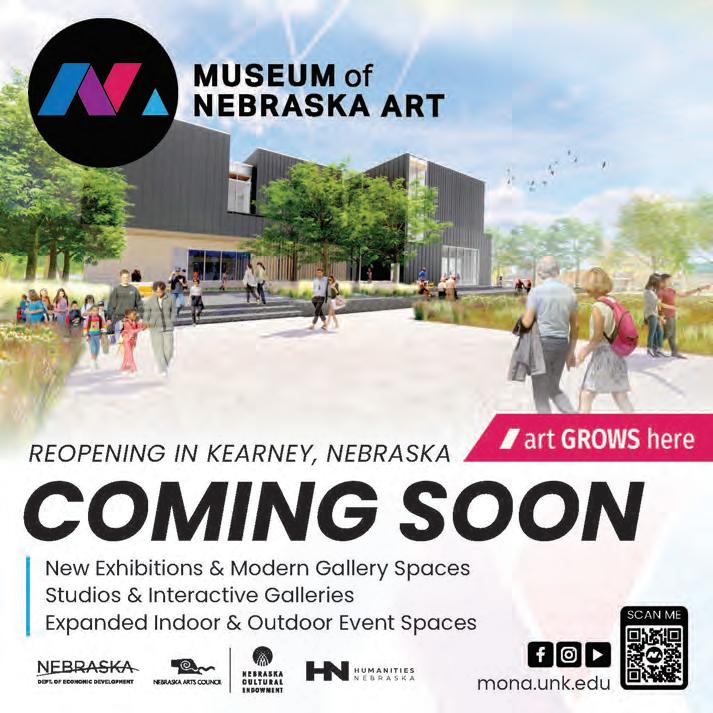
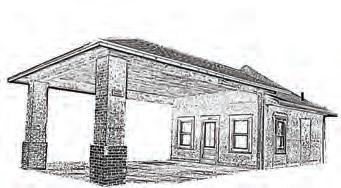
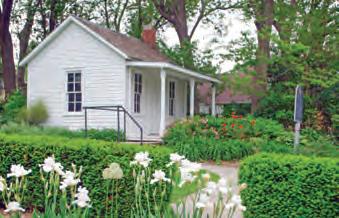
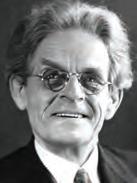
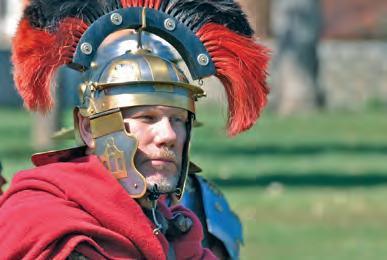
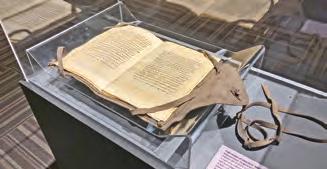
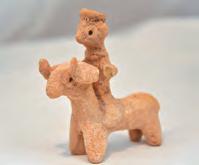
Explore ancient Rome, the Near East and much more. Special Bible exhibit shares the story of scripture from scroll to modern translations. Children’s interactive Little Kingdom now opened!
View rare artifacts from the ancient civilizations of Mesopotamia and Roman Empire! Young and old can experience the museum’s Little Kingdom interactive area. Uncover objects in an archaeological dig, “live” in an ancient house and “shop” a Roman market. Admission is FREE with donations always accepted.
ADMISSION IS FREE Check Facebook page for hours

Open Tues-Fri, 10 am-5 pm • Sat 1-4 pm claytonmuseumofancienthistory.org
ClaytonMuseumOfAncientHistory.org
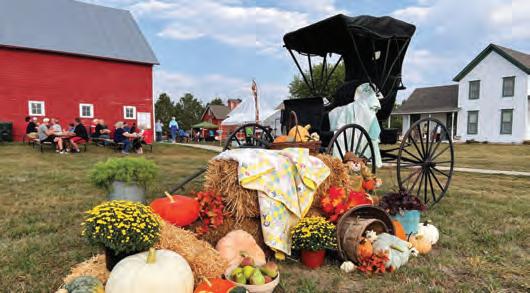
Henderson Mennonite Heritage Park and History Museum
Explore our 8 1/2 acre site with its turn-of-the-century farmstead, depot, country church, and school, where stories of Henderson’s Mennonite immigrants come to life!
402-363-5748 • 1125 E 8th St • York
Paid for in part by a grant from the York County Visitors Bureau
402-363-5748 1125 E 8th St • York, NE
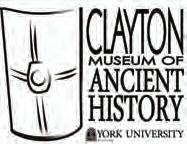
Paid for in part by a grant from the York County Visitors Bureau

Tue-Sat, 1-4 pm or open upon request
Lower level of the Mackey Center on the York University campus
Located in the lower level of the Mackey Center on the York College campus
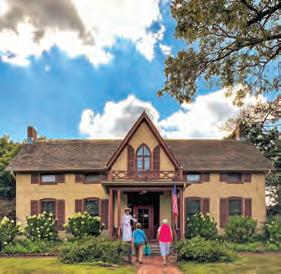
TOUR THIS 10 historic home built in 1869 for the Ware family. Guided by docents in period dress, learn about the family and the era Stroll through the Victorian Garden anytime, the perfect place for weddings or special events accommodating up to 100.
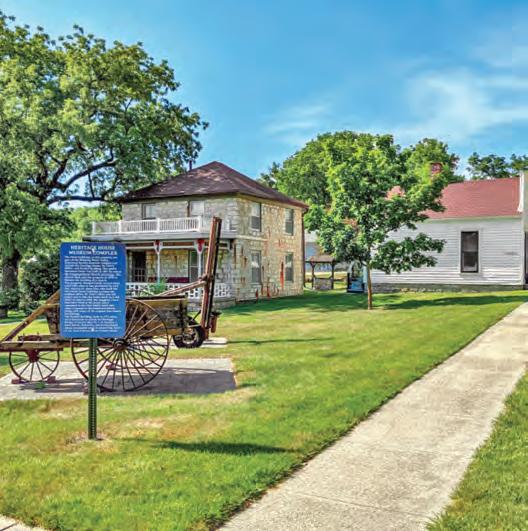
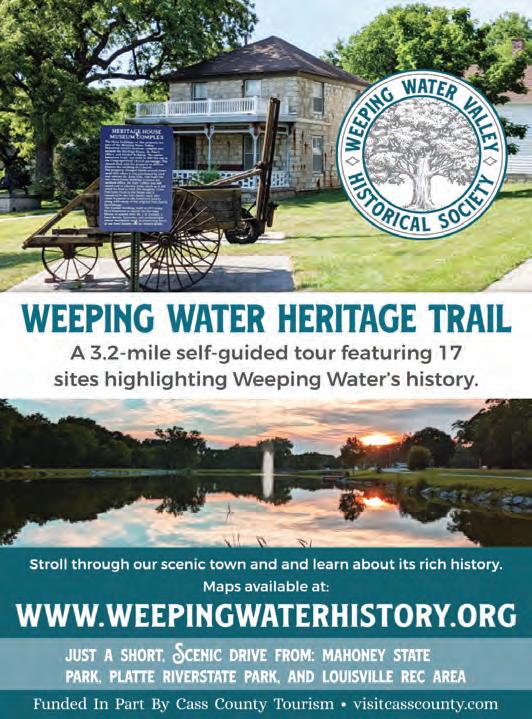
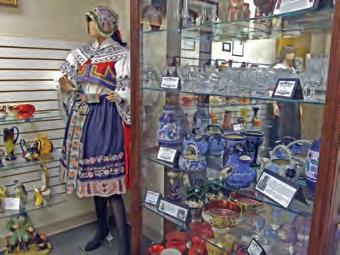
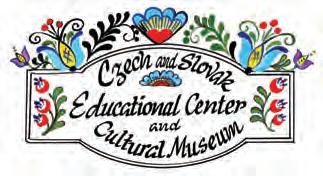
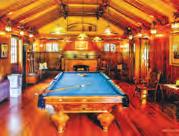




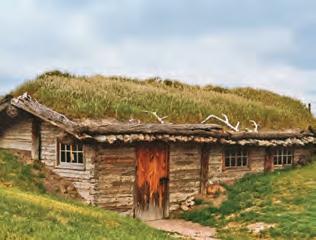
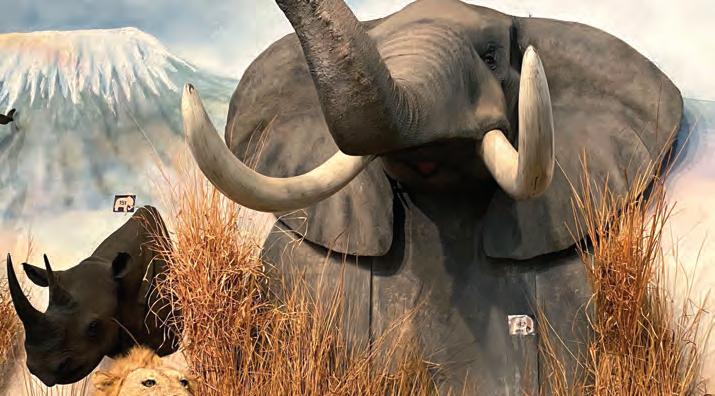
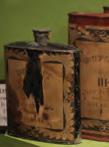
Russian
Parchment
Andrew
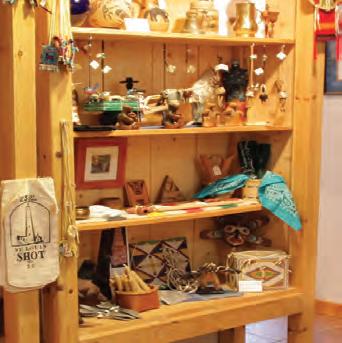

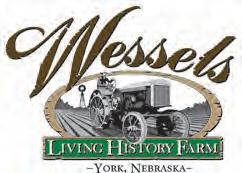
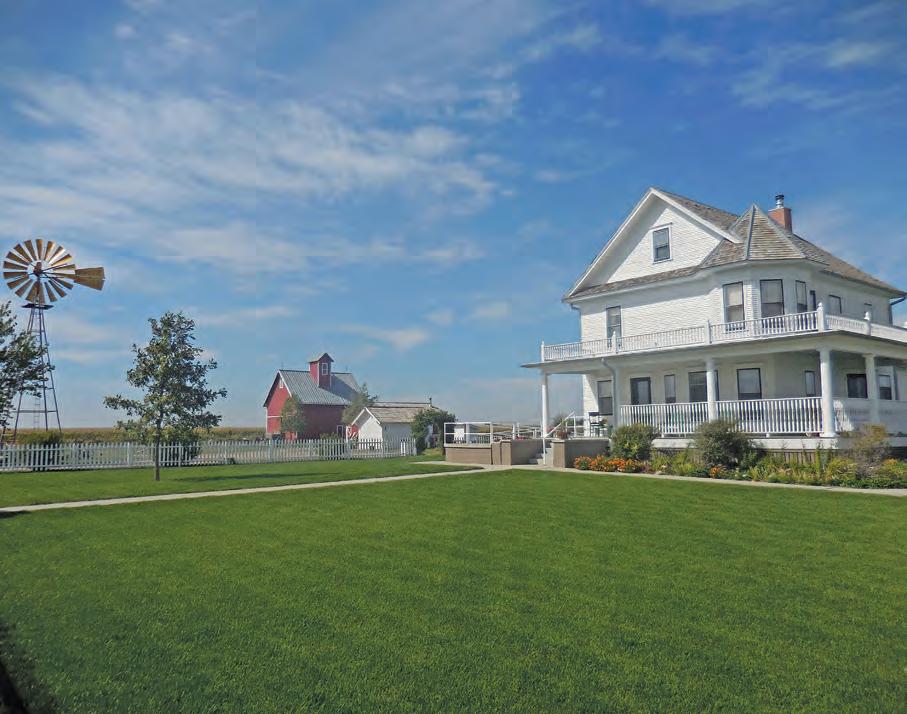
Art on the Farm Sunday, Sept. 15 • 1 4 pm Angie Kriz and the Polka Tunes Friday, Oct. 18 • 7–11 pm
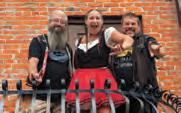
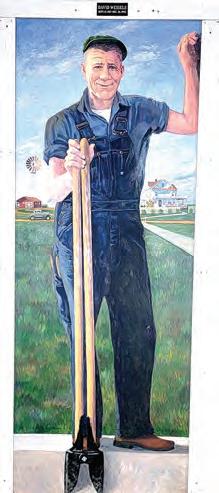

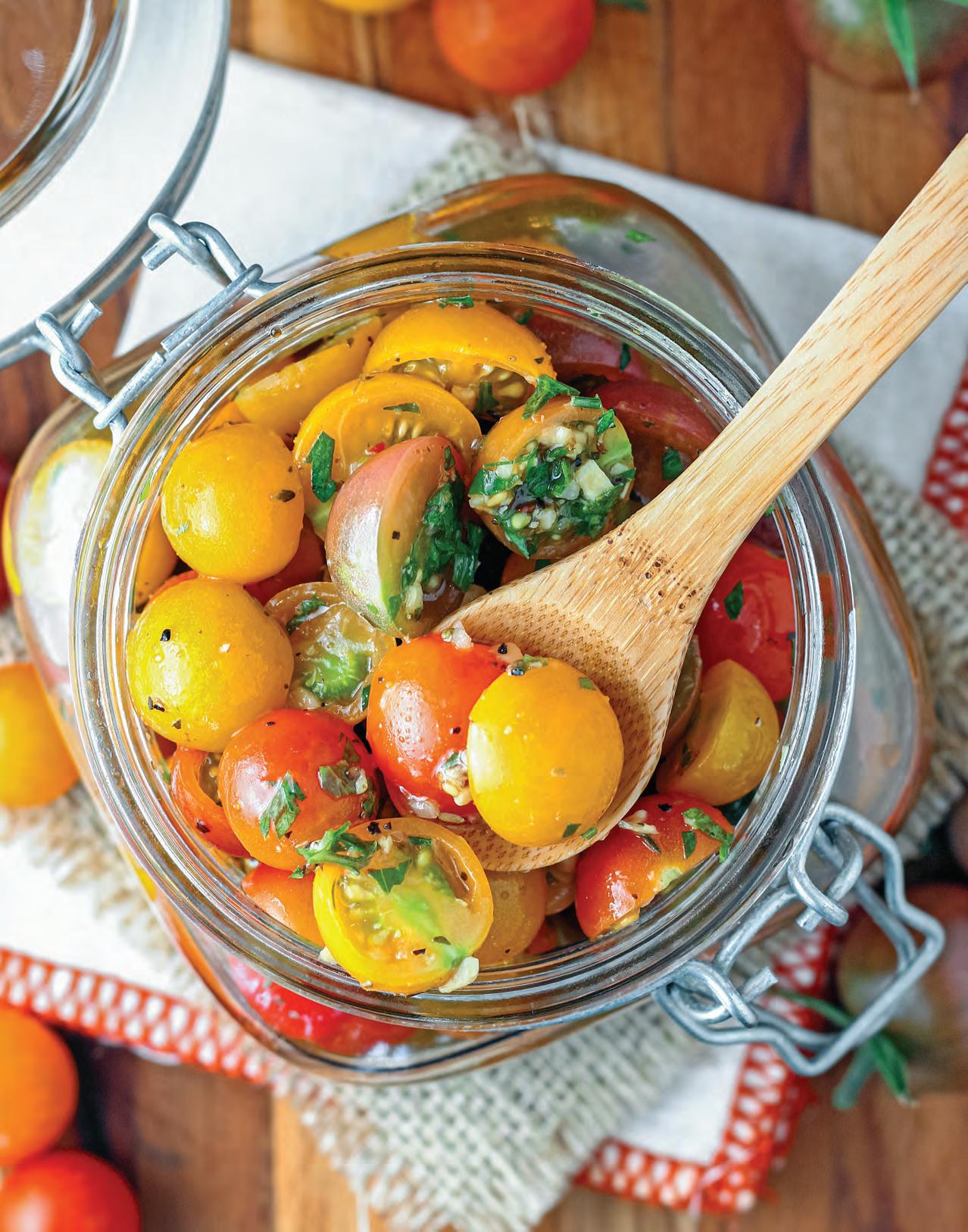
Run toward, not away from these explosively flavorful cherry tomato recipes.
recipes and photographs by DANELLE McCOLLUM
CHERRY TOMATOES GROW fast in the summer months, their vines heavy with fresh, bite-sized fruits. Though known for their petite size and bright red colors, cherry tomatoes can also be orange, yellow, green, purple and black. They make quick, finger-food snacks right off the vine and add fresh tartness to these recipes.
Whip up a batch of these marinated tomatoes in about 15 minutes and enjoy them for several days on salads, with pasta, over grilled chicken or eaten straight from the jar with a spoon.
In a large bowl, whisk together olive oil, vinegar, garlic, Italian seasoning and parsley. Gently stir in cherry tomatoes.
Season with salt and pepper, to taste. Transfer to a covered container and marinate for at least 2 hours. Refrigerate if marinating longer than two hours; the flavor will only get better the longer they sit. The olive oil may solidify in the refrigerator; serve at room temperature.
4-5 cups cherry tomatoes, halved
1/2 cup olive oil
1/4 cup white wine vinegar
2-3 cloves garlic, minced
1 tsp Italian seasoning
1/4 cup chopped fresh parsley
Salt and pepper to taste
Ser ves 8

For presentation, consider using tomatoes in a variety of colors – red, yellow, orange and purple. Slice a tiny bit off the bottom so they sit flat and don’t roll away.
Cut a thin slice off the top of each tomato. Scoop out the pulp and discard. Invert the tomatoes onto a paper towel and allow to drain for about 30 minutes.
In a medium bowl, combine bacon, mayonnaise, Parmesan cheese, red pepper, green onion, parsley, salt and pepper.
Generously stuff each tomato with bacon filling. Cover and refrigerate for at least one hour (and up to three hours) before serving.
2 10-oz packages cherry tomatoes
6 slices bacon, cooked crisp and crumbled
1/2 cup mayonnaise
1/4 cup Parmesan cheese
1/4 cup finely diced red pepper
2 green onions, chopped
1-2 Tbsp chopped fresh parsley
Salt and pepper to taste
Ser ves 12-14
Bruschetta is a tasty – and healthy – appetizer, light lunch or dinner. Pair with a nice green salad on those hot summer days without using the oven for too long. Choose ripe tomatoes; they should be fragrant.
In a large bowl, toss together tomatoes, garlic, onion, basil, lemon juice, olive oil and salt and pepper, to taste.
Cover and refrigerate for at least one hour, or even better, a day or two.
Serve on slices of toasted baguette or Italian bread. Garnish with additional fresh basil, if desired.
2 pints cherry tomatoes, halved
3-4 cloves garlic, minced
2 Tbsp minced red onion
3/4 cup loosely packed fresh basil leaves, chopped
1 tsp lemon juice
1/4 cup olive oil
Toasted baguette or Italian bread slices for ser ving Salt and pepper to taste
Ser ves 12

WE’RE RAVENOUS TO taste (and publish) your favorite family recipes and stories that accompany them. Send recipes and stories to kitchens@nebraskalife.com or to the address at the front of this magazine.
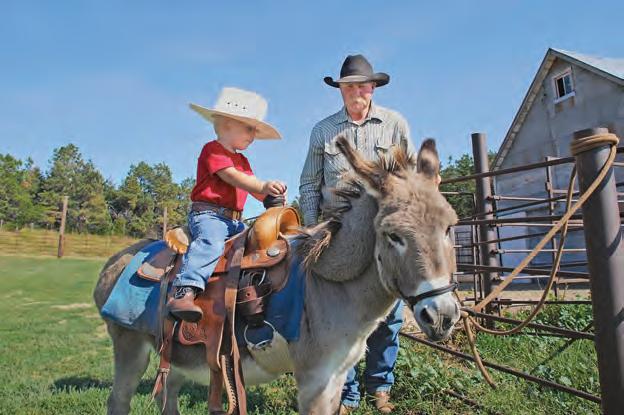
Home could be the four walls of an apartment, following trails on horseback, downtown dinner with friends or the muddy road up to the family ranch. Our poets share stories about coming back to people, places and memories that make Nebraska home.
Debbie Flower, Omaha
She waits at the airport with grandma and grandpa
Hopping from foot to foot, looking for her daddy’s plane, He has been gone for such a long, long time She runs over to the window and sees it has started to rain.
The passengers start to deplane
Her grandparents move forward in this strange place.
She doesn’t know why they are acting so strange All of a sudden, she sees her daddy’s face.
She doesn’t notice that he is in a chair, she doesn’t notice the many scars
He tries to talk to her in a mumble she laughs and says,
“That’s ok daddy, grandpa always says as long as we pray and stay humble
We can get through anything!”
Gary Tillman, Lincoln
An old military hospital
Now a home for welfare families, Air Force personnel, Nebraska football players, etc.
Filled with ramps
Those of which may never Again be seen.
Ramps connecting Court to court,
Store to store,
To all places in Huskerville. They brought steam and heat
Both to families and the barracks
Keeping the cold at bay.
Now the ramps are gone
And so is the community
But though Huskerville and the ramps are gone They still hold a place on the map today.
Ruby Schow, Paxton
Coming home to the house in the cottonwood trees, To the copper mailbox where letters were sent, Where the crabapple blossoms brought swarms of bees, And the hammock where hours reading were spent.
Coming home to the garden of dark rich soil, Where my eager hands planted onions and potatoes, Where Mama brought forth with patient toil,
The canned goods that brought us through the winter, Green beans, pickles, and tomatoes.
Coming home to memories of bygone days, Playing hide-and-seek-tag under star filled skies, Handmade costumes for self-written plays, Hot days picking cherries for cherry pies.
Coming home to the dog toys on a shelf, Half-forgotten, the memory of a cold, wet nose, Just a picture now, she will not greet me herself, The puppy I dressed in my dolly’s clothes.
Coming home to all the things I miss, That the outside world can never be, My brother’s teasing, my mama’s kiss, Coming home to the things that made me, me.
Wayne Choat, St. Edward
Spring rolls ’round with subtle warm winds,
Winter recedes and the snow changes state,
Leaving behind the winter’s dead,
The Lord breathes life and says, “It’s time to begin.”
The farmer is stirred within to breach the new year,
The soil asks quietly for something to grow,
The planter clicks along, making it count,
The seed drops in the soil, the V never more true,
But dark storms crash against the horizon,
And lightning rips and tears the sky,
Soon the rain will chase him from the field,
But he persists and pushes to finish the task,
Just one more round, he says to himself,
Just one more round, that’s all I need
Just one more round, my work will be done,
Just one more round, I can head home,
Where I can rest.
Summer rolls ’round with a blast of furnace winds,
Spring collapses and is gone with a faint whimper,
Leaving only the memory of its warm caress,
The Lord reminds him this is where the real work begins.
The farmer is given the strength to face the assault,
The plants beg earnestly for the water to keep them alive,
The ridger creates the furrows for the water to flow,
Where it will drown the shadows in each plowed valley,
But the heat is brutal, unwilling to relent,
Hot and fierce, sapping the life from his fragile crop,
Soon the drought will cause it to wilt and die,
But he persists and pushes to finish the task,
Just one more round, he says to himself,
Just one more round, that’s all I need,
Just one more round, my work will be done,
Just one more round, I can head home,
Where I can rest.
SEND YOUR POEMS on the theme “Around the Table” for the November/December 2024 issue, deadline Sept. 15, and “Forever Love” for the January/February 2025 issue, deadline Nov. 15. Email your poems to poetry@nebraskalife.com or mail to the address at the front of this magazine.

Fall rolls ’round bringing relief in its crisp coolness,
Summer fizzles and fiery winds persist no longer,
Leaving only the scars of another battle fought,
The Lord is pleased and nods for harvest to begin.
The farmer’s gratitude bounds knowing this crop is nearly done,
The fields have turned mature and golden,
The combine rumbles and lumbers through the field,
Gathering in the bounty that started months ago,
But the sun falls low and soon there will be ice,
Cold and harsh it will drag the grain down,
Threatening to rob him of his reward,
But he persists and pushes to finish the task,
Just one more round, he says to himself,
Just one more round, that’s all I need,
Just one more round, my work will be done,
Just one more round, I can head home,
Where I can rest.
Winter rolls ’round and there is peace to behold.
Fall is ushered out as easily as it arrived,
Leaving only the leaves to float in the wind.
The seasons are complete.
The farmer reflects upon what he has sowed,
And what he has reaped.
The years have been hard,
This past one has been no exception.
His bones are weary, and his mind is tired.
His youth has long been spent.
With feeble anticipation, he looks to spring and another round around the sun,
The Lord smiles with soothing Grace at his desire to push and persist.
“That was your last round,” the Lord says to him,
“That was your last round, you have finished all I need,”
“That was your last round, your work for Me is done,”
“That was your last round, I’m bringing you Home,”
“Where you can rest.”
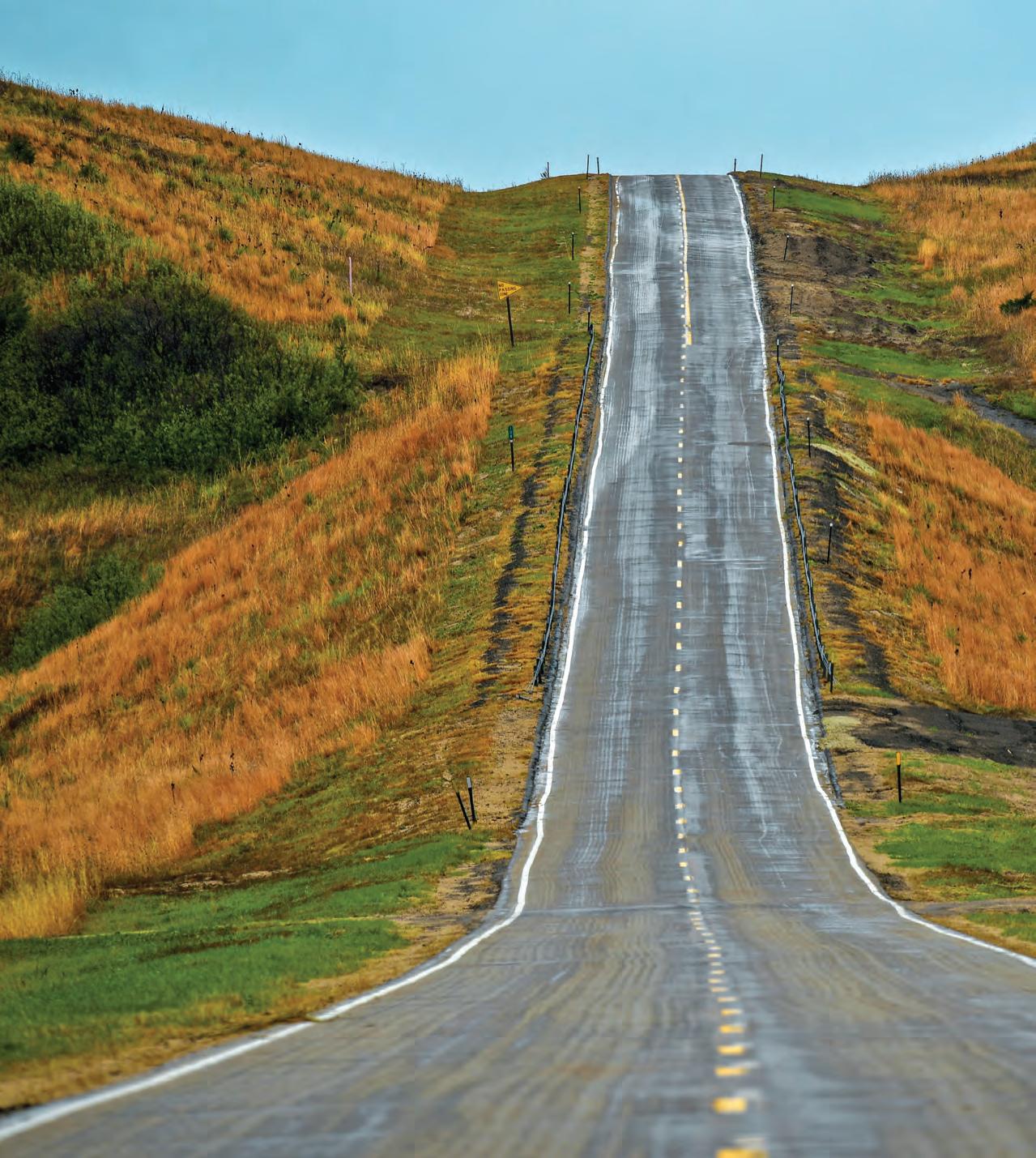
Dennis once said that in the Nebraska Sandhills, “men are men, and so are the women,” because of the toughness required.

by JANICE GOLKA
TED AND I placed Dennis’ 3-inch square box into a 4-inch square Rubbermaid dish and belted him securely into the backseat of our Subaru Outback. We pulled out of our west-central Iowa driveway and headed west – to Northwest Nebraska.
Dennis had lived with us on Ted’s desk for 12 years. Dennis wanted his ashes divided into five parts: One for his wife; one each for other hunting buddies in Michigan, Wyoming and Illinois; and one for Ted to take to Chadron. Dennis wished for his ashes to be spread over the places where he found such happiness, had a tremendous time, and where he enjoyed the beauty in nature.
After medical issues with family members and the death of parents, one year bled into the next. We realized that Dennis had been living with us for 12 years on Ted’s desk.
I made the comment to Ted, “You do realize Dennis has lived with us for a dozen years now and has not paid any rent?”
Ted responded with, “Yeah, well, he never complains, has been a quiet house guest and doesn’t eat anything.”
I replied, “I think it’s time Dennis goes to where he wanted to be.”
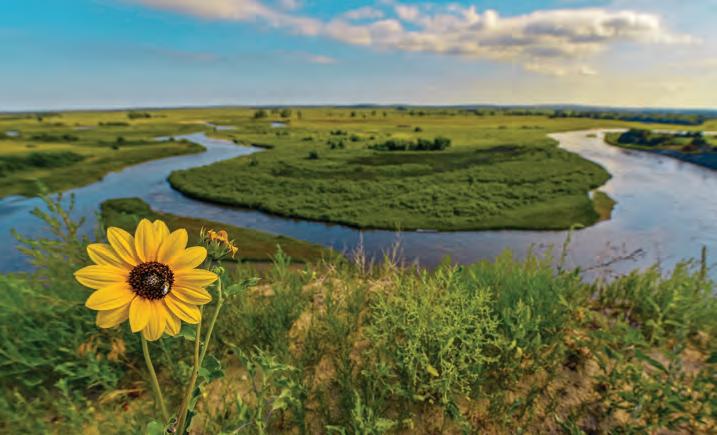
WE WANTED DENNIS’ trip through Nebraska to be a scenic one, so we drove on the state highways instead of the interstate. We meandered through small towns we hadn’t seen in a while. When we got to Humphrey, we unstrapped Dennis and had lunch at Mugs & Jugs. From there, our destination for the first evening was Burwell, known for Nebraska’s Big Rodeo.
After we checked into the historic 1908 hotel, Sandhills Suites, that has since been remodeled into a very nice boutique hotel, we headed over to show Dennis the Villagers of Taylor. The Villagers are lifesized people cut out of plywood, painted in black and white to look like people who would have lived, worked and played in the town between 1890 and 1920 when Taylor was at its peak.
It was now time for dinner, so we headed back to Burwell and ate at Lowe’ded Bar & Grill – of course, Dennis joined us
for dinner and drinks. We walked back to the hotel, had a nightcap with Dennis and settled into bed.
After eating a filling breakfast at The Spot in Burwell, we loaded up the suitcases, strapped Dennis into the backseat and headed north up Highway 183 to Bassett where we jumped on Highway 20 west to Valentine.
As you travel out of Bassett, you begin to realize that Nebraska has a vast openness. You begin to see the beautiful rolling hills – and suddenly, in the middle of all these rolling hills, you fall upon Long Pine, which looks like a true oasis of tall, beautiful pines.
The trees are there – and then they are gone. The rolling hills begin to turn into larger sand hills.
As I gazed out of the car window, watching the beautiful landscape speeding by me at 70 mph, I realized Nebraska
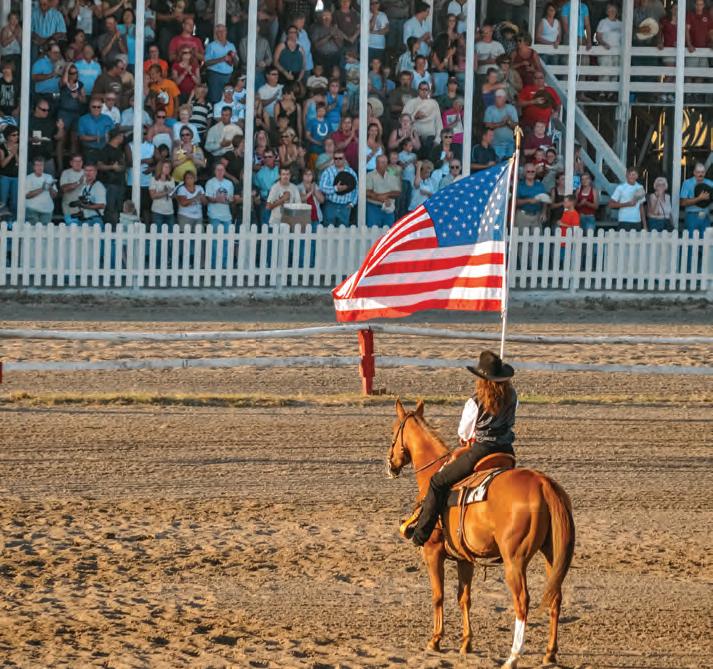

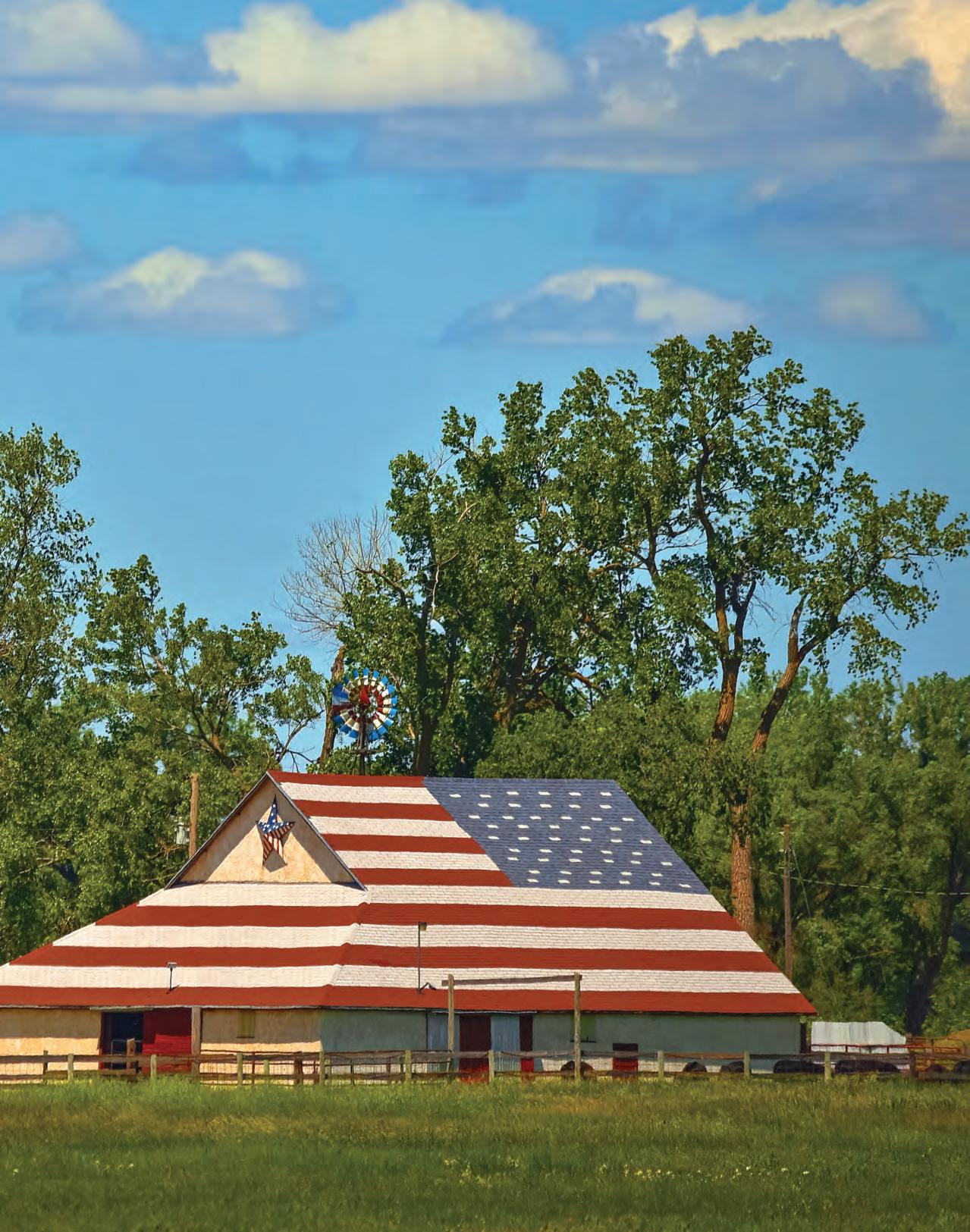
isn’t just Omaha or Lincoln, it was this: This area. This beauty that so many people don’t even know exists. The harsh winters, the hot summers, the long drives from one small town to the next. Ted told me that he and Dennis would joke and say, “The Nebraska Sandhills are where men are men, and so are the women, because, to live in this area takes a special mindset to be tough, strong and determined.”
Just east of Valentine, you pass over the Niobrara River and when you look to the north, you see an amazing old railroad bridge that has been converted to a biking/hiking bridge on the Cowboy Trail. The vista is breathtaking, and I found myself saying out loud, “This is God’s country. No wonder Dennis wanted to have his ashes spread here. It is heaven on Earth.”
When we arrived in Valentine, we made
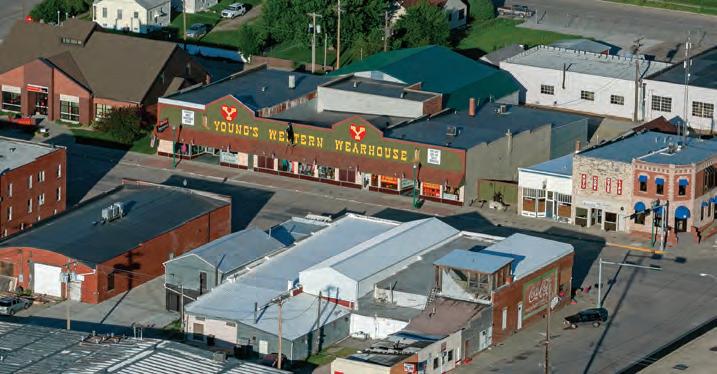
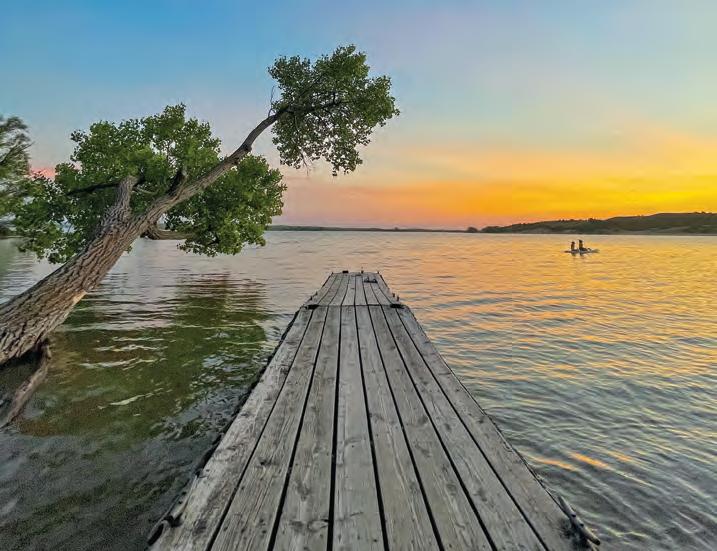
sure to stop at Young’s Western Wear one last time. This store is where Dennis bought his first and only cowboy hat. For a native Chicagoan, that was a big deal.
And, of course, we had to stop at his favorite place to eat in Valentine, which is the Bunkhouse Restaurant and Saloon. Once again, we strapped Dennis into the backseat for the final two-hour drive to Chadron.
We arrived at the city limit sign of Chadron. I brought Dennis up to the front and placed him – with honor – on the dashboard so he could see he was almost at his destination. As we drove through Chadron, Ted was amazed at the new growth in the past 13 years. The west end of town has added many new businesses.
We arrived at the Holiday Inn Express & Suites, and the front desk manager, Craig, got us all checked in. As he handed us our key cards, he asked what brought us to Chadron. Ted and I looked at each other, smiled and proceeded to tell Craig about our adventure with Ted’s hunting buddy, Dennis, and that we were going to find Dennis’ secret hunting spot and spread his ashes there. Craig was emotionally moved by our mission and said he thought what we were doing for our friend was a wonderful story.
WE TOTED OUR luggage into our room, headed back down to our car and placed Dennis, front and center, on the dashboard. This would be his last drive south down Highway 385.
As we neared the turnoff and headed down the dirt road, we saw the front entrance to his spot was now blocked off, so we drove further down the highway to come at it from the back way. As we drove down the rutted, dirt path and up and down the hills for what seemed like miles. Ted said we were getting closer to the spot.
It had been 13 years since he had last been there, and things looked different. The damage from the Pine Ridge fire of 2012 gave the landscape a completely different look. Many of Ted’s visual clues were no longer available. Ted said, “Over this hill, the path should curve to the left.” And it did. We were getting close.
As we made our way deeper into the forest, the path became steeper, causing
us to go much slower. We had not seen signs of any type of animal while on this path, but as we came down this hill, on the west side of the path stood a doe, facing us, staring at us, as if she was waiting for our arrival.
She ran slightly up the hill and turned to face the other direction as if pointing the way for us. And, sure enough, as we rounded the turn in the road, Ted said, “Here it is. Here is where Dennis entered his hunting spot.”
We got out of the car, grabbed the bottle of Polish Potato Vodka (Dennis was Polish and he loved vodka) and three Dixie cups. We cut three slices of poppyseed bread, which was Dennis’ favorite.
Ted picked up Dennis from the dashboard, brought him out to the spot and Ted told him we were here. Ted opened the 4-inch Rubbermaid container, re-
moved the box, and he took out his pocketknife to cut the tape from the 3-inch square box.
Inside, wrapped in tissue paper, was a small, well-sealed 2-inch square tin. Goodness, for a moment, poor Dennis had become a Russian nesting doll set: a 2-inch tin inside a 3-inch cardboard box inside a 4-inch Rubbermaid dish. It’s all very comical. Dennis would have loved it.
Ted said a few thoughtful and meaningful words. He proceeded to scatter Dennis’ ashes to the ground with an ever so light breeze that carried Dennis away.
Ted took his shot of vodka; I took mine; and Ted poured Dennis’ shot over the ground. Dennis was finally where he wanted to be.
We each ate a piece of poppyseed bread and laid Dennis’ piece on the ground next to the amethyst stone I placed as Den-
nis’ marker. This gift he gave me so many years ago, I was now giving it back for all eternity.
We got back into the car and headed out the same way we came in. Ted was sharing the story with me about how he and Dennis loved to go grouse hunting in the Merritt Reservoir/Samuel R. McKelvie National Forest area when no more had Ted finished his story that we saw something flying from west to east in front of our car.
It was a single grouse in flight, as if Dennis was saying, “Thanks. I’m happy.”
The rest of the way out of the national forest, we did not see another deer or another grouse or any other animal. This is when I know there is a God – a Higher Spirit – that watches over us. We truly believe this was a sign from Dennis telling us, “All is well.” Dennis’ journey was now over, and Ted’s duty was now complete.
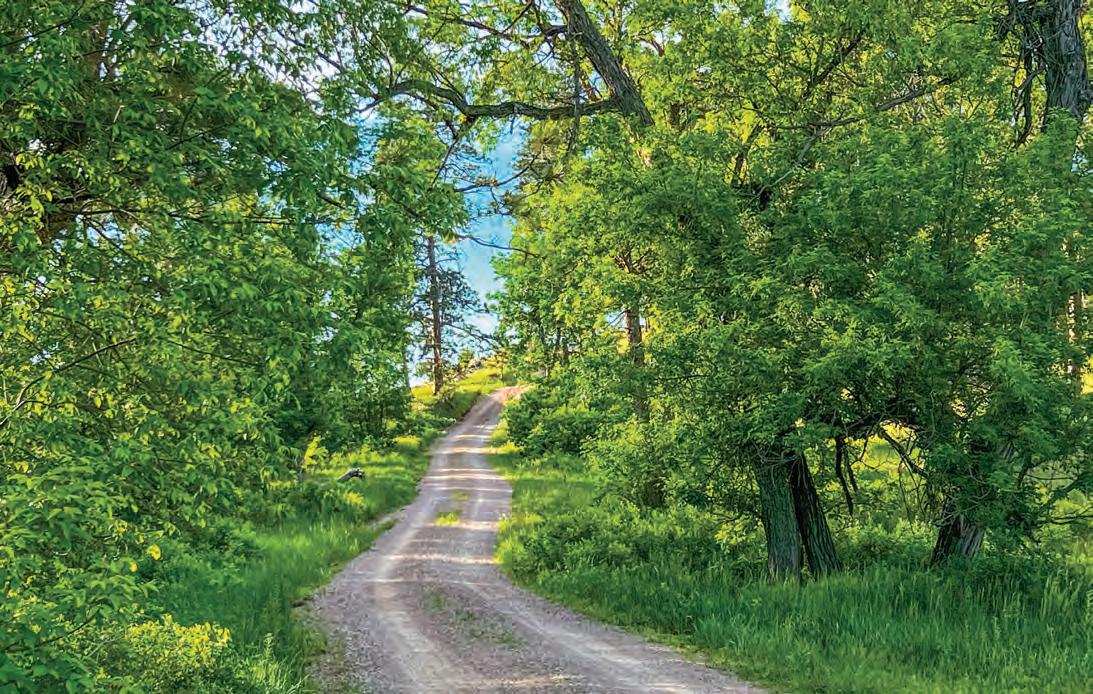
by TOM HESS
Otoe County in southeastern Nebraska is the apple of Nebraska’s eye, the top county producer of Gala, Fuji, Pink Lady, Honeycrisp, Granny Smith and Jonathan apples. The moist air from the south and the fertile alluvial soils of the Missouri River nourish the orchards.
Also known as the Home of Arbor Day, Nebraska City has celebrated the fall apple harvest with the AppleJack Festival for over 50 years. This September, up to 80,000 people are expected to celebrate all-things apple during the festival’s two weekend celebrations.
Water nourishes the area’s apple trees and supplies the festival’s entertainment, including a beloved water barrel fight. Opposing teams use fire hoses to move
wire-suspended metal barrels 20 feet above the street to a goal point. First weekend events also include the AppleJack Fun Run, bull-riding tours, downtown flea market and classic car show.
During the second weekend, adults enjoy a downtown cider stroll through the city while children explore the Apple Jamboree: a children’s event with a petting zoo, rides, games, face painting, a public art project and more.
Arbor Day Farm, Union Orchard and Kimmel Orchard & Vineyard are open special hours all weekend. Kimmel Pavilion offers fresh apple goods – pies, donuts, cookies, caramel covered and cider slushies. Apple lovers pick out their own selection at the Kimmel U-Pick Barn.
Up to 80,000 people are expected at Nebraska City’s annual AppleJack Festival this September.
Enjoy an apple pie slice with the works – ice cream and caramel – apple cider slushies and exquisite protein: brisket, pulled pork, sliced chicken and burnt ends. 2611 Arbor Ave. (402) 873-8777.
Kimmel Orchard founder Richard Kimmel grew up in Nebraska City, graduated from high school in 1915 and established the orchard in 1925. The festival began as a spring apple blossom celebration, but the timing was unpredictable, so local Jack Brawner recommended a harvest season, with its reliably temperate, dry conditions. Nebraska City businesses readily approved the change, and the town launched AppleJack in 1968.
Brawner proudly rode the “All Jack” parade float, which exclusively featured people with the name “Jack,” until his death at age 91 in 2021. The grand parade starts on Central Avenue at 1 p.m. on Sept. 21. nebraskacity.com/festivals

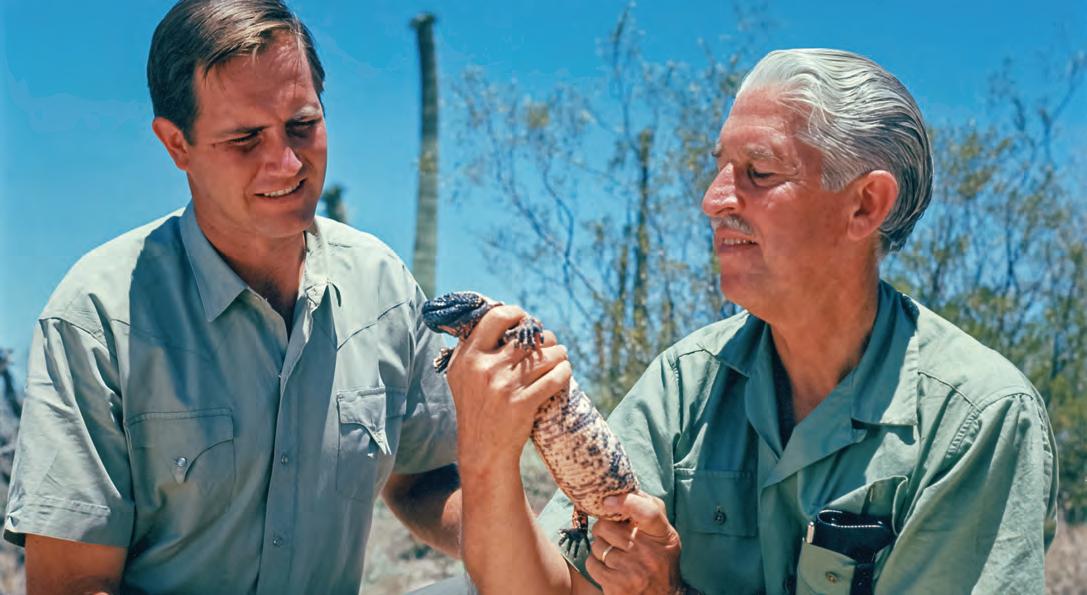
THROUGH OCT. 13 • OMAHA
The Durham Museum, housed in Omaha’s art deco Union Station, exhibits the history of the pioneering television program Mutual of Omaha’s Wild Kingdom. Premiering on NBC in 1963 with hosts Marlin Perkins and Jim Fowler, and later joined by Peter Gros, the show ran until 1988 and won four Emmys from the National Academy of Television Arts and Sciences.
Mutual of Omaha’s Wild Kingdom featured wild encounters with animals in their natural habitats, accompanied with expert commentary from Perkins, a naturalist, and Fowler, a zoologist. For many viewers, the Sunday night show was a first: experiencing hands-on encounters with wildlife, learning about the importance of conservation.
A memorable highlight of the TV show includes an episode which first aired Jan. 14, 1968, which presented Perkins’ wrestling match with a 100-foot-long, 200-pound anaconda as he tracked down the giants of Dadanawa in Guyana, South America. Perkins, joined by Stan Brock,
wrestled against the snake’s coils, avoiding its sharp teeth while in waste-deep waters. The two eventually took advantage of the snake’s fatigue and worked the animal into a bag for later observation.
In October 2023, Mutual of Omaha’s Wild Kingdom Protecting the Wild premiered as part of the network’s “The More You Know” programming on Saturday mornings. Peter Gros has returned as a co-host alongside Dr. Rae Wynn-Grant to continue the wild kingdom legacy, focusing on conservation successes across the nation.
Museum guests watch Perkins and Brock wrestle the 200-pound anaconda as part of the exhibit’s several interactive displays with video clips from the original and current series. The exhibit also showcases behind-the-scenes photographs, original scripts and equipment used during filming of the first series.
Mutual of Omaha was founded in 1909 by Clair Carlton Criss, a medical student at Creighton University who paid for his education by selling insurance, and is now a Fortune 500 company.
Jim Fowler and Marlin Perkins co-hosted the original Mutual of Omaha’s Wild Kingdom television show.
The restaurant was once a boiler room, sealed in steel posts and girders, brick walls and reinforced concrete ceilings, that supplied heat for the 120-yearold Bemis Bag Building. The restaurant worked to preserve the room’s “romantic state of decay, the varied texture of aging and weathering.”
Chef Tim Nicholson is an Omaha native and showcases local growers, such as Lincoln farms Shadow Brook and Branched Oak. 1110 Jones St. (402) 916-9274.
Built in 1930 as the Redick Tower, a brick and terra cotta office building, the structure became a full-service hotel in 1989 and Hotel Deco in 2010. The rooms include powder-coated gold Art Deco-era closet doors and watercolor wallpaper. The carpet under each bed displays an upside-down glimpse of clouds and sky for an “Alice in Wonderland” effect. 1504 Harney St. (866) 475-3326.
Nelson Produce & Farm
Sunflower Festival
Through Sept. 8 • Valley
Explore over 300,000 sunflowers in Nebraska’s first U-Pick sunflower field. Enjoy live music, homemade sunflower goods and local foods. Couples indulge in a sunset picnic with farm-baked goods. 10505 N. 234 St. (402)830-0567.
Scatter Joy Acres Petting Zoo
Through Oct. 31 • Murray
The 15-acre ranch is home to 88 animals, offering Animal Assisted Therapy for those with developmental disabilities, at-risk youth, seniors and veterans. Twice
a year, Scatter Joy Acres offers a petting zoo with chickens, cows, donkeys, llamas, alpacas, goats, ponies – and even a camel. 4107 Waverly Road. (402) 709-9401.
Gravel National Championships
Sept. 8 • Gering
In this USA Cycling event, elite riders will race 131 miles on unpaved roads in Landmark County. Winners stand to win a $40,000 prize purse. (719) 434-4200.
Husker Harvest Days
Sept. 10-12 • Wood River
The world’s largest irrigated working farm show offers live demonstrations of the latest innovations in farming equipment. Meet with their designers,


technicians and engineers of tillage techniques, GPS, live cattle handling, cattle chutes and animal health products. 9000 W. Husker Hwy. (308) 384-4646.
Heritage Day
Sept. 14 • Henderson
Mennonite immigrants from Russia settled in Henderson in 1894. Their migration is celebrated annually with ethnic food, demonstrations and live music.
Interactive events include hands-on rope making, apple pressing, outdoor Russian oven bread baking, glass etching and butter making. 720 Road B. (402) 723-5694.
Art on the Farm
Sept. 15 • York
Wessels Living History Farm is a working farm where visitors can help shell corn and pick tomatoes. During Art on the Farm, local art is on display. 5520 S. Lincoln Ave. (402) 710-0682.
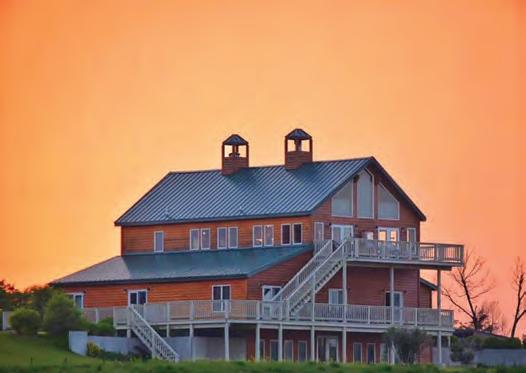

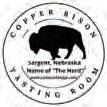
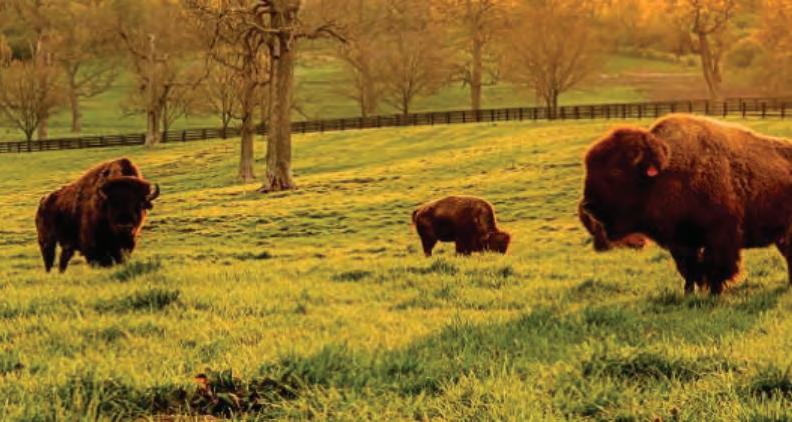

A House Divided
Sept. 17-24 • Lincoln
Christina Kirk, a professor of theater at the University of Nebraska-Lincoln, brings a new play to the stage about Abraham Lincoln’s choice to bring Emilie Todd Helm to the White House after refusing the pledge allegiance to the Union. Based on real events, the play follows the president’s choices that threaten his family. Lied Center for the Performing Arts, 301 N. 12th St. (402) 472-4747.
Our Call to Discipleship
Sept. 19-20 • Schuyler
Christ the King Priory, a missionary Benedictine monastery, celebrates the lives of saints, those known and unknown who have reached their eternal reward. Through prayer, reflection and sharing, participants explore how to journey through their lives. 1123 Road I Annex. (402) 352-2177.
Family Festival
Sept. 20-21 • Norfolk
This annual tradition celebration of Bavarian beer features a family-friendly bounce house row, wiener dog races, cornhole tournament and kids’ Big Wheel tricycle races. 609 W. Norfolk Ave. (402) 371-0182.
Sept. 21-Oct. 27 • Avoca
Visit the family farm and celebrate 20 years with hayrides, U-pick pumpkin patch, a 40-foot tube slide, nature trails, farm animals, restaurant and gift shop. Admission is $10. 911 108th St. (402) 840-2207.
Jaunt
Sept. 27-29 • North-central Nebraska
This three-day excursion through 35 towns and villages in north-central Nebraska, about 500 miles along highways and byways, leads participants to
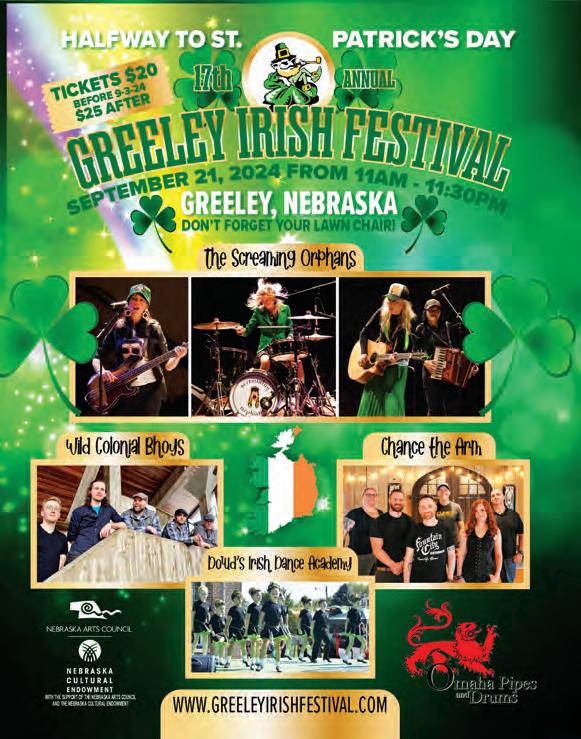
treasures of every type and condition. The $10 Shopper Guide details registered vendors’ addresses on town maps, recommended lodging and restaurants and nearby historical sites. (308) 346-5151.
Monument Marathon
Sept. 28 • Gering, Scottsbluff
For this Boston Marathon qualifier, 5k and marathon racers run along part of the Oregon Trail through Mitchell Pass and around Scotts Bluff National Monument. The full marathon begins in Wildcat Hills State Recreation Area, leads into Gering Valley and circles the Scotts Bluff National Monument along trails only open for the race. Races start at 7:30 a.m. (308) 630-6550.
Fall Flea Market
Sept. 28-29 • Brownville
More than 200 vendors line the streets of Historic Brownville. Find antiques, collectibles and local goods. (402) 825-6001.
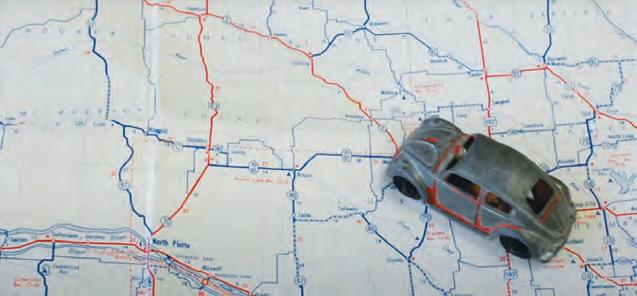
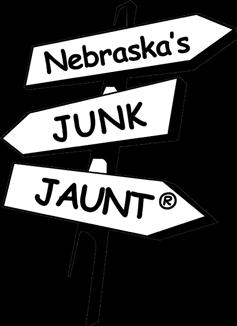
Trail of Treasures
Oct. 4-6 • Highway 136
From historic Brownville along Highway 136 to Edison, and Highways 6 and 34 to Haigler, communities host yard sales for this three-day event. The shopping guide features 17 counties with must-see stops and shops. (255) 352-6258.
Harvest Moon Festival
Oct. 5-6 • Chadron
This two-day event at the Dawes County Fairgrounds features a Hangry Cow 5k race, goat roping, costume contest, beer fest, face painting, a haunted maze and more. 2009 E. Gordon St. harvestmoonfallfestival.org.
Harvesting 1824 Style
Oct. 5-6 • Fort Calhoun
At Fort Atkinson State Historical Park, the 1820s outpost comes alive with living history activities and demonstrations.


Watch a bison butchering demonstration and see how the post prepares for the arrival of Brig. General Atkinson. A Nebraska Park entry permit is required. 201 S. 7th St. (402) 468-5611.
Charlotte’s Web
Oct. 11-13, 18-20 • Lincoln
Follow Wilbur’s story of love, friendship and sacrifice as he hopes to win a prize at the fair. Based on the book by E.B. White. Lincoln Community Playhouse, 2500 S. 56th St. (402) 489-7529.
Old Time Autumn
Oct. 12-13 • Brownville
Visit Nebraska’s oldest town to celebrate Gov. Robert Furnas’ 200th birthday. Witness civil war reenactments with skirmishes, battles and cannon fire. Enjoy buggy rides, art galleries, museums and shops throughout Main Street. Don’t miss the chicken and biscuit dinner at town hall. (402) 825-6001.
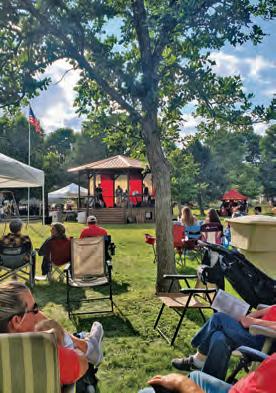
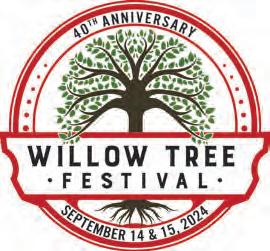
Hallowfest
Oct. 12, 19 • Ponca
Come to Ponca State Park and carve pumpkins, trick or treat, pumpkin rolling, decorating contests – and even a pet costume contest. (402) 755-2284.
Carson Tonight
Oct. 24 • Norfolk
Celebrate what would have been Johnny Carson’s 99th birthday. Pat Hazell hosts with performances from the UNL Jazz Orchestra, magician Lance Burton, and more. Afterwards, tour the Johnny Carson Gallery at the Elkhorn Valley Museum. (402) 644-2529.
The Orchestra Moves
Oct. 27 • Lincoln
Enjoy free face painting, an instrument petting zoo and more to learn how music moves. Performance by the Lincoln Symphony to follow. Lied Center for Performing Arts, 301 N. 12th St.

Questions on p 20-21
1 South Sioux City
2 Brownville
3 Newfoundland
4 Prairie dogs
5 Pvt. George Shannon
6 True
7 False (this happened in North Dakota, not at Bow Creek)
8 False (it was named after Louis Fontenelle)
11 b. Leary Site
12 c. Ionia
13 c. South Dakota
14 a. An Omaha leader known as Blackbird is buried there
9 True 10 False (“Nebraska” is based on an Oto Indian word “Nebrathka” meaning “flat water,” referring to the Platte River)
15 b. 80 feet
Page 20, Top Fontenelle Forest in Bellevue.
Page 20, Bottom Wooden sculpture of Pvt. Shannon in Wynot.
Page 21 Gavins Point Dam near Crofton. Trivia Photographs
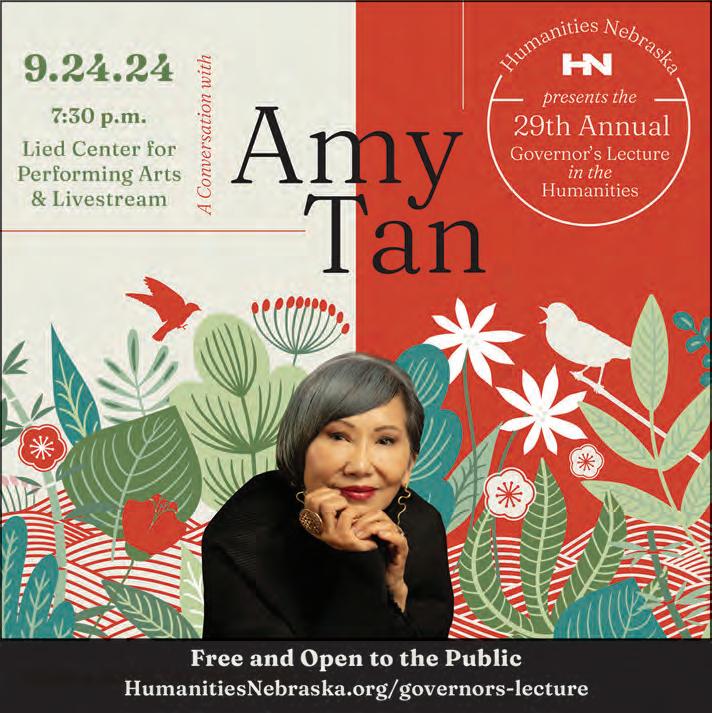
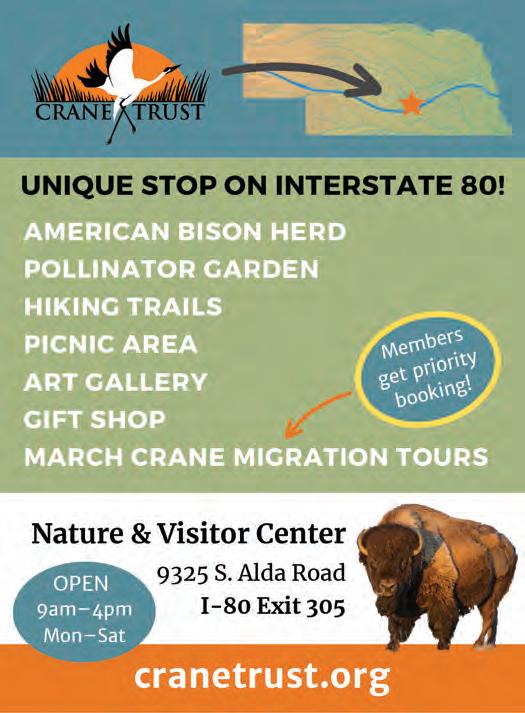
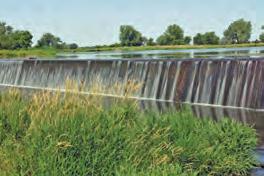
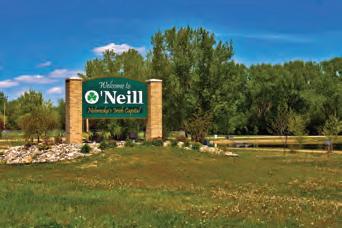
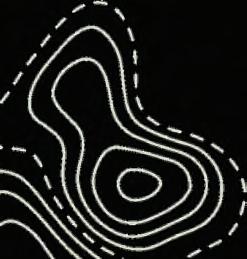



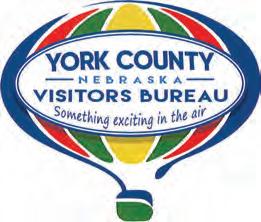
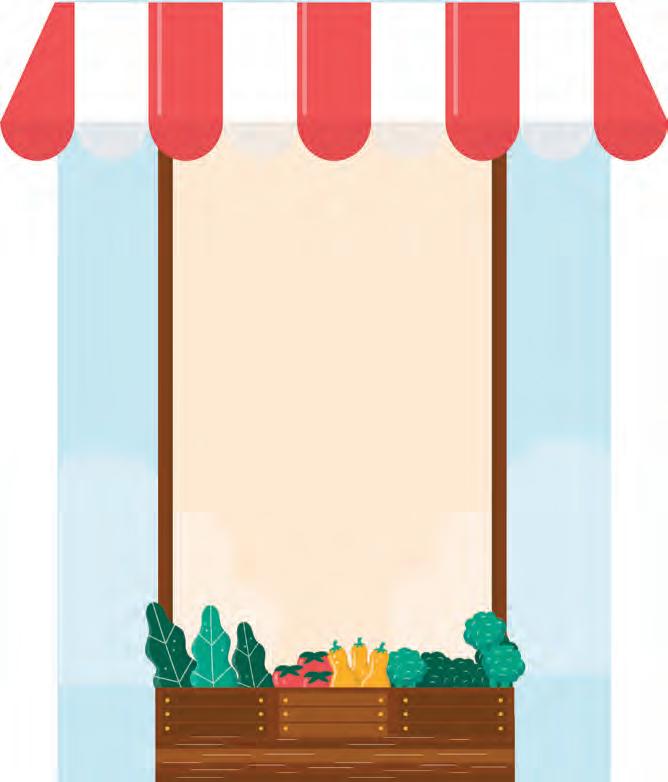
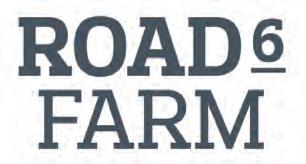
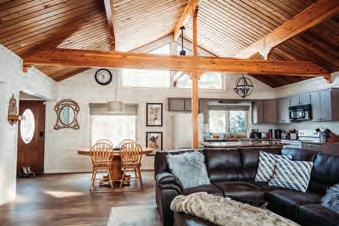



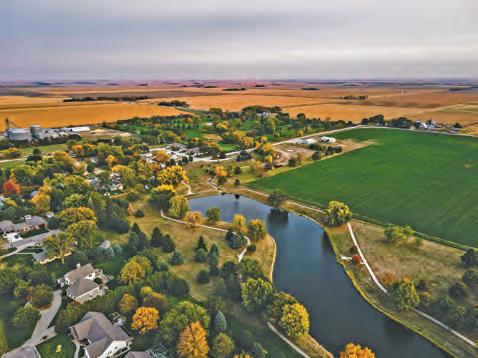
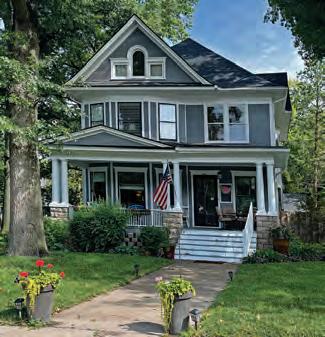




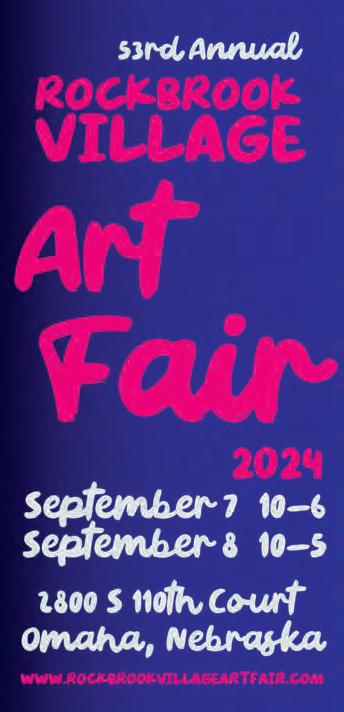
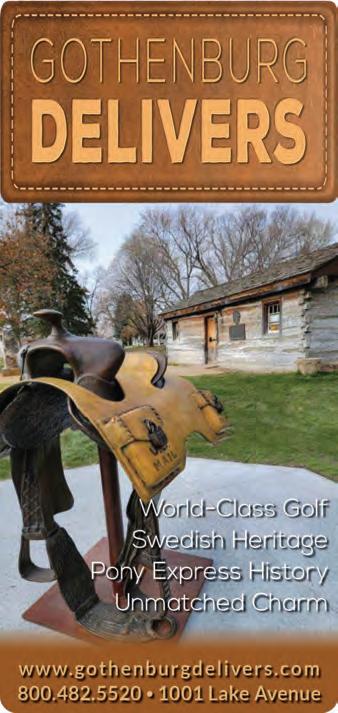
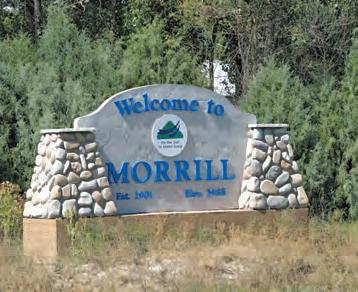

Morrill Village has everything a family vacation needs. Just 20 minutes from the bustle of Scottsbluff, you can hit the range at the public 9-hole golf course, go for a dip at the community swimming pool, stroll through the city park or pick-up a tennis match at the courts. And don’t forget to pack your tackle box and poles for some fishing at the sand pit ponds!
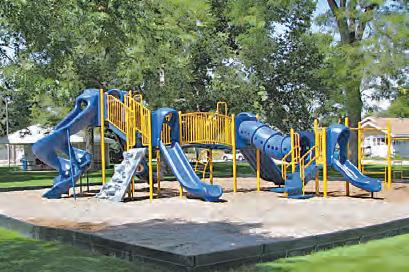
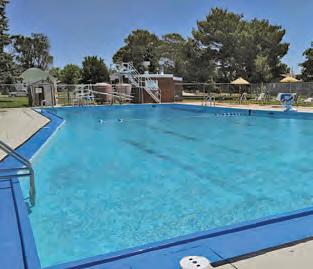
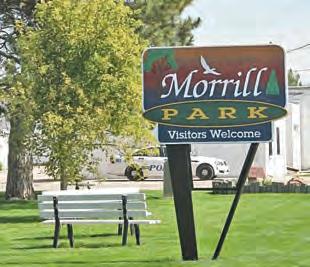


by TIM TRUDELL
ITTING ATOP A five-foothigh, chestnut-colored horse named Frank, 5-year-old Brock Waszgis holds tight for a physical therapy session that will help him gain balance. He holds a long mallet in his little hand, pulls it back slightly and swings it forward to knock a ball off an orange cone. For most people, it’s a game, but for Brock, this is one session of many at Heartland Equine Therapeutic Riding Academy (HETRA) near Gretna.
Wearing a helmet to protect himself, the Omaha youngster remains steady as a volunteer leads Frank, a 13-year-old Haflinger, slowly around an indoor arena. Two additional volunteers walk on either side of Brock to keep him steady. A therapist stands nearby, directing the activity.
Zigzagging through cones and grabbing discs off tall poles helps with Brock’s eye-hand coordination and muscle building, said Edye Godden, longtime chief executive officer of HETRA and an occupational therapist.
“It’s going to help us physically,” Godden said. “So, we know that when we ride a horse, we have to use our core a lot. We also know that the horse’s pelvis and our pelvis are similar. When a horse takes a step and is walking, it’s giving our body feedback, as if we were walking.”
his movement. Equine therapy has helped with balance and more, said Brandon Waszgis, Brock’s father. The youth is also on the autism spectrum and is nonverbal.
HETRA opened its doors in 1989 with one horse and three volunteers. Moving between area farms and stables over its first decade, HETRA found its first solid home base at Godden’s Valley farm in 1999. Godden became CEO and worked to grow the service.
ing with horses and clients at one time, as well ample therapy rooms and a stable for its 30 horses.
With a staff consisting of physical, occupational and speech therapists, and certified riding instructors, HETRA is open daily (except for certain holidays). It also relies on more than 26,000 volunteer hours each year, around 500 per week. Its 180 volunteers receive extensive training before being allowed to lead a horse. The organization attempts to pair clients with the same volunteers to provide a sense of stability.
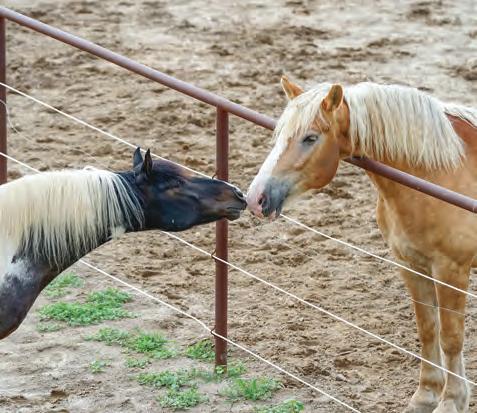
For the Waszgis family, this is much more than horseback riding. HETRA offers Brock an opportunity for an improved life. Brock was born with an underdeveloped cerebellum, which impacts
Realizing HETRA’s popularity as an equine-assisted services program, Godden knew the organization needed a larger area than her farm. Plus, she wanted to find a permanent home where the program could continue to grow.
In 2014, HETRA’s board of directors approved the purchase of a 25-acre farm with a large, existing arena. The arena gives HETRA enough room to have seven teams work-
The organization works with adults and children facing a variety of physical and mental health challenges, such as cerebral palsy, spina bifida, muscular dystrophy, cystic fibrosis, brain tumors, head or spinal cord injuries, visual impairments, autism, post-traumatic stress disorder and strokes.
“It’s similar to an outpatient clinic, where you work on sitting, balance, or crossing the midline or bilateral use of the hands or fine motor coordination, as well as gross motor coordination,” she said.
Horses add a unique aspect to therapy, Godden said.
“From a mental health or emotional standpoint, there’s a lot of connection between the horse and the rider,” she said.
“Horses are very intuitive animals, so they sense our energy. They’ve been trained to be desensitized to a lot of stuff because they might have a participant who is very loud or very active with their hands. We spend a lot of time not only training them
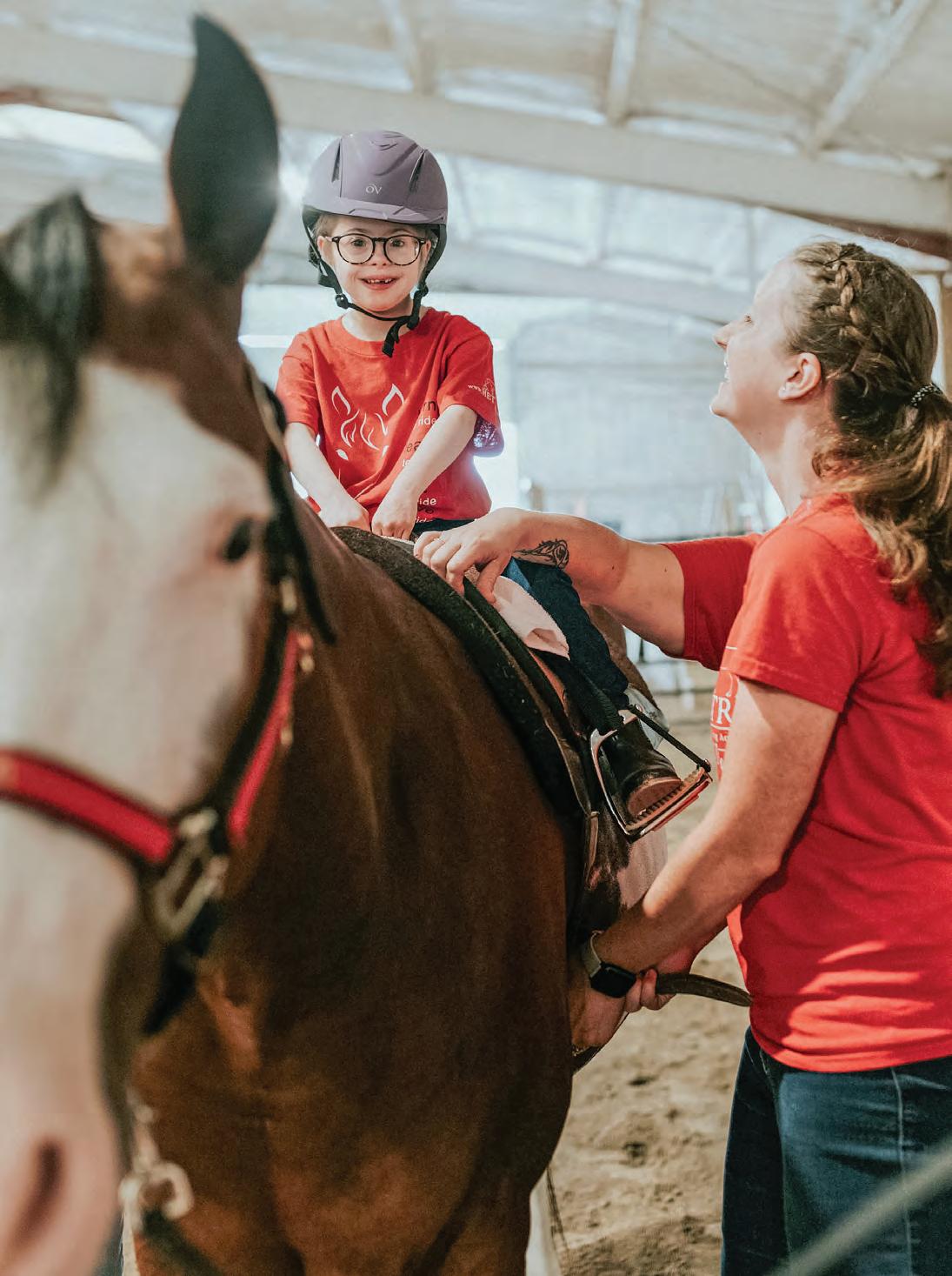
but conditioning them, so they’re set to do their jobs well.”
HETRA doesn’t want horses that are too young. Mid-to-upper teens are the perfect horses for the job, like Frank the Haflinger. While HETRA sponsors fundraisers to buy equines for the center, people have donated or loaned horses to the program.
But not all participants ride horses.
“I really like the ball drop activity,” Godden said. “We have the person write their daily roles, like mom, worker, daughter, and they carry these balls as they lead a horse. They drop balls as they navigate an obstacle course. So, we talk with them about how they feel when they drop the ball as a mom or other role.”
Besides riding horses, HETRA has four miniature horses that are used for grooming and leading sessions for people in wheelchairs. The miniatures are used for after school programs, as well as emotional learning programs, making more than 40 public appearances in communities from Fremont to Omaha last year.
Miniatures are also excellent resources for people who haven’t been around horses, especially people who are nervous and anxious around large horses.
Addressing participants’ anxiety helped Cooper Jorgensen, 18, overcome his fear of horses when he first visited HETRA in 2014, said his mother, Mary Jorgensen.
“The first day we came here, he wasn’t having anything to do with the horses,” Jorgensen said. “Edye had to literally put him on a horse. I was like, ‘Oh my, they’re not going to let us come back.’ She said to come back the next day.”
Godden first placed him on a smaller horse, but when Cooper saw Lady, he wanted to ride Lady. Lady became his favorite horse.
Cooper has gained confidence through equine therapy. Going from having a leader and two side walkers to riding solo, Jorgensen appreciates the help HETRA has provided her son, who has autism. Today, his best horse friend at the farm is Halo.
“They are a good fit,” Jorgensen said, “Halo just seems to get him.”
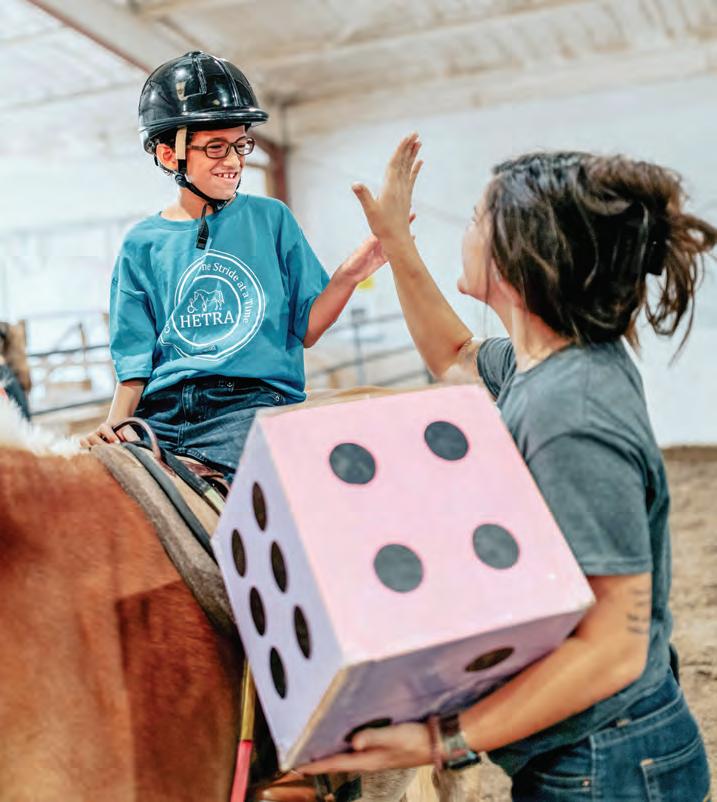
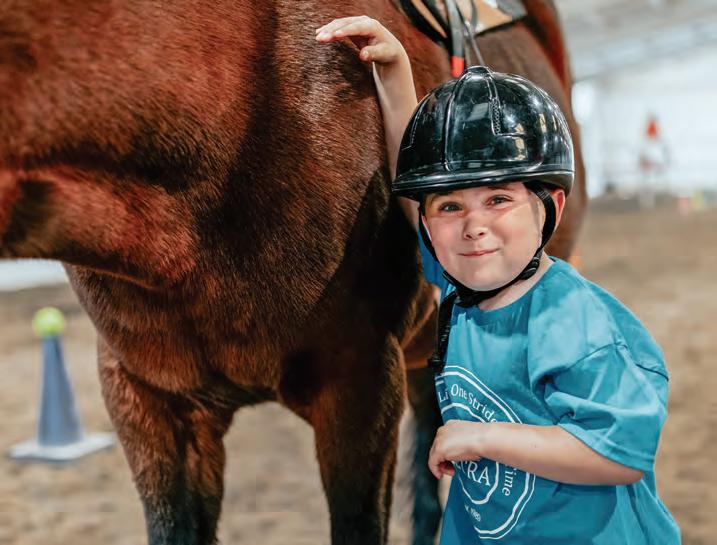

Horseback riding can improve balance, posture and core strength. Activities like throwing dice improves cognition as participants recall colors, shapes, numbers and sequences. Participants also work on their auditory skills while listening to the horse step across a “bridge.”
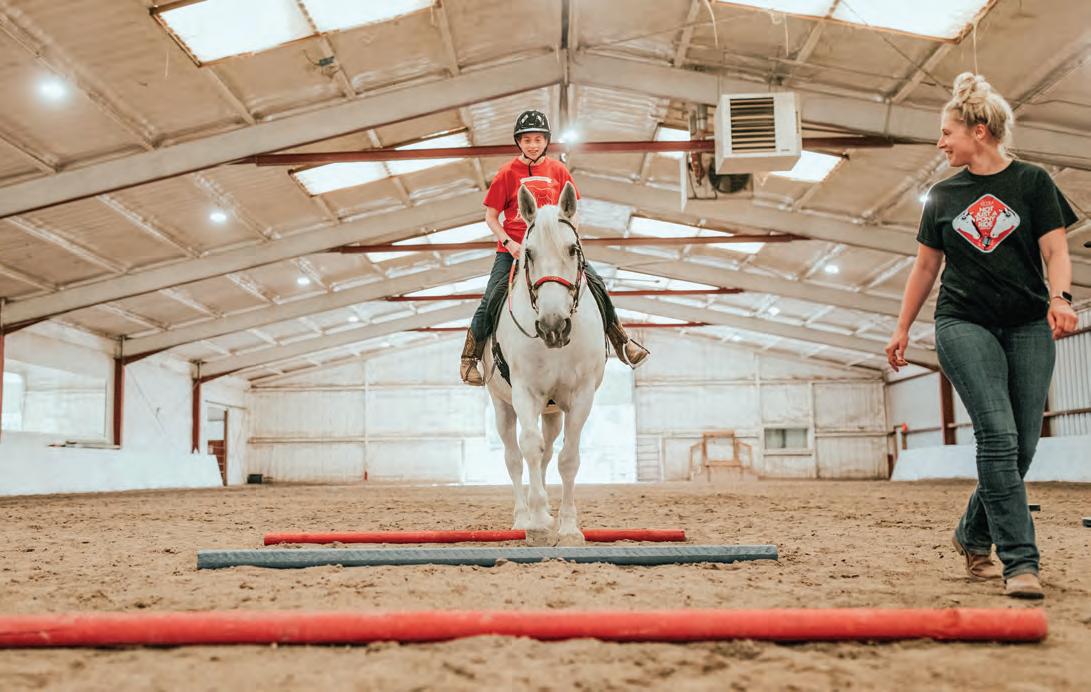
photograph by DERRALD FARNSWORTH-LIVINGSTON
LOOKING FROM SEVERAL hundred feet above the Missouri River valley in Northeast Nebraska, Derrald Farnsworth-Livington could see a distant farm – its silos, irrigation equipment and out-buildings.
Farnsworth-Livingston makes regular trips from his Omaha home to the overlook at Ponca State Park. As a photographer, he was particularly excited about the morning fog forming across the valley.
He had a picture in mind that he wanted to capture. He began watching nightly weather forecasts, hoping to hear that the next morning’s skies would be a mix of clouds and sun conducive to radiation fog forming over the valley.
Sure of the forecast, he arose at 3:30 a.m. and drove two hours to Ponca. The light was bright enough that he didn’t need a tripod to steady his camera and long lens. He varied the framing of the images and snapped off 500 shots before the fog burned off. He was confident that at least one would please his eye, and one did.
In his winning shot, he likes how the light filters through buildings and trees, creating layers of light, “the mist made golden by the rising sun,” he said.
This photo was taken with a Canon EOS 50D camera, equipped with 300mm 4/f lens with a 1.4x teleconverter at 420mm, exposed at ISO 200, f/8 for 1/500 of second.
SUBMIT YOUR BEST photographs for the opportunity to be published in Nebraska Life. Send digital images with descriptions and your contact information to photos@nebraskalife.com or visit nebraskalife.com/contribute.
